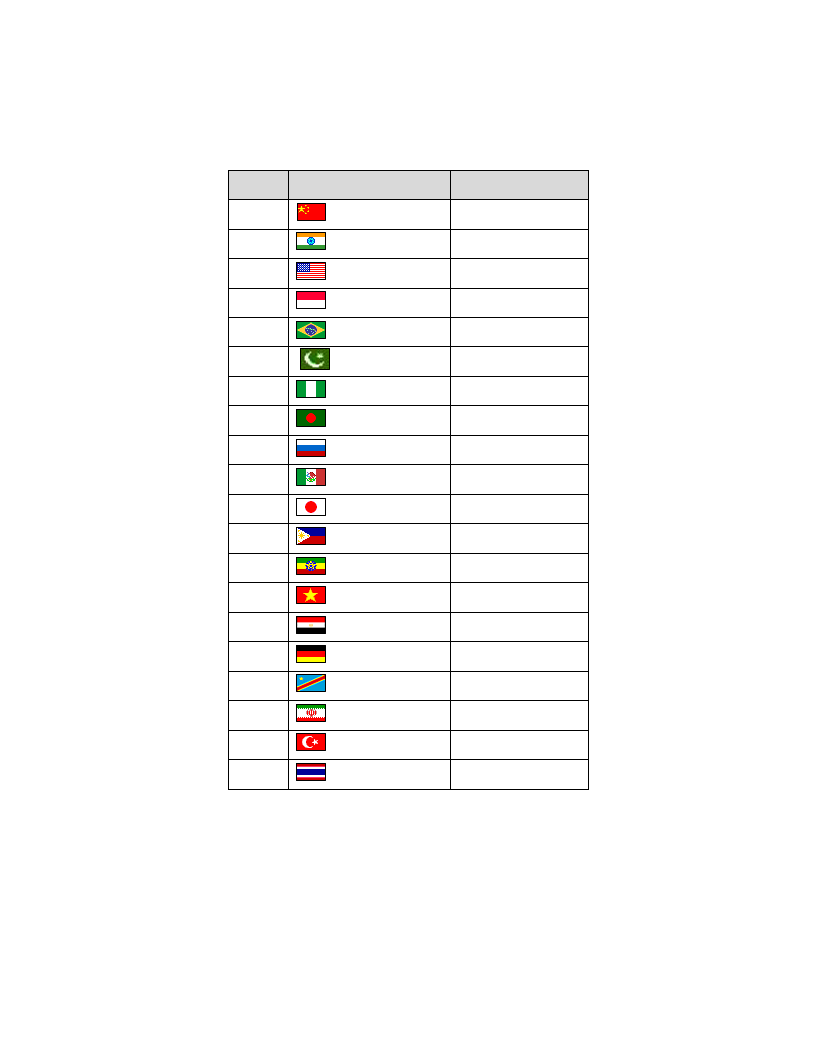
THE EFFECT OF ECOSYSTEM CONSCIOUSNESS ON
OVERPOPULATION AWARENESS – A CASE STUDY
A dissertation presented to
the Faculty of Saybrook University
in partial fulfillment of the requirements for the degree of
Doctor of Philosophy (Ph.D.) in Psychology
by
Susan H. Peacock
Oakland, California
February 2017

ProQuest Number: 10285148
All rights reserved
INFORMATION TO ALL USERS
The quality of this reproduction is dependent upon the quality of the copy submitted.
In the unlikely event that the author did not send a complete manuscript
and there are missing pages, these will be noted. Also, if material had to be removed,
a note will indicate the deletion.
ProQuest 10285148
Published by ProQuest LLC (2017). Copyright of the Dissertation is held by the Author.
All rights reserved.
This work is protected against unauthorized copying under Title 17, United States Code
Microform Edition © ProQuest LLC.
ProQuest LLC.
789 East Eisenhower Parkway
P.O. Box 1346
Ann Arbor, MI 48106 - 1346

© 2017 by Susan H. Peacock

Approval of the Dissertation
THE EFFECT OF ECOSYSTEM CONSCIOUSNESS ON
OVERPOPULATION AWARENESS – A CASE STUDY
This dissertation by Susan H. Peacock has been approved by the committee members below,
who recommend it be accepted by the faculty of Saybrook University in partial fulfillment of
requirements for the degree of
Doctor of Philosophy in Psychology
Dissertation Committee:
______________________________
Alan G. Vaughan, Ph.D., J.D., Chair
______________________________
Robert McAndrews, Ph.D.
______________________________
Marc Pilisuk, Ph.D.
_______________________
Date
_______________________
Date
_______________________
Date

ii
Abstract
THE EFFECT OF ECOSYSTEM CONSCIOUSNESS ON
OVERPOPULATION AWARENESS – A CASE STUDY
Susan Henshaw Peacock
Saybrook University
The purpose of this research was to investigate how knowledge of biological ecosystems
affects individual recognition of humanity as part of and subject to the laws of nature. This
dissertation interrogated the question of how awareness of the impact of human overpopulation
on the environment was perceived by research participants. That expanding human population
growth, and its inherent consumption patterns, is a root cause of virtually every human-related
environmental threat is documented in the existing literature but awareness and accountability
for this remain limited. Using ecopsychology and analytical psychology as a theoretical
framework, this multiple case study investigated how and whether environmental awareness
might be impacted by personal knowledge of how ecosystems function in nature.
A multiple case study design was used to interview 10 adults on their perspectives of the
environmental impact of human population growth. The participants were purposefully selected
creating two five-person groups. Group S had life-science academic training and work
experience; Group NS had none. A researcher-generated instrument of 30 open-ended questions,
with recorded interviews were used to ascertain participant understanding of ecological laws and

iii
population biology concepts and how they might relate to personal worldviews on the cause(s) of
environmental issues.
Thematic analysis was used to code data and identify response patterns. Findings
suggested participants with working knowledge of ecosystems demonstrated more extensive
understanding of the impact of human actions, including population growth, on the environment.
Although widespread awareness existed in both groups that human alienation from nature is
prevalent and is having environmental consequences, Group S subjects more often recognized
the systemic environmental effects of human activity. They were inclined to advocate for
individual responsibility and consciousness-raising.
Support for core concepts of ecopsychology is suggested by the findings. Strengthening
the human-nature bond to one of inclusiveness using experiential education is a viable option to
promote greater ecological awareness and personal accountability. Additional data-driven
research is needed to investigate the effects of life science literacy and holistic systems thinking
on pro-environmental awareness.

iv
Acknowledgments
This dissertation journey was one requiring much effort and steadfastness, and it
represented a significant part in the fulfillment of a long-term personal dream – to bring my
education to a postdoctoral level on a subject that is very important to me. There are those who
helped and supported me along the way, and I want to express my appreciation to them here.
I would like to recognize and thank my chair, Alan Vaughan, and the committee
members, Bob McAndrews and Marc Pilisuk, for their guidance and support. They were
available and kind and offered both creative ideas and encouragement. I was fortunate to have
them as my committee. I also want to express my gratitude to the ten individuals who agreed to
be interviewed for this study. They shared their thoughts and feelings with me, and I was
continually amazed at their insights and wisdom.
My sister, Courtney Holmes, deserves my deep appreciation as well. She encouraged and
supported me throughout the process and did much more than her share of family responsibilities
so that I could concentrate on my studies. She is a thoughtful and caring individual, and our
bond is very special.
Finally, I wish to acknowledge my dear husband, Al, for his love and help over the last
40 years, especially during this journey. Sharing my passion for education, he was my
unrelenting cheerleader – always willing to listen, offer encouragement, insights, and
suggestions. He never let me get discouraged - using his great sense of humor and tough love to
keep me going. He supported my dream, as he always does, to help me grow as a person.

v
Table of Contents
List of Tables ............................................................................................................................... viii
CHAPTER 1: INTRODUCTION ................................................................................................... 1
Purpose............................................................................................................................................ 2
Background ..................................................................................................................................... 3
Rationale ......................................................................................................................................... 6
Research Question ......................................................................................................................... 6
Researcher....................................................................................................................................... 6
CHAPTER 2: REVIEW OF THE LITERATURE ......................................................................... 8
Overpopulation as an Environmental Issue .................................................................................... 8
Awareness of Overpopulation....................................................................................................... 27
Barriers to Awareness ................................................................................................................... 32
Knowledge Barriers ...................................................................................................................... 33
Social Barriers............................................................................................................................... 38
Individual and Psychological Barriers .......................................................................................... 43
Theoretical Models ....................................................................................................................... 52
Interventions: Past and Future ...................................................................................................... 52
Ecopsychology.............................................................................................................................. 53
Ecopsychological Perspectives on Ecological Threat................................................................... 60
Historical Perspective of Jung’s Interest in Overpopulation as an Environmental
Problem Found His Collective Works and Other Sources....................................................... 65
Post-Jungian Interest and Scholarship on Overpopulation and
Ecological Problems ................................................................................................................ 71

vi
Core Concepts in Analytical Theory and Jung’s Writing Important to
Ecological Study ....................................................................................................................... 74
Summary ....................................................................................................................................... 86
CHAPTER 3: METHODOLOGY ................................................................................................ 89
Research Method and Rationale ................................................................................................... 89
Participant Selection and Demographics ...................................................................................... 91
Data Collection Methods .............................................................................................................. 94
Data Analysis ................................................................................................................................ 94
Research Ethics ............................................................................................................................. 96
Limitations and Research Issues ................................................................................................... 97
Summary ....................................................................................................................................... 97
CHAPTER 4: FINDINGS ............................................................................................................ 98
Summary of Themes ..................................................................................................................... 98
Summary of Individual Findings .................................................................................................. 99
Case Study Profiles ..................................................................................................................... 101
Discussion of Individual Findings .............................................................................................. 115
Identified Patterns or Themes ..................................................................................................... 127
Summary ..................................................................................................................................... 129
CHAPTER 5: DISCUSSION...................................................................................................... 130
Findings in Context to Existing Literature.................................................................................. 130
Conclusions and Recommendations ........................................................................................... 134
Limitations and Delimitations..................................................................................................... 135
Researcher Reflections and Summary ........................................................................................ 136

vii
REFERENCES ........................................................................................................................... 138
APPENDICES ............................................................................................................................ 147
Appendix A. World Populations and Regions ............................................................................ 147
Appendix B. Top 20 Largest Countries by Population as of October 31, 2016 ......................... 148
Appendix C. World Population Growth J-curve......................................................................... 149
Appendix D. Study Participant Demographics ........................................................................... 150
Appendix E. Saybrook University Informed Consent Form ...................................................... 151
Appendix F. Interview Questions ............................................................................................... 153
Appendix G. Interview List of Environmental Issues ................................................................ 155

viii
LIST OF TABLES
Table 1: Participant Sample Demographic Information ................................................................93

ix
LIST OF FIGURES
Figure 1A: World Populations and Regions ............................................................................... 147
Figure 2A: Top 20 Largest Countries by Population as of October 31, 2016 ............................ 148
Figure 3A: World Population Growth J-curve............................................................................ 149
Figure 4A: Study Participant Demographics .............................................................................. 150

1
CHAPTER 1: INTRODUCTION
This research study is a result of my lifelong interest in the exquisite natural environment
that has served as a home and resource for us as a species throughout our history. Intuitively, I
have always sensed that the complexity and the endurance of life were possible when supported
by a balanced ecological system. It is through an infinite number of diverse small parts, each
performing but not exceeding its individual role, that the whole is maintained and able to
survive.
Although many species have fallen fate to the effects of damaging the system that
sustains them, humans seem to be unique in their ability to consciously consider their thoughts
and behaviors. From a distant perspective, the lack of a coherent effort on our part to live in
harmony with the rest of nature seems unimaginably short-sighted and completely
counterproductive to our survival. Despite many warnings along the way, ranging from cultural
myths to scientific data, that we are consuming and populating far beyond sustainability levels,
we have been largely unable to develop the awareness and make the changes needed to live as
integrated parts of a world system with ecological limits.
This project is also an outgrowth of the training and knowledge I have been grateful to
receive in the biological and behavioral sciences. It is through these lenses that I have developed
a worldview that sees life as an ecological tapestry in which all parts must be respected. I
believe using psychology in conjunction with ecology to realize ourselves as parts of, not
separate from, the natural world, can only help awaken us to a higher consciousness of who we
really are. Because I believe strongly in the principles of ecosystems as synonymous with the
principles of life, my interest was in beginning an investigation into how an understanding of
these principles might affect one’s perceptions of the environmental challenges we face.
Interviewing a small group of individuals trained and experienced in one of the biological

2
sciences, and a second group who was not, allowed me to consider the similarities and
differences this type of education might make.
This chapter begins with a statement of purpose for this multiple case study supported by
a description of relevant background information. The rationale for this research and the
resulting research question are presented as well. Researcher information and identified
limitations and delimitations are discussed. Subsequent chapters present an in-depth review of
the literature including definitions of key terms, a detailed description of the methodology and
design, findings of the study, and a concluding discussion.
Purpose
The purpose of this qualitative research is to explore how a worldview shaped by training
and experience in the biological life systems impacts awareness of overpopulation as an urgent
environmental concern. Despite the amplifying effect that rapid and doubling human population
growth has on virtually every human-related environmental threat, discussions on the subject
have been strikingly absent, both in public arenas and in academic literature.
Failure to address this even while solutions are within our grasp has been attributed to a
massive number of psychological and social barriers to awareness, not a lack of scientific
knowledge. Mainstream psychology with its almost exclusive focus on personality, and not on
person-in-environment, has been ineffective in offering a theoretical framework for study. As a
new subfield, ecopsychology takes a holistic perspective that understanding at a systemic level is
necessary to transform one’s perspective of the self and one’s place in the world (Merritt,
2012b). Ecopsychology shares core concepts with both analytic theory and ecosystem theory.
All of these view the world as a living system that relies on diversity and balance to maintain

3
resilience. If the parts of the system are not mutually beneficial in interdependent relationships,
the system will not be sustained.
This research investigates a sample of persons who have a background in understanding
how natural ecosystems work as well as a sample who do not have this background to determine
if these differing perspectives affect ability to comprehend the environment threats directly
related to a species whose consumption and proliferation patterns are seriously taxing the planet.
This could contribute to general knowledge about the effects of a living system perspective.
Secondly, ecopsychology is seeking to develop and refine its purpose, to move beyond its
countercultural, Romantic, and experiential beginnings into an academically focused psychology
with empirically-based research (Snell, Simmonds, & Webster, 2011). With its emphasis on the
more subjective aspects of human relationships with the natural environment, ecopsychology is
well suited to qualitative research and the scholarship of teaching This study aims to contribute
to these goals.
Background
Anthropologists believe that the ancestors of Homo sapiens may have walked the Earth
as early as several million years ago while modern Homo sapiens may have appeared about
50,000 B.C. (Haub, 2011). According to the Population Reference Bureau (2015), world
population was around 5 million in 8000 B.C., the dawn of agriculture. In the 8,000-year period
until 1 A.D., world population grew slowly to 300 million people, reaching only 500 million by
1650 A.D. By 1800, however, after the start of the Industrial Revolution, living standards
changed and population numbers began to skyrocket, climbing from 760 million in 1750 to one
billion around 1800 (Haub, 2011).

4
Since that time, world population has grown explosively, especially in less developed
countries, doubling again and again. Due to the nature of exponential growth accelerated by
more changes leading to longer life spans and lower death rates, the world population has
exploded, with each addition of another billion people occurring in progressively shorter times.
A billion people were added between 1960 and 1975; a second billion between 1975 and 1987.
The current population of 7.4 billion has increased by a billion people just since 2004 and is
projected to reach 9.7 billion by 2050 A.D. (Population Reference Bureau, 2015).
In a landmark warning, more than 20 years ago, the Union of Concerned Scientists, an
international group of 1700 of the world’s leading scientists, many Nobel laureates in their fields,
issued a public statement entitled “The World Scientists’ Warning to Humanity” (Union of
Concerned Scientists, 1992). The report expressed their explicit concern that human beings were
on a collision course with the natural world and if many current human practices were not
fundamentally and urgently changed, the living world would be irreparably altered and unable to
sustain life in the world as we know it.
In addition to listing the atmosphere, water resources, oceans, soil, forests, and living
species as areas under critical stress, the warning statement identified the unrestrained world
population growth as an underlying cause in all of the world’s impending ecological disasters. In
their recommendations to humanity, the scientists urged the immediate stabilization of
population growth to prevent the catastrophic results of exceeding the earth’s finite limits (Union
of Concerned Scientists, 1992). Since that time, many other groups of scientists have issued
reports to try to bring attention to the mounting evidence that the world’s ecosystems are coming
under greater and greater stress.

5
Despite predictions about the dire effects of unrestrained growth on the world ecosystem
by Paul Ehrlich and others, the human population has continued to grow at an accelerated rate in
virtually every part of the world (Ehrlich, 2011). Tragically, after a brief time in the public arena
in the 1960s, the subject of overpopulation as an environmental concern all but disappeared from
the press and academia. It is theorized that the subject of overpopulation, as an easily
misunderstood and emotionally charged subject involving sex, reproduction, religion, culture,
human inequities, and freedom, is so sensitive and overwhelming that it is subject to being
ignored (Campbell, 2012).
There is a growing realization that the failure of any significant behavioral response to
the population crisis as well as other environmental issues has its roots in human emotional and
psychological factors, including political and economic ones (Metzner, 1999). In addition, many
writers in the field recognize that the efforts of mainstream psychology with its individualistic
and capitalistic perspectives have failed to suggest solutions for greater awareness and change.
What is especially ironic about overpopulation is that, unlike many of the issues that
confront us, solutions to this problem are already within our abilities. Martin Luther King (1966)
was a strong supporter of population control efforts and stated:
Unlike plagues of the dark ages or contemporary diseases we do not yet understand, the
modern plague of overpopulation is soluble by means we have already discovered and
with resources we possess. What is lacking is not sufficient knowledge of the solution
but universal consciousness of the gravity of the problem and education of the billions
who are its victims and the will to change. (Quotes)
Framed in Jungian core concepts and analytical theory, ecopsychology is uniquely
situated to offer help to humanity to move towards this universal consciousness. Ecopsychology,
as a developing field, focuses on resolving the alienation of humans from the nonhuman world
and even nature itself. Writers and psychologists in the field view re-education of humans to see

6
themselves as part of the world ecosystem, and therefore responsible to it and for it, as the only
viable way to produce transcending awareness.
Rationale
My rationale for conducting this study stemmed from my personal concern with what I
perceive to be an understudied and poorly understood source of environmental damage: human
population growth and its effect on the Earth’s ecosystems. Despite the efforts of the biological
sciences and the environmental psychologies, public consciousness and knowledge about the
impact of human-related activities on the environment remain low.
Ecopsychology, as an emerging field, takes its approach at a different level. Using a
foundation of analytical theory core concepts, ecopsychology focuses efforts on a conscious-
raising process where humans will see themselves as part of a larger world system, one to which
they are obligated and responsible. I believe the holistic concepts common to this discipline and
the ecological principles of ecosystems could be contributory to greater understanding of the
environmental issues. My rationale for this research was to determine how knowledge and
experience in the life sciences might affect awareness and understanding about human-related
environmental threat, especially human population growth.
Research Question
Based on my interest and rationale, my research question was formulated as follows:
How is awareness of human population growth as an underlying environmental threat affected
by understanding of the holistic principles of ecosystems?
Researcher
As is generally acknowledged in qualitative research, the skills and perspective of the
researcher affect the study in various ways (Braun & Clarke, 2006; Creswell, 2013; Robson,

7
2011). I would like to disclose my own background as it relates to the conduction of this study.
I have an undergraduate degree in biology and have had over 30 years of experience in
biologically-related fields. During these experiences, I acquired a thorough and working
knowledge of biological life systems and ecosystem functioning. In addition, I am a long-time
member of numerous ecology-related organizations and stay informed on current environmental
issues. I also have a master’s degree in social work and have practiced in this field for
approximately 10 years with a diverse client base. In this work, I learned interviewing techniques
and good listening skills. My present efforts in studying psychology reflect my interest in the
human psyche and soul. Each of the elements of this background offer something that I was able
to use in this work.
At the same time, I acknowledge that these same experiences could bias my judgment
regarding the questioning of interviewees and interpretation of findings. To address bias that I
might have, I tried to construct questions that were non-biased and asked the same questions to
two different groups of interviewees. In interpreting the results, I performed an extensive
analysis of responses that considered all responses, not just averages. Finally, I engaged in
critical self-reflection by journaling and discussing my approach with a colleague.

8
CHAPTER 2: REVIEW OF THE LITERATURE
In order to develop a rationale for this study, it was necessary to review the published
literature for what is known about the topic of human overpopulation as a global environmental
and social problem. The review examined the psychological literature to identify reasons for the
known gaps between knowledge of an ecological threat and failure to act in proenvironmental
ways. Literature studying the barriers to awareness of overpopulation as a common denominator
to many human-related ecological problems, and the reasons for scarcity of the subject as a topic
of discussion and research were also included as part of this review.
A review of the literature describing the course of ecopsychology as an evolving field
was also performed. Because of the incorporation of many analytical theory core concepts into
ecopsychology, Jungian and post-Jungian literature is an integral part of the literature. Holistic
principles common to both analytical thought and laws of ecosystems were identified.
Overpopulation as an Environmental Issue
Definitions
The term overpopulation, as it is generally used, refers to the situation occurring when
the needs of the group members living in an area that they depend on to provide essential
resources exceed that area’s ability to provide these resources and to replenish itself. There must
be a balance between the two entities for the system to remain in equilibrium and support the
population on a sustained basis.
In order to define human overpopulation, scientific attempts to quantify the impact of
human activities on the whole ecosystem have been made. Ecologists have developed the terms
ecological footprint and biocapacity to describe the two sides of the balance sheet (Global
Footprint Network, 2003). Biocapacity is the ability of earth areas to be biologically productive

9
as well as handle the waste generated. Areas that are barren, lack fresh water, stripped of
resources or built-up are not described as having this capacity. The ecological footprint of an
individual, a nation, or humanity is derived by comparing the demand that a species places on
nature’s resources to its ability to supply that demand. Measurements like this are inexact at best
and subject to criticism by those demanding exactness. However, in systems as complex as
human activities, trends are sometimes more important than precise measurements. The trends
of increased consumption by more people and the progressive depletion of resources are
undeniable. In one study examining data since 1961, Toth and Szigetti (2015) compared
population growth rates, gross domestic products (GDP), and ecological footprints (EF) of
different countries and the world and found that while world population tripled between 1950-
2006, GDP, as an indicator of consumption, increased nine-fold. In addition to monitoring the
individual and collective footprints, which are rightly focused on consumption, ecologists remind
us that the footprint of any individual can never be zero as every individual is a consumer.
Another term used in calculating human population and consumption impact is earth overshoot.
According to scientists at the Global Footprint Network (GFN) (2003), in the mid-1970s, a
critical threshold was crossed where human consumption began outstripping what the Earth
could provide. The overshoot model uses a budget analogy to illustrate the growing deficit of
our ecological spending and the data collected tells us that it would take 1.5 Earths to provide the
current level of demand for its resources and services. This deficit is maintained by liquidating
Earth’s resources. GFN (2003), representing 62 countries, calculated a calendar date each year
when humanity has used up the resources it takes the Earth a full year to regenerate. This date,
called Earth Overshoot Day, has moved from early October in 2000 to August 13th in 2015.

10
Global Demography and Trends
Although concern about overpopulation is ancient, for most of history human population
increases have always been kept in relative balance by corresponding death rates (Population
Reference Bureau, 2015). Beginning approximately in the 18th century, however, advances in
industrialization, agricultural technologies, and disease control have gradually lowered death
rates worldwide, while birth rates remained nearly the same overall. At the same time the
population was growing, resource consumption in industrialized nations began to skyrocket.
Population growth trends and demographic data are compiled by a number of
organizations. Data extracted from the recently published 2015 report, 2015 Revision of World
Population Prospects, are presented in a table format in Appendix A (Zlotnik, 2015). In this
report, the United Nations (U.N.) revised its future world population projections upward and
higher than previously predicted. Now, according to its projections, the current world population
of 7.3 billion is expected to reach 8.5 billion by 2030, 9.7 billion by 2050, and 11.2 billion by
2100. The table in Appendix A also shows the higher population densities occurring in the
developing countries and especially the least developed countries. These trends are expected to
continue while populations of developed countries expected to remain at a more consistent level.
A breakdown of population and population predictions by continent shows the greatest growth
rates continuing in Africa and Asia.
Population growth by countries is also tracked by world population organizations, often
with a live feed. Appendix B lists the 20 top largest countries by population growth.
(worldometers reference??) In 2015, China, India, and the United States were the world’s most
populous nations. Growth between 2015 and 2050 is expected to be most concentrated in nine
countries: India, Nigeria, Pakistan, Democratic Republic of the Congo, Ethiopia, Tanzania, the

11
United States, Indonesia, and Uganda (Mirkin, 2014). China’s population growth rate is
predicted to slow, removing it from the list of fastest growing countries. The rapidly changing
positions of the most populous countries reflect the widespread nature of population growth.
The current U.N. report (as cited in Mirkin, 2014) represents a significant shift from its
previous reports on the issue of global population. Higher than expected growth prompted the
U.N. to alter its degree of concern and focus on human population growth as a primary
environmental concern. At the beginning of the new millennium, the U.N. released a list of
millennium development goals (MDGs) in September 2001. These were eight critical areas that
needed to be addressed by 2015; all of these targets were adopted by all 189 member states
(Redding, 2007). The MDGs included areas such as eliminating poverty, reducing child
mortality, and empowering women. Despite its integral relationship with the stated goals,
reducing population growth was not even mentioned as part of the agenda. Critics and analysts
of the MDGs speculated that feminist and human-rights factions centered on women’s rights
worked actively to prevent talk of stopping growth or reducing average family size (Foreman,
2012). Ironically, many feminists and social activists have served to undermine population
stabilization efforts by negatively associating it with reproductive health and ethical violations
(Weeden & Palomba, 2012).
The report also released data confirming the continuation of long-term global population
demographic trends. Although fertility rates are in decline in some developed countries, this is
most often off-set by a decrease in mortality, altering the balance between births and deaths that
is necessary for a population to stabilize. In these countries, those aged 60 or above are often the
fastest-growing demographic segment. In the least developed countries without basic services,

12
including family planning and women’s rights, there has been a larger than expected increase in
the number of unanticipated births.
Another continuing trend described in the U.N. report (as cited in Mirkin, 2014) is the
world’s increased urbanization. The more than half of the world population currently living in
urban areas is expected to rise to two-thirds by mid-century, most of which will be concentrated
in the poorer countries. In addition, the amount and patterns of immigration from less to more
stable countries are expected to increase as people are displaced or relocate. For example,
political upheavals in the Middle East, Africa, and South Asia are reshaping migration trends in
Europe. Writing for the Council for Foreign Relations, Park (2015) stated that the International
Organization for Migration has estimated that more than 464,000 migrants and refugees have
crossed into Greece and Italy by sea in the first nine months of 2015, creating a crisis in the
social systems of the receiving countries. Due to the population numbers of the migrating
countries, this crisis is expected to continue without resolution.
In the report conclusion, the U.N. warned that these population dynamics will have
developmental consequences. Most of the direct consequences described such as provision of
housing, education, medical care, and food and water, involve inadequate or unequal resources
for larger numbers of people. More indirect consequences of the increased population trends
include effects to the labor force, human rights, immigration pressures, and failed government
states.
Overpopulation Impact
In the 2000 U.S. Geological Survey, released by the U.S. Department of the Interior,
geological scientists outlined 10 global challenges documented by research that had been directly
linked to human population activity (Groat, 2000). These included: inadequate and contaminated

13
water, hazardous weather, uncontrolled urban growth, emerging diseases, invasive species,
adverse climate change, exceeded natural material lifecycle, obsolete infrastructure, damaged
oceans, and poor air quality. The growth of global population was cited in this report as the
underlying cause impacting all these environmental threats.
Perception of the scope of population’s impact is affected by the false debate over
whether overpopulation or overconsumption is the real problem. Crist & Cafaro (2012) stated
the reality clearly, “The ecological crisis is the consequence of the consumption patterns of a
huge and growing human population” (p. 5). In a game of projection and blame, little attention
has been given to the fact that both the rich and the poor have different kinds of environmental
impact. One view contends that overconsumption in the global North is largely responsible for
the biosphere’s degradation, and certainly the destructive reach of high consumption patterns is
global in scope. The exclusive focus on this ideology masks the detrimental effects of
population growth itself, especially in the global South where population is growing most
rapidly. The destructive reach of the poor tends to be more local in its effect. Deforestation,
rampant extermination of animals, overgrazing, overfishing, unchecked pollution, and birth rates
are a few of the environmental issues related to mass numbers of people consuming (Crist &
Cafaro, 2012). While it is important to recognize and reduce consumption, it does not negate the
impact of population as a multiplier of consumption (Campbell, 2012).
The explosion of humanity’s numbers dramatically affects many other nonhuman species
as well. Recent quantitative research studies at Brown University concluded current extinction
rates are 1,000 times higher than natural background rates of extinction, and future rates are
likely to be 10,000 times higher (De Vos, Joppa, Gittleman, Stephens, & Pimm, 2015).
Environmental changes due to human actions are considered the major source of these patterns.

14
Endangered species biologist Wintrop Staples III is among those questioning the
anthropomorphic perspective of seeing the Earth as a resource only for humanity without
acknowledging other species’ right to exist (Staples & Cafaro, 2012).
Scientific Evidence
Most of the evidence that overpopulation exists is documented in the scientific literature
of the physical sciences. Research consistently supports the view that the world is overpopulated
and that humankind as a species has dangerously overconsumed natural resources to the extent
that other parts of the ecosystem are affected. In November 1992, a scientific statement from
1,700 of the world’s leading scientists, including many Nobel laureates, issued a landmark public
statement (World Scientists’ Warning) to humanity that the current course, if unchecked, places
the living world as we know it and the survival of human society and plant and animal kingdoms
at risk (Union of Concerned Scientists, 1992).
Since then, other groups of scientists have continued to try to deliver the message to the
world that the Earth’s ecosystems are being stressed to the point that a state shift is imminent.
State shifts are biological events that occur when ecological systems reach critical transitions
caused by threshold effects (Barnosky et al., 2012). In 2012, Barnosky and other integrative
biologists published another alert that these shifts are known to shift abruptly and irreversibly
and have global-scale impact. The scientists urgently suggest concentrating all efforts on the
true root causes of the mounting ecological crises: human population growth and consumption
rate.
Most recently, the World Wide Fund for Nature (WWF) (2016) published their Living
Planet Report 2016 with the most comprehensive analysis to date on biodiversity loss. The data
indicates that the world is on track to lose two-thirds of its wild animals by 2020. According to

15
the report, this is part of a mass extinction of the natural world caused by the destruction of wild
habitats, hunting, and pollution related to population pressure. In the report, WWF Director
General Marco Lambertini (2016) spoke to this relationship when he stated:
The evidence has never been stronger and our understanding has never been clearer. Not
only are we able to track the exponential increase in human pressure and the constant
degradation of natural systems, but we also now better understand the interdependencies
of earth’s life support systems and their limits. Lose biodiversity and the natural world
including the life support systems as we know them will collapse. We depend on nature
for the air we breathe, water we drink, the food and materials we use and the economy we
rely on, and not least, for our health, inspiration and happiness. (p. 6)
Physicist Kuo (2012) has published more than 70 articles in international research
physics professional journals explaining why overpopulation is the source of other global
problems. In her field, she has explained that there is evidence to show that food and water
resources are already insufficient to meet the needs of the present global population of seven
billion. To illustrate the unsustainable path of resource usage, Kuo explained that, according to
the World Water Council, more than 11 million people have died from drought alone since 1900,
1.1 billion people lack access to safe drinking water, and more than one billion are going hungry
across the world today. These conditions are most pervasive in the countries where the
population is densest and resources are limited. Rapidly increasingly consumption by industrial
nations is an inseparable twin to the increasing population dilemma. As an energy systems
specialist, Kuo has explained that for a continuous growth system based on capitalism to
function, the system must use more and more energy and resources, continually expanding its
markets by persuading more and more customers that they need more and more products and
services. When this model is occurring in a bounded system, like the Earth, the growth cannot
grow indefinitely.

16
Evolutionary Trends
Evolutionary scientists have also studied the increase in human population growth. In
their research, Toth and Szigeti (2015) calculated humanity’s ecological footprint from 10,000
B.C. until 1960 using historical statistics to correlate growth rates using per capita GDP with
ecological footprint (EF). By all indicators, growth patterns have dominated not only since the
Industrial Revolution but also throughout humanity’s development. Interestingly, however, they
found that rates of growth and environmental degradation, although both trending upward, were
not always linear with population numbers. Asymmetric jumps and leaps in the GDP/EF ratio
during economic paradigms legitimizing growth, especially from the late 18th century, led the
researchers to conclude that population growth is a less important driver of EF than
consumption.
Offering another evolutionary perspective, Woolfson (1999) studied the past thousand
years of human development and believes that human worldviews have created the ecological
problems, and only changes in worldview can restore what has been lost. He concluded that
humankind is at an evolutionary crossroads for human survival and changes in societal world
views, value systems, and beliefs could likely lead to human long-term survival. Woolfson
noted that the emerging worldview must recognize and incorporate that man’s human nature is
both good and evil, man is the guardian of nature, man is motivated by self-interest as well as
altruism, man is a part of life, not separate from it, and earth’s resources are limited and finite.
Woolfson’s research does not address suggestions for changing world views.
Other researchers have proposed ways that human population growth and technology, in
addition to altering global ecology, is affecting future evolutionary trajectories. Evolutionary
change accelerated by human-induced growth patterns is being observed in other species around

17
us, especially disease organisms and pests. With the ability to evolve and mutate quickly,
bacteria, viruses, and other microorganisms adapt to the use of drugs and chemicals in such a
way as to render the substances ineffective. The effects of this change can be seen economically
as well in exposure to uncontrollable outbreaks of pests or disease. Palumbi (2001) theorized
that larger numbers of humans, especially living in crowded conditions, are significantly
affecting the natural selection process of evolution. David Attenborough (2013), a naturalist and
wildlife commentator, has been harsh in his words for humanity’s oversized effect on other
species that have less ability to adapt, thereby affecting evolution: “We are a plague on the Earth
and either we limit population growth or the natural world will do it for us, and the natural world
is doing it for us right now” (p.1). Attenborough cited climate changes and drug-resistant
diseases as examples.
Other writers see the extinction of the human species as consistent with the laws of
nature. In her book, The Sixth Extinction, Kolbert (2014) described her work with eminent
scientists who are tracking humanity’s transformation of our globe. She described a clear pattern
of mass extinctions throughout the earth’s history where the diversity of life on earth suddenly
and dramatically contracted. Each time, massive weather or geological events triggered
extinctions that destroyed 60-70 percent or more of the living species. During the end-Permian
event, about 250 million years ago, more than 90 percent of marine, insect, and ancestors of
mammals perished through an inability to adapt to the changed conditions.
This time the catalyst for the mass extinction is the human race with its pollution,
predation, and habitat destruction, and scientists are already monitoring its course by rapid
extinction of other species (Kolbert, 2014). Though the present rate of biodiversity loss is far
below these numbers, scientists estimate the present extinction rate in the tropics to be about

18
10,000 times greater than the naturally occurring rate. If die-offs continue at this rate, some
scientists estimate the current extinction event could reach previous magnitudes in 240 to 540
years. In the case of the human species, Kolbert wrote, the path to extinction is fast-forwarded
by our restlessness, intellect, and appetites, but it is an inevitable path.
Political Influence
Anthropologists and archaeologists who have studied the success and failures of past
civilizations have contributed to the current study of overpopulation and overconsumption. The
evidence of what has happened to previous societies when presented with environmental
challenges can be instructive. In his book, Collapse, Diamond (2005) stated that when
civilizations fall, they share a sharp and sudden curve of decline. He found in his research that a
society’s demise may begin only a decade or two after it reaches its peak population and power.
He suggested the full-fledged collapses of the Anasazi and Cahokia in the United States, the
Maya cities in Central America, Moche and Tiwanaku societies in South America, Mycenean
Greece and Minoan Crete in Europe, Great Zimbabwe in Africa, Angkor Wat and the Harappan
Indus Valley cities in Asia, and Easter Island in the Pacific Ocean were due at least in part to a
fatal inability to deal with environmental crises. Diamond (2005) listed deforestation, soil and
water problems, overhunting and overfishing, human population growth, and increased per-
capita impact as some of the factors involved.
In many cases, Diamond (2005) believed the society’s demise was accelerated when the
leaders of these civilizations failed to practice long-term thinking and make courageous decisions
even after problems had become perceptible. When driven by personal interests over courage,
the leaders became more and more myopic and moved to crisis-management of small problems,
while simultaneously overlooking the larger picture until it was past the point of no return.

19
Other scientists in this field questioning the reasons for these collapsed societies have identified
resource overshoot by the population and demands by the elite that exceeded peasant tolerance or
capacity to produce (Tainter, 2006).
Political historians have observed the impact of overpopulation and overconsumption on
a society as well. Public policy researcher Goldstone (2006) noted that there are numerous
examples in history where increased crowding and lack of resources were the cause of
population-related conflict. The need for lebensraum or living space was a justification for
Adolf Hitler’s expansion campaign, which resonated with the growing and resource-deprived
German population. Japan, an island nation with high population density and limited resources,
adopted a strong history of imperialism, such as invading China and other parts of the Pacific, as
a result of its need for additional resources (Redding, 2007).
In recent years, the term fragile/failed states has been used by the World Bank and other
international organizations to describe those countries that lack the capacity or the will to deliver
core state functions (Redding, 2007). These states are said to have similar problems and
common among nearly all failed political states is high population growth. In 2007, the World
Bank listed 34 countries as fragile states with an average total fertility rate (TFR) of 5.1 percent.
Many such as Afghanistan, Angola, Burundi, Chad, D. R. Congo, and Sierra Leone have a TFR
of more than 6.5 percent. Fragile states also tend to have younger populations, and political
stability is at risk when population growth creates a spike in the number of young adults who
lack jobs and cannot meet their basic needs. Globalization has increasingly created a world
where stable countries are no longer isolated from unstable neighbors, and conflict can easily
spread across borders, threatening global security.

20
Foreman (2015) confronted some of the political issues that perpetuate population
problems in his book, Man Swarm. He believed, despite the far-ranging political ramifications
of overpopulation, it is a subject that many politicians avoid discussing. Politicians from both
sides of the political spectrum ignore overpopulation to pander to their bases, avoid cries of
discrimination by failing to consider immigration patterns, and retreat from ideas that certain
religious and cultural beliefs may be incongruous with our survival as a species.
Population itself can become a political issue. Governments may support higher birth
rates as a means of accessing more land, political power, or votes. Religious and cultural
institutions can also have an agenda in promoting more population growth in a world that is
already bursting at the seams. In his book, Countdown, Weisman (2013) stated, “Like Yasser
Arafat’s womb-weapon and the overbreeding of Israel’s haredim, the Church has a fundamental
vested interest in bodies” (p.133).
Economic Influence
The population dynamics of a single country can vary independently of global population
dynamics. A nation’s population size must also be considered in relation to its environmental
impact. Although the fertility rate in the United States is lower than many countries, the average
rate of 2.06 births per woman plus a high level of migration to the United States make it the third
most populous country in the world (Bish, 2012). What is perhaps more significant is the
excessive ecological footprint of America. Bish (2012) described the endless growth economy
that has been packaged and exported throughout the world by the United States. This brand of
capitalism relies on greater and continuous consumption and produces unsustainable amounts of
waste.

21
The capitalist economy is fueled by population growth. In order to maintain its existence,
production is dependent on the demand of more consumers needing more things and services to
be produced by more people involved in the production process. It is intrinsic to the
contemporary brand of capitalism to promote rapid population growth, both by increasing births
and encouraging immigration. Throughout the world, transnational corporate powers
subscribing to this economic system support that which promotes increased marketability.
Environmental and moral concerns for the earth and other people become collateral damage in
this pursuit.
Population Organizations
An increasing number of governmental and private non-governmental organizations
(NGOs) have come on-line to study and report on population issues. The U.S. Census Bureau is
a leading source of U.S. and international population statistics and research (U.S. Department of
the Census, 2015). Current and past population numbers are maintained along with breakdowns
into many demographically distinct characteristics. The site also posts population projections up
until 2050 based on historical trends. The United Nations (U.N.) global website has much less
extensive population data, possibly reflecting the degree of attention the organization gives to the
issue. It is telling that in September 2001, when the U.N. adopted its MDGs, outlining critical
areas to be addressed in the upcoming millennium, population growth was not included
(Redding, 2007).
The Population Institute (PI) is an example of a very active international non-profit
organization studying population. Their focus is on gender equality and family planning
promotion. The Institute conducts research on the known effects of overpopulation and writes
literature targeted towards increasing awareness in policy makers and journalists. By monitoring

22
trends, the researchers there have observed the ability of some countries to lower their rapidly
rising population growth. Tunisia, Egypt, Indonesia, and Mexico are some of the successful
countries that by implementing family planning as a routine part of health care have stabilized
their populations and seen increased stability and economic security as a result (Redding, 2007).
PI also corrects and revises earlier models as new data are received. For example, earlier
predictive models anticipating a decrease in African fertility rates have been discredited by a
large increase in the continent’s population (Fischetti, 2014). PI and others like it also report on
literacy rates, poverty levels, and maternal and infant mortality in countries with different rates
of population growth.
Other researchers use statistics for predictive purposes. With the population level
growing by 1.3 percent per year and industrial activity by 3 percent, Barter (2000) is a researcher
agreeing with World Bank projections for the future. He considered that, despite lower fertility
levels in a few countries, global human population will increase by another 50 percent in the next
40 years. Each nation is making its own contribution to the problem. Although birth rates in the
United States fell for several years, population growth now soars by three million a year, due
mainly to immigration and the higher birth rates of immigrants. All nations are increasing their
economic activity while China and India are joining the United States as the major industrial
polluters. If this path continues, Barter has predicted a catastrophic nuclear-age war will be
inevitable. He believes there is ample historical precedent that the politics of envy will continue
to grow among the have-nots, some of which have the means and the desire to destroy those who
have what they envy.
Leading conservationist and global visionary at the Rewilding Institute, Dave Foreman
(2015) cast a dim look at the effects to the world order that overpopulation of the human species

23
is having on Earth’s wildlife. He has taken a cautiously optimistic view that humans will be
resourceful enough to reverse this world order as more and more understanding develops.
Despite the unknowability of the future, I believe that the direr predictions and the historical data
based on trending are more likely than those requiring leaps of faith.
The United States
I want to devote a section of this chapter specifically on the United States to focus on its
unique problems. Though far from true for everyone, many people in the United States have
enough to eat and a place to live. Other than traffic and crowded stores, overpopulation seems
more like a concern for other countries. I have spoken with many people in this country who
respond to a question about overpopulation with a comment like, “A lot of third world countries
have that issue but it’s not something we have to worry about here.” The United States is unique
in its pattern of continued population growth. Demographically, the nation’s population has
grown from 76 million in 1900 to 325 million in 2014, making it the third most populous country
in the world after China and India. In 2000, 40 percent of that growth consisted of post-1900
immigrants and their descendants. (Population Reference Bureau, 2015).
Lindsey Grant, former Deputy Assistant Secretary of State for Environment and
Population Affairs and a foreign-service officer to China, has written extensively about how the
population growth rate in the United States will drive its future. He explained that the United
States, being sparsely populated until well into the twentieth century, had more space to absorb
the damage of population and consumption (Grant, 1996). Looking at three vital areas, Grant
(1996) explained why the American position of confidence may be short-lived. Whereas U.S.
agriculture is still self-sufficient in meeting its own needs, its continued role as the residual
granary for the world for the near future is less assured. The amount of arable land per American

24
is on the decline, being lost to development; grain yields have been stagnant for more than a
decade requiring more chemical fertilization; top soil is being lost to erosion at a deficit; and
sustainable farming practices are unrewarded, favoring gross output of monocultures and
subsidies. U.S. supplies of water are diminishing with drought and greater use, especially in the
agricultural states of California and the plains (World Water Council, 2012). Finally, the United
States is the world’s major consumer of fossil fuels. Oil, gas, and coal are non-renewable energy
sources, and the government struggles to develop alternate and sustainable sources.
With an increasing population, U.S. society and its infrastructure are under increased
stress. The costs of needed infrastructure repair related to usage in this country are estimated to
be more than three trillion dollars (Grant, 1996). As urban areas grow, competition for housing
and services grow, and these conditions are frequently in decline. We console ourselves about
joblessness by watching the government’s unemployment rate but this number does not begin to
tell the whole story. This percentage measures only active job applicants, not the discouraged
job-seekers who have stopped looking. People who have become alienated or defeated may not
appear in the unemployment rolls but may appear on the crime rolls instead. The costs in ruined
lives are incalculable. Grant (1996) also observed that when the push for productivity is being
driven upward but demand does not meet supply, more people lose their jobs. This pattern
results in the familiar unstable economic pattern of the rich-getting-richer, the poor-getting-
poorer, and the middle class feeling increasingly strained.
Opposing Viewpoints on Overpopulation
There are, of course, opposing opinions not only on the risk of overpopulation itself but
on what should or can be done. The two major dissenting viewpoints that I found in the
literature were from (a) a religious perspective and (b) a technological perspective.

25
Austin Ruse is the president of the Center for Family and Human Rights, a research
organization dedicated to the defense of the family at international institutions, monitoring of
socially radical policies at the U.N., and fidelity to the teachings of the Catholic Church. Ruse
has written on a variety of social topics, including his belief that overpopulation is a myth. He
maintains there is plenty of food and resources for the world’s population and that the
overpopulation myth was created by those who would selectively promote one race over another
and coerce birth control or abortion. He has said that world population is in decline and the real
danger is in the aging of populations. Ruse has conducted no research of which I am aware but
has stated that his theory can be tested by looking outside an airplane window when one is
flying: “What you will see is a remarkably empty planet straining to be made a garden by more
of us” (as cited in Balkin, 2005, p.31). As a scientific observer, I am only able to assume that
these are the views of a person so enmeshed in his beliefs that objectivity is lost. Certainly, there
have been those who agree with overpopulation as a problem that have drawn erroneous
conclusions and proposed unethical solutions but the evidence is overwhelming that the
environment is being destroyed by the overburdening of its resources. Humans are unique in
many ways, but they do not defy the laws of nature.
The American Enterprise Institute (AEI) is a center-right pro-business think tank whose
research is dedicated to issues of government, politics, economics, and social welfare. One of
the AEI scholars, Nicholas Eberstadt (2007) shared his viewpoint by writing that scientific
discoveries and technological developments will allow human beings to solve the problem of
overpopulation. He denied that the idea of exceeding the Earth’s carrying capacity will be a
problem for humans because humans are unlike all other species and can use their problem-
solving techniques to escape the fates of other species. He selectively cited higher life

26
expectancies and lower infant mortality in some countries as his proof that this is true. Further,
he has said that fears about overpopulation have been disproven repeatedly in the past. He does
not mention what he means by disproven but he may be referring to more catastrophic
predictions.
As an example of human ingenuity and technological optimism being able to solve any
problems, Eberstadt (2007) referred to the Green Revolution where the development of new
wheat grains and agricultural practices like pesticides are said to have prevented one billion
people from starvation. A better perspective on this comes from Dr. Norman Borlaug, the actual
father of the Green Revolution. At the acceptance of his Nobel Prize in 1970, Borlaug stated,
“we are dealing with two opposing forces, the scientific power of food production and the
biologic power of human reproduction. There can be no permanent progress in the battle against
hunger until the [two forces] unite in a common effort” (as cited in Weisman, 2013, p. 57-58).
Borlaug further explained that his work had merely bought the world another generation or so to
solve the overpopulation problem. He maintained this perspective and served on the boards of
population organizations for the rest of his life.
A prominent conservative political writer, Wallace (2009) posted a blog for CentreRight,
a conservative British website, in response to the release of a United Kingdom public opinion
poll favoring a smaller world population. He denounced organizations that study population
growth and its effects as “having open contempt for human beings and advocating for the
removal of real human beings who live, love and laugh (para. 2). Wallace reported that people
are perfectly happy with the status quo and want to “continue breeding (para. 9). His views, as
well, are not based on any research.

27
Awareness of Overpopulation
History
Dating back to 1798, Thomas Malthus, British clergyman and intellectual, warned
society of the exponential growth of population that, if unchecked, he felt would inevitably result
in massive food shortages. Malthusian theory has been criticized and largely discredited by those
who believe his ideas were pessimistic and socially biased. Malthus was simply not aware of all
the impacting factors that would influence his predictions; however, his “Essay on the Principle
of Population” brought forward the connection between resource supply and population growth
(Brown, Gardner, & Halweil, 1999), and we have expanded our awareness of how a myriad of
resources such as water, forests, disease, and air quality are impacted by population growth.
Modern neo-Malthusians, like Paul Ehrlich and Thomas Keynes, based their ideas on the
theories of Thomas Malthus but expanded their beliefs to include other resources besides food as
being vulnerable to unabated population growth (What is the definition, 2016). The neo-
Malthusians are enthusiastic proponents of birth control.
Since the publication of Rachel Carson’s book, Silent Spring, in 1962, scientists have
been documenting worsening threats to all aspects of the biosphere (Koger & Winter, 2010).
Population as an environmental stress has been considerably less discussed or even
acknowledged. In the 1960s and 1970s, after Ehrlich’s The Population Bomb was published,
increased attention was paid to the world’s rapidly growing human population. In 1960, global
population stood at three billion. By the end of the century, this number had doubled to six
billion and, if following the growth pattern of exponential growth, could double again later this
century. But in spite of this astronomical growth, media and policy attention all but disappeared
in the 1980s and 1990s. The silence on overpopulation was deafening and resulted both from

28
neglect and open hostility towards raising the issue. Population and the need to control its
growth touch every sensitive human subject. Sex, reproduction, culture, religion, morality, and
global inequities are just a few of the areas that contribute to its controversial nature and why
awareness about it is so compromised.
In 1993 in New Delphi, a summit of representatives from the world’s scientific
academies met and concluded that humanity was reaching a crisis point of irreversible
degradation of the natural environment if zero population growth were not reached within the
lifetime of the children currently living. The following year, the International Conference on
Population and Development (ICPD) met to discuss related issues but was sidetracked into
alternate agendas and did not even address overpopulation (Weeden & Palomba 2012).
Family planning funding was recommended by both groups but has not kept up with the
need. The proposed 2005 budget of $5.2 billion to be collected from developing country and
developed country donors yielded $0.5 billion instead. As always, poorest families suffer most.
In 1998, the African rich found ways to limit family size but the fertility rate of the poor
remained unchanged at 20 percent, with an increase of unwanted pregnancies rising from 11
percent to 21 percent (Potts, 2007). The population of 870 million in sub-Saharan Africa is
expected to grow to 1.8 billion in the next 39 years (Ehrlich, 2011).
Population Silence
Population has a long history of being notably absent from the discussion table of
environmental threats. Using a random sample of 150 articles on urban sprawl, water shortages,
and endangered species, Maher (1997) showed that only about one in 10 articles framed
population growth as an ecological stressor and source of the problem. Further, only one story
mentioned stabilizing population among the realm of possible solutions. The discussion of

29
population growth also seemed to be missing from concern about housing prices, energy
shortages, and oil exploration efforts and other topics related to the law of supply-and-demand.
Behind the taboo of discussing overpopulation, sensitive factors, such as race, birth control,
religion, and individual freedom, have been identified (Campbell, 2012).
For example, most Americans do not want to feel that they are prejudiced against people
of another race and because a global overpopulation discussion invariably includes the subject of
race, the discussion is avoided. The fact is that birthrates have little to do with race and rather
reflect economic opportunity, shortage of resources, and loss of land but, nevertheless, this topic
is also avoided. Currently, immigration to the United States is the highest in its history – 1.5
million per year or 44 percent of the annual growth rate. The United States is already
overcrowded with diminishing resources, and this level of immigration cannot help but diminish
the standard of living for all. In fact, it is more often the affluent and educated persons of other
countries who are capable of immigrating to the United States. This leaves those in the country
of origin still struggling with their problems while creating a brain and resource drain that makes
matters worse. Many Americans want to avoid this discussion, too, as it interferes with their
cultural perception of America as open and fair to all.
The sensitive topic of birth control also contributes to the silence on overpopulation.
Many religious Americans perceive using birth control as an act against the word of God. Others
equate discussing the freedom to use birth control as synonymous with abortion. One of the
world’s largest religions, the Catholic Church, has played a substantial role in perpetrating the
silence on overpopulation.
The first mission of virtually every population organization is to aid in the prevention of
pregnancies, not in their termination, but this is not distinguishable to some people. Nothing in

30
the Bible specifically prohibits birth control and preventing pregnancies, rather than their
termination, is the first mission of virtually every active population organization. For some, the
Biblical statement attributed to God to “go forth and multiply” is often quoted as divine intent
that humans should multiply without reserve. This is placing the statement out of context
because this phrase was a standard greeting of the time to wish others abundance. It also fails to
take into account the many statements present in the Bible that direct man to care for the earth
and all its inhabitants.
Discussing overpopulation also touches on concern about the loss of personal freedoms.
Fears of coercive population control are triggered with memories of dark events in our history
when population control efforts were selectively based on certain populations. These were tragic
abuses of power assuming the form of concern for overpopulation. In 1979, China imposed a
political decision on families to limit reproduction to one child without addressing related
individual health and women’s issues. As with many politically-mandated decisions, there have
been many unforeseen consequences such as demographic imbalances, violence, and female
infanticide. Many studies have shown that when people have better education and control over
their lives, they tend to have fewer children voluntarily which is ethically sound (Guttmacher
Institute, 2015). It is also a legitimate perspective to consider that personal freedoms can be
seriously curtailed under conditions of greater population density.
Campbell (2012) has studied the history of population growth in the last 200 years and
what she has identified as the reasons for the silence is creating what she calls the perfect storm
for public inattention. First is the visibility of birth rate declines in some countries. Since
increased survival rates have driven growth far more than higher fertility rates, the current
declines are of minimal consequence in the total picture. Another factor for a lack of public

31
awareness on overpopulation is focus on the patterns of overconsumption, a more visible factor.
While it is important to recognize and reduce consumption, it does not negate the impact of
population as a multiplier of consumption. For example, the waters of the Nile River are
becoming seriously depleted; this is due to the booming population growth in the countries
surrounding it. Thirdly, anti-abortion activists, religious leaders, and conservative think tanks
have been actively diverting attention from population growth as a problem. Campbell believed
that the AIDS epidemic and other urgent threats also reduced attention on the need to reduce
births and provide family planning.
Many feel that the turning point in removing the subject of population from policy
discourse was the 1994 United Nations International Conference on Population and
Development in Cairo. The strategy adopted at Cairo to focus on women’s reproductive health
counterproductively associated family planning with government-driven coercive population
control and avoided drawing any attention to environmental destruction. This position
effectively destroyed any meaningful global discussion on the empowerment of women to reduce
fertility by choice. The opportunity to understand family planning as a means of liberating
women from domestic and cultural coercion and a means to escape poverty, prevent death from
unintended pregnancies and induced abortions, and strengthen their own and their children’s
well-being, was lost (Campbell, 2012).
Psychology’s Role in Raising Awareness
In many ways, our environmental problems, including overpopulation, are human
behavior problems (Takács-Sánta, 2007). The role of science is to observe and describe the
natural events that are occurring. Substantial scientific evidence has been collected and
distributed. But we know that information only serves a purpose if it is heard and used, and there

32
is even more evidence that the public is not hearing this message and using it for behavior
change. Working as an anthropologist in water resource management, Anderson (2001) believed
that environmentalists often focus exclusively on economic self-interest as the only human factor
involved in retarding pro-environmental behavior. Because humans are as much moved by
emotion and mood as reason and frequently distort information in predictable ways, Anderson
stated that environmentalists need all the help possible from psychologists.
Oskamp (2000) has written extensively advocating the role psychology must play in
addressing human-caused environmental, including overpopulation, problems. He traced the
root causes of all environmental problems to overpopulation and overconsumption.
Psychologists must learn how awareness can be created that will lead to meaningful risk
assessment of overpopulation and appropriate actions. Oskamp also believed it is the work of
psychology to promote human welfare, and psychologists must lead the way in helping people
adopt sustainable patterns of living. He suggested six motivations for psychologists to promote:
voluntary simplicity, specific corrective actions, clear behavioral norms, focus of technology on
better efficiency, effects of organized group activity, and sustainable living as a universal goal.
Barriers to Awareness
Types of Barriers
Barriers to awareness are plentiful and pervasive. How well they are recognized and
addressed is related to the presence of environmental concern, which is correlated to pro-
environmental behavior. In general terms, one group of barriers is related to the obtaining of
information on environmental problems and the other to the mental appraisal processes used to
appraise severity, probability, responsibility, and coping (Takács-Sánta, 2007). In the following
section, I have categorized the barriers mentioned in the literature into those related to receiving

33
knowledge, those that affect us at a social or group level, and those affecting us as individuals.
These are somewhat arbitrary divisions as there is considerable crossover in many cases.
Knowledge Barriers
Mathematical Principles
Environmentalist Alan Kuper (2004) wrote a thoughtful essay in the journal, Free
Inquiry. He noted that the vast majority of people in the world never even consider if the world
is overpopulated and the fact that the human population is over seven billion and could double in
this century means little. Few even know the population of the globe or their country and do not
understand why they should. No one has ever told them why it was important that if enough
couples have more children than to replace themselves, population will grow like compounding
money in the bank and build to unimaginable numbers.
Albert Bartlett, professor of nuclear physics and a forerunner in overpopulation study,
wrote that many people lack numeracy, the mathematical equivalent of literacy, or the ability to
understand how mathematical concepts apply in life. The ability to comprehend exponential
growth is, as he put it, “one of the greatest shortcomings of the human race (Bartlett, 2012, p.
33). The time required for anything to double in quantity is its doubling time. If a population is
growing at 7 percent and the mathematical equation of exponential growth is applied, it is found
that this population will double in 14 years! What many people do not realize is that what seems
like a modest growth rate can quickly produce enormous increases in just a few doubling times.
Another surprising principle is that the growth in any one doubling time is greater than the total
growth of all the preceding doubling times. Bartlett (2012) was so concerned about these facts
that he wrote a lecture in 1969 called “Arithmetic, Population, and Energy” to educate people
and gave it 1,742 times throughout his life.

34
Bartlett (2012) also tried to explain sustainable growth is an oxymoron. The idea that
sustained growth of any material thing in a finite world is possible only serves to placate those
who wish to deny or do not understand exponential growth. Through human history, population
has been trending upward. The growth during early doubling times appears very small but as the
number of doubling times increase, plus death rates decrease, population growth graphs take on
the familiar ascent of the J-graph. An illustration of the growth of world population throughout
history is shown in the graph in Appendix C.
Lack of Scientific Understanding
In 2011, Weber and Stern studied the continued polarization of U. S. public opinion
against acceptance of climate change when there is plentiful accumulated scientific evidence to
support its existence. They concluded that public awareness and understanding is affected by
difficulty in conceptualizing climate change as a physical phenomenon. It is complex and
requires non-conventional modes of conceptualization. It is not a single, visible hazard caused
by easily definable causes, and its relationship to climate history is uncertain. Many
nonscientists do not grasp the impact of the scientific data, for example, effects of an increase of
0.5°C.
Also, unlike scientists taking measurements and making observations, nonscientists must
typically rely on second hand sources and personal experience to develop their understanding.
Second-hand sources are primarily media events that can be more concerned with showing
opposing sides and breaking news than unbiased truth. New information technologies with their
floods of information can make it difficult to critically review what is being presented. Once
established, these mental models may not be revised as readily as ongoing scientific collection of
data. Scientific methods use multiple methods and build understanding over generations. Any

35
conclusions are in constant review. Nonscientific data is more swayed by extreme and changing
events, and uncertain events are often given a value of good or bad.
Biological Laws of Living Systems or Ecosystems
For the impact of population growth to be understood, knowledge of certain physical and
mathematical principles must be considered. The biological laws of living systems explain the
means whereby the systems sustain themselves. By the interrelationship of complex parts,
growth existing in balance with death, and adequate renewal of resources, homeostasis is
maintained and the system is sustainable (Watson, 2012). These principles, identified in
observations and research in biology and medicine over centuries, seem to apply to all types of
self-regulating biological systems. This includes the human psyche which is in indissoluble
union with the body (Jung, 1969b, para. 232). The central premise is that for a system to remain
stable, its interrelated parts must balance each other with balanced cycles of creation and
destruction. Whether it is cancer cells, economic growth or population numbers, any part of the
system with uncontrolled growth will eventually destroy the system by direct damage or
insufficient resources. Scientists at the Global Footprint Network (GFN) (2003) estimated that
the Earth began to operate at a resource deficit beginning in the mid-1970s, and the deficit is
being maintained by liquidating Earth’s resources at a rapid rate.
The principles that govern living systems are no less true than those that govern non-
living systems. They are, however, less well known and much less appreciated. These laws
guide natural ecosystem functioning and are known as the laws of ecology (Ikerd, 2013). When
a population grows out of balance, it is not obeying these laws. The following is a description of
the three primary principles.

36
Holism. The first principle of ecosystems and sustainability is holism. The parts and the
whole of a living system are so connected that each have properties that disappear when they are
isolated. When these relationships change, the whole is changed. If a system is complex and
connections are strong, like a biological or social one, ignoring the principle of holism can have
critical consequences (Ikerd, 2013).
Diversity. Another essential principle of sustainability is diversity. The resilience needed
for a living system to renew and regenerate comes from nature’s diversity. Without diversity,
organisms cannot adapt to change. An ecosystem that has been stripped of its resources will not
sustain its populations (Ikerd, 2013).
Interdependence. For a life system to keep perpetuating, it must have interdependent
relationships. In this type of system, relationships are mutually beneficial; the output of one
process is the input for others. Relationships that are not interdependent can be exploitive and
limiting. Humans do not always appreciate that they are dependent on nature and think that
nature can be controlled. I have personally seen an automobile bumper sticker that addresses this
position of overconfidence: “Nature Bats Last.”
Laws of Ecology
As founder of Greenpeace, Captain Paul Watson is an outspoken activist for environment
causes and overpopulation. He is also knowledgeable on the laws of ecology. His writing to
explain these laws is very relevant to the overpopulation issue. The laws of ecology are (a) the
law of diversity, (b) the law of interdependence, (c) the law of ecological niches, and (d) the law
of finite resources. Briefly, the law of diversity states that the integrity and strength of an
ecosystem depends on the diversity of its species within the system. The law of interdependence
means that all species are dependent on all other species in the system. The ecological niches

37
law means that each species has a role to play in maintaining the integrity of the system. The
law of finite resources states that there is limited growth that can occur in a system, and any
species that exceeds its carrying capacity will lead to an imbalance and loss of resilience in the
system. Watson (2012) wrote that no species can live outside of these laws in a physical, living
world. He was unconcerned with political correctness when he wrote our only hope of survival
is to reduce our population numbers drastically and immediately without waiting for the solution
that offends no one.
Lack of Resources, Education, and/or Interest
There are many people in the world who lack the resources to know what scientific
research has learned about overpopulation. They are so involved in meeting their basic needs
that they have neither the time, materials, or interest to consider the future. In the foreword to
their book, The Psychology of Environmental Problems, Koger and Winter (2010) acknowledged
that as members of the privileged class, they have the luxury to consider these larger questions of
survival. Throughout my research, I have found this to be the case—people are so caught up in
managing their daily existence that they have only enough energy to focus on the here-and-now.
Often those who have the most to lose are the most compromised in this way.
Lester R. Brown (1995), founder of the Worldwatch Institute, studied global population
throughout his career. It was his observation that countries with rapid population growth
continually struggled with social issues like educating children, finding jobs, and coping with
environmental consequences to a greater extent than countries without this type of growth.
Further, when new threats inevitably arrived, the impact of that new threat more easily
overwhelmed their social systems, and they were less able to cope. For example, the presence of
the HIV virus, although a threat to all countries, was decimating to many countries in Africa.

38
Some of what is interpreted as greed is the behavior of victims of circumstance.
Anderson (2001) noted that Americans often do not take public transit to work because it is not
available to them. To this point, he added the plight of the Maya Indians he lived with as well as
hundreds of millions of other impoverished rural cultivators around the world. They know full
well what the effects of their overcutting, overhunting, and overusing resources will be but they
cannot stop because they are living on the edge of starvation and are blocked from most avenues
of possible change.
Social Barriers
Social Norms and Conformity
It is well known that peer influence can be a significant force in affecting other people’s
awareness and choices. In his latest project, known as the Millennium Alliance for Humanity
and the Biosphere (MAHB), Paul Ehrlich has emphasized the role of the social sciences in
environmental change. As a more than 50-year activist in human-based environmental damage,
he wrote that what has puzzled scientists most is why the public and media are not responding to
reports of impending ecological crises. Ehrlich (2011) said, “We are learning that if you want to
get people to understand and do something, you convince them that their neighbors are doing it.
What matters are social norms” (p.4). The real work now is to use the social sciences to
understand and change human behavior.
Ehrlich (2011) also felt a vast culture gap is responsible for the gap between available
information and action. In his time spent living with the Inuit, he remembered that every
member of the group had a basic knowledge of their common culture: “Even if you weren’t
responsible for fishing from the ice, you knew how to do it and why it needed to be done” (p. 6).
In our splintered and heterogeneous culture, there is little common basis for understanding. The

39
relative lack of understanding we have about our collective experience as a species affects our
awareness as well (Mora, 2014).
Childbearing is an important behavior to mention. It is a deeply ingrained social norm as
well as a biological act. Having a large family is considered one’s own choice, and there is a
great deal of public and political support and sympathy for those who do so. Being a parent is
considered a worthwhile source of identity in our society while a couple who choose to remain
childfree may be regarded as selfish or odd. In addition, we are a youth-oriented culture that
gives preference in many ways to the young.
Using system justification theory, Feygina, Jost, and Goldsmith (2010) proposed that the
widespread denial and resistance to take pro-environmental actions is related to the human
motivational tendency to defend and justify the societal status quo in the face of threat. This
greater adherence to justification of the system could explain the lower levels of challenging the
system associated with political conservatism, nationalism, and gender bias. Their research
found that it is possible to reverse or eliminate the resistance to pro-environmental change by
encouraging people to regard the changes as patriotic and consistent with maintaining the status
quo.
Nationalism is a social factor affecting a society’s ability to challenge its own beliefs and
make change. In the West, especially, nationalism is related to the pre-existing belief we have in
the stability of natural systems and the historical belief we have in perpetual progress.
Nationalism also makes it easier to disavow guilt and personal responsibility for the actions or
inactions taken in the name of the country. According to Weber and Stern (2011), the denialist
movement in the United States about climate change stemmed from the views held by an
individualistic capitalistic nation.

40
Anderson (2001) reviewed research on the behavior of individuals in groups to consider
the prospect of groups working on environmental problems. He found that hostility between
groups could cause members of a group to destroy a mutual resource for reasons of retaliation.
In one example, ethnic Chinese and Malays engaging in group hatred led to the destruction and
collapse of a fishery so that neither was able to use its resources. In his review of 59 studies,
Gifford (2000) concluded that individuals in a group use resources more wisely when the group
is small, communicates well, and is informed that the resources are limited. Unfortunately, the
groups that share real-world resources have none of these characteristics.
Leadership and Politics
A reduced public interest in overpopulation makes the need for leadership critically
important. Unfortunately, it is a topic that most political leaders prefer to avoid. More than a
billion people live in extreme poverty under dire conditions, and ecosystem species are being lost
at a rate seen only in mass extinctions. Mora (2014) conducted a review of recent studies
showing how the issue of population growth has been trivialized and downplayed as a political
agenda, resulting in almost a complete lack of policy action.
There are a few notable exceptions. After the death of Imam Khomeini in 1989, the
Iranian minister of health launched a new national family-planning program. Doctors and
university teams took to the streets, traveling on horseback to every little village to promote
voluntary reduction in the numbers of children couples chose to have. Women were asked to
space their pregnancies three to four years apart, bear children between the ages of 18-35, and
have no more than three children. Any kind of birth control was provided free of charge.
Everywhere they went, women expressed desire for fewer children and to better educate those
they had. There was no coercion and the only government disincentive was the elimination of

41
individual subsidy for any child after the first three. The program succeeded beyond anyone’s
expectations. By 2000, Iran’s total fertility rate had gone from 4.0 children per woman to 2.1. In
addition, a 1975 literacy rate of less than 33 percent in younger Iranian women had gone to 96
percent, and one-third of government jobs were held by women. Twelve years after the program
began, the Iranian health minister would accept the U.N. Population Award for the most
enlightened and successful family program the world has ever seen (Weisman, 2013). Thailand
saw a similarly impressive drop in population growth—from seven children per woman to two—
after a government program made contraceptives widely available and distributed, reducing the
number of births by 16.1 million between 1972 and 2010 (Weeden & Paloma, 2012).
Women’s Reproductive Choice
The level of global population growth has an obvious relationship to women’s
reproductive choices. There is considerable evidence to show that when women have the
freedom to think about their own and their children’s well-being, they are concerned about
having more for the children they have, not more children (Engelman, 2012).
Research of self-reported data also supports that more than 40 percent of pregnancies
worldwide are unintended. In 2012, for example, 41 percent of the United States’ 213 million
births were unplanned and unintended (Guttmacher Institute, 2015). Engleman (2012) asked the
question, “What would happen to world population growth if every pregnancy worldwide were
the outcome of a woman’s active intention to bear a child?” (p.234). Studies suggest that
providing safe and effective contraceptive options to all sexually active women who do not want
to become pregnant would end the problem of world population growth without fear of coercion.
The long-standing belief that it is “natural” for couples or women to want many children
and its inferred corollary that they have to be induced to want smaller families is challenged by

42
this type of study (Campbell, 2012). David P. Barash, an outspoken sociobiologist at the
University of Washington, believes that much of what is touted as a biological drive to have
children is actually the result of extensive cultural programming (Barash, 1986).
Religion
Although a source of spirituality and strength to many, rigid adherence to some religious
doctrines can bring about learned helplessness that prevents awareness and behavior change.
People who believe that every occurrence is “God’s will” may only try to adapt, not change. In
his interview with Weisman (2012), Iman Raidoune stated, “To reduce or stop producing
children on the presence of difficulties feeding them goes against a pact between Muslims and
God. Allah has promised to provide for all the children” (p.233). Cardinal Turkson has seen
enough African suffering and starvation in his country to understand what living conditions with
more people can mean, yet his Church insists there is room for everyone and that it is a
punishable sin to use effective means to prevent the addition of more (Weisman, 2012). His
Church maintains that artificial contraception is sinful and immoral and may frustrate a divine
plan to bring a new life into the world.
Economic Growth Models
Regarded as the most successful model for growth, capitalism is the economic system
used in most developed countries and envied by many more. Belief in and use of this system
promotes continuous consumption, competitiveness, self-interest, and, often, greed. Its
inseparability from technology perpetuates an unrealistic belief in the ability of technology to
solve any problem. Technology can create additional problems or more serious problems than it
solves. Some anthropologists, such as Diamond (2005), believe that maximum environmental

43
impact played a significant role in the sudden decline of some advanced societies such as the
Maya, Anasazi, and Easter Island, when the limit where impact outstrips resources was reached.
Individual and Psychological Barriers
Individualistic Perspective
The narrow construal of self that individualistic societies, such as the West, have can
impose a barrier against global problems that require a unified effort. It is difficult when the ego
function predominates to take the position of opposing the other, especially if the other is a
nonhuman entity such as nature. When the self is not seen as part of a larger system like nature,
concern for and responsibility to the system is not forthcoming. Individualistic individuals make
choices primarily based on personal needs (Takács-Sánta, 2007). This perspective ranges from
protecting one’s self-interest to outright narcissism and can vary with one’s life stage.
On the Earth Day of the millennium, ecologist professor Gifford (2000) addressed the
cumulative negative effect of individuals on the environment, often by the well-intentioned. As
an example, he cited the flights of 80,000 people to Seattle to protest the World Trade
Organization (WTO) for environmental disregard. The actions of that many people in their
admirable pilgrimage actually sapped tons of energy and released vast amounts of carbon
dioxide into the air. According to Boeing’s website, a commercial 747 uses approximately one
gallon of fuel every second and over the course of a 10-hour flight might burn 36,000 gallons.
The failure of individuals to understand or consider the result of their single action or cumulative
actions with other individuals is a major factor in why we continue to damage the environment
even as we think we are protecting it—a tragic irony.
Gifford (2011) reviewed environmental psychology research from the preceding 30 years
and identified ways that individuals, mostly unconsciously, damage the environment every day.

44
In our energy choices, we drive when we could walk, fly when we could drive, and drive when
we could teleconference. How much fossil fuel will be consumed is usually not part of our
decision-making process. We routinely make decisions based on convenience as well. Also,
many decisions are literally made in ignorance. Most people do not place their daily behavior
choices in an environmental context. Every parent’s personal decision to have a child results in
significant environmental destruction, whether it is realized or not. I believe that the lack of
individual awareness of the impact that a single individual can make, especially when combined
with 100 or a million other individuals, contributes to our inability to see ourselves as part of and
able to affect the larger system.
Defense Mechanisms
The question of how people split off awareness so that they do not have to experience
anxiety is well-researched in the defense mechanism literature. Three principles underlie the
mechanism of preventing conscious awareness: much human behavior is shaped by unconscious
motivation, conflict is chronic and painful, and humans use defense mechanisms to contain their
anxiety against unwanted thoughts, feelings, and desires (Koger & Winter, 2010). In addition to
concerns about our personal selves, Macy (1995), in her work on environmental despair, wrote
that we have apprehensions of the collective suffering that destruction of our environment will
have. As a society, we are caught between a sense of impending apocalypse and the fear of
acknowledging it. Environmental threat is among the most primal of threats, raising fears about
our very existence, even a type of maternal abandonment.
As a coping style, defense mechanisms are used outside of conscious awareness. They
can alter the relationship between self and object, altering perceptions of external and internal
reality and other facets of cognition. Of the different classes of defense mechanisms, those in the

45
disavowal class seem the most relevant for defensiveness against environmental issues (Vailiant,
2000). Denial, projection, and rationalization allow people to separate themselves from anxiety
and guilt about impending ecological crises. In addition to psychic relief, these defenses reduce
awareness of and response to changes in reality.
Opotow and Weiss (2000) have studied three types of denial based on moral exclusion
that are used against environmental conflict. If one’s moral orientation is based on exclusion,
unwillingness to act in the best interests of others, including the Earth, is characteristic. Denial
of outcome severity, stakeholder inclusion, and self-exclusion allow the individual or group to
minimize or conceal outcomes, label dissenters as outsiders or extremists, avoid taking
responsibility, and blame the victim. A moral orientation of inclusion would be more likely to
promote environmentalism and interest in working together.
Research on just-world theory has demonstrated that individuals often subscribe to a need
to believe in a just world. When that belief is challenged, they commonly use defensive
responses like denial or rationalization to try to resolve the threat. Dire messages about
approaching environmental disasters can cause them to deny factual evidence. Just-world theory
researchers recommend the importance of using less dire messaging and pairing findings with
potential solutions (Feinberg & Willer, 2011). Of course, decreasing message severity can
promote greater denial as well. The tendency of humans to believe in positive illusions,
especially about the future, is also documented in the literature. Anderson (2001) has studied
this in individuals and bureaucracies during his management of natural fisheries. Statements like
“there are lots of fish – it’s just a bad year” or “it won’t hurt to take just one more” exemplify the
rationale of unwarranted optimism. He explained his view that optimism can feel great until it
kills you.

46
Related to defense mechanisms is defensiveness. Often, people have a defensive reaction
when their existing practices are threatened. The users of a threatened resource often react so
strongly that they take emotionally extreme measures when negotiation seems the better choice
for all concerned. Conservation workers have been killed and plants and animals destroyed for
illogical defensive reasons (Anderson, 2001).
Psychological dissonance, as defined in psychoanalytic theory, occurs when there is a
conflict between an instinctual demand and its prohibition by reality (Koger & Winter, 2010).
The resulting tension can sometimes be managed by the use of a defense mechanism but often at
a price. According to Sapiains, Beeton & Walker (2015), a dissociative experience is created by
the tension between people’s awareness of environmental problems, including overpopulation,
and their non-sustainable practices. The researchers theorize that to deal with the conflicting
tension between these conflicting positions, people perform the behaviors that are likely to give
them psychological relief rather than any effective action.
Blindness and Apathy
Blindness, an alternative term to denial, is sometimes found in psychological literature to
express the unwillingness of individuals or groups of individuals to “see” what is clearly before
them. Conservation biologists Orr and Ehrenfeld (1995) used this term in their article about
ecological denial. The way people choose to shun reality is through “the willful dismissal or
distortion of fact, logic, data, and evidence in the service of ideology and self-interest” (p. 985).
A U.S. Congress attempting to dismantle needed environmental regulations contrary to all
scientific evidence is engaging in this type of blindness. Strategies to avoid facing reality
develop: focus on small nits, avoid big issues, and demand an unattainable level of proof. By

47
establishing double standards of proof and drawing unwarranted inferences from disconnected
pieces of information, blindness is maintained.
In one study, Howard (1993) interviewed his university students about their willingness
to change their future plans to help the environment. He found that most respondents who were
educated about the risks to the environment of overpopulation stated that their own personal
fulfillment was tantamount to any concern about the Earth. They expressed their intent to act
according to their own self-interests. One student suggested that there were three categories of
people with views about the environment: (a) those who will sacrifice all personal pleasure to
save the world, (b) those who deny the data, and (c) those who know the state of the world but
will continue to live as they wish. Howard proposed that the psychological dynamics in this
thinking does not represent denial but would be better described as self-deception, stemming
from the separate bracketing of concern for our species and the right of individuals to pursuit
happiness.
Research has shown that individualistic motives can blind people to the fact that
individual acts also result in significant effects at a group-level. Howard (1993) called for an
immediate need to raise consciousness about the threat of overpopulation, beginning with
psychologists themselves. Humans are capable of great altruism but must work to understand
how their individual choices can affect the larger group which, in turn, cycles back to affect them
as an individual.
In another 2011 qualitative study, college students were interviewed about their
awareness of population size, global climate problems, and resource usage (Schuetz et al., 2011).
Participants expressed a greater sense of entitlement about population growth as a problem than
other environmental problems, maintaining their right to have as many children as they wished.

48
In general, they demonstrated a minimal awareness of ecological issues and a noted sense of
apathy. Most respondents expressed a lack of concern about pro-environmental action being
needed. Those who did placed the responsibility for action outside of their personal
responsibility, and most said they had no plans to change if their personal comfort would be
influenced (Howard, 1993). Howard suggested that the denial of death, as a fundamental aspect
of our nature, might play a role in the avoidance of thinking about overpopulation. Lertzman
(2008) wrote that the reason for apathy often stems from fear, grief, and resistance to being
overwhelmed by the magnitude of a problem. The presence of competing threats in the world
such as terrorism and other criminal acts of violence can also provoke a similar reaction as the
individual struggles to prioritize dangers.
Young people’s attitudes about two distinct risks were also studied by Threadgold
(2011). He asked about their perceptions of achieving their ambitions and their perception of the
future of the world in terms of environmental issues. He found that the young people placed a
priority on the management of their individual goals. Using social theory to look at management
of risk, reflexivity, and ambivalence, Threadgold argued that the experts in young people’s lives,
like parents, teachers, media, and politicians, create a hierarchy of risk for them that legitimizes
one’s own life trajectory and delegitimizes environmental action.
Thought Process Limitations
Risk assessment is often made by humans based on their affective responses to a potential
threat (Weber & Stern, 2011). When risk is interpreted through affect, it has been processed by
the human associative processing system, an evolutionarily old part of the brain. Emotional
labeling or packaging of a problem makes this more likely to occur. Processing with logic is
slower and must be learned consciously. This emotional connection contributes to humans being

49
less adept at understanding what they have not personally experienced. When emotion is paired
with an event, people are more likely to be misled and have their judgment affected. It also
causes them to over-bias their experiential learning and use these experiences to support their
preexisting beliefs. In the assessment of risk, judgment can be strongly affected by whether the
potential hazard is familiar, known but dreaded, or unknown.
Research on the phenomenon of change blindness has yielded important information on
how the brain’s processing of a visual scene causes failures in awareness with resulting
perception and memory ramifications. Simons and Ambinder (2005) summarized the current
state of research on the limits in our capacity to encode, retain, and compare visual information
from one visual scene to the next. Furthermore, research has documented how unaware we are
of these failures in detecting change, using these incorrect perceptions to form beliefs. We are
especially vulnerable to failed awareness when an object is not our central focus. There is
tremendous application here for our ability to detect progressive environmental and
overcrowding damage correctly or at all.
In the area of compassion research, Markowitz, Slovic, Västfjäll, and Hodges (2013)
have performed studies on the phenomenon of compassion fade and concluded that it poses a
significant challenge to both our personal and collective capacity to respond effectively to many
of the humanitarian and environmental crises we face. Research in the field of compassion fade
has consistently shown that compassion towards people or animals decreases as the number of
victims increases. Likewise, the proportion of victims helped usually shrinks over time.
Markowitz et al. (2013) found that when the study participants were committed to a cause prior
to the time compassion was needed, they were less influenced by compassion fade. This
phenomenon could have an evolutionary basis to protect smaller groups. Being aware of the

50
problems of the large group, like overpopulation, is less important to the brain’s processing
system.
There is evidence to support that our perception to wide scale threat is susceptible to
diminished sensitivity, especially as magnitudes increase. Constant increases in stimulus
magnitude evoke smaller and smaller responses (Slovic & Västfjäll, 2010). This sort of
psychophysical effect can be seen in our response to perceptions like loudness, heaviness, and
wealth. When this principle is applied to threat to human life, this psychic numbing can be
observed with larger losses of life. Because of this, we are far more likely to respond to the
single individual that needs help and touches us emotionally. Alternatively, we can be rather
insensitive to large losses of life and catastrophes and not feel the need to respond or be outraged.
Overpopulation and its effects are vulnerable to this psychic numbing phenomenon.
Cognitive decision-making styles have been studied in the area of environmental context
decisions. Sharps, Hess, and Hanes (2007) presented environmental scenarios requiring a
decision to study participants and found that the presence or absence of relevant information in
working memory made a difference in the respondents’ ability to understand negative decision
consequences. In the absence of relevant information in working memory during the
consideration of a decision, participants tended to rely on a style of mindless cognitive
processing that may result in premature or inaccurate decision making. If the context of a
cognitive task is not understood, meaningful solutions will not be forthcoming. The authors
suggested that the presence of contextual information at the time of decision-making may be
more significant than other factors such as mental set, self-interest, and local norms. This
supports my position that information that creates awareness is essential in addressing
overpopulation.

51
Beliefs
Human beliefs are at the core of what drives us. Our belief systems are interrelated with
other forms of psychological perception like attitudes, values, and worldviews. In 1993,
ecological economist Garrett Hardin wrote Life Within Limits, demonstrating how a few
misguided but very prevalent beliefs were combining to wreak enormous destruction on the
natural world. Among these beliefs: there are no limits to growth and progress, that progress and
population growth can coexist for a long time, that scientific default positions can be
circumvented, that no one ever dies of overpopulation, and that individual rights supersede
communal obligations (as cited in Howard, 1994). In reviewing the book, Howard (1994)
commended Hardin for identifying an existing set of human beliefs that are inappropriate for the
ecologically-challenged world. Once accepted, these maximization beliefs guide people in the
same direction as economic theory. Hardin pointed out, unlike scientific observations based on
physical measurements, man-made theories may be based on thought alone and subject to more
subjective errors (as cited in Howard, 1994).
Behavior
Belief systems are also correlated with behavior. Leviston and Walker (2012) examined
correlates of belief about climate change in their research and suggested that beliefs are
significantly related to levels of pro-environmental behavior, political orientation, locus of
responsibility, cognitive evaluations, affective responses, and perceived moral duty to act.
Even when awareness and desire to act environmentally are present, changing behavior
requires developing a habit, and this can serve as a barrier. Establishing a new habit, despite the
strongest of intentions, requires discipline and practice. The number of weight loss and stop-

52
smoking programs bear testament to the difficulties involved. Additionally, traits of personality
and character dramatically influence a person’s ability to act (Kollmuss & Agyeman, 2002).
Theoretical Models
As an environmental threat, overpopulation has been understudied for the reasons
outlined in this dissertation. A specific theoretical framework of study has not yet been
determined. Related attempts to explain the gap between environmental knowledge, awareness,
and pro-environmental behavior, however, have been the subject of environmental research.
Some of the most influential frameworks used have been (a) early U.S. linear progression, (b)
altruism, (c) empathy, (d) prosocial behavior, and (e) sociological models. Other less frequently
used models have included (a) economic, (b) psychological behavior, and (c) social marketing.
During their review of these frameworks, Kollmuss and Agyeman (2002) found that the question
of what shapes pro-environmental behavior is such a complex one that it cannot be visualized
through a single framework or diagram. My own experience of reviewing the literature on
overpopulation reached a similar conclusion. Because of the many facets of the issue and the
relatively early stage of study, no one framework has been established.
Interventions: Past and Future
Some of the historical efforts to lower the growth of population have been controversial,
instilling fear and suspicion of the topic. Previous ideas of how to lower population were
affected by incomplete understanding of the issue, and many were riddled with racism, sexism,
arrogance, and incompetence. In his 2008 book, Fatal Misconception, Matthew Connelly,
associate professor of history at Columbia University, described the events that cast the concept
of population control in a dark light. After describing these events, Dr. Connelly reached a
conclusion that reflected ignorance of the larger picture: That the global population should

53
continue to grow unabated as a solution to any future attempt at coercion is simplistic and defies
logic and reason to him. Writer Eric Ross (1998) also explored in his writing the role of
Malthusian theory and overpopulation in blaming the victims for problems rather caused by
social and economic problems, especially from capitalism.
During my review of the literature, I found several data sources regarding unintended
pregnancies. It is estimated by the information collected that about half of all pregnancies in the
United States are unintended. The Guttmacher Institute (2015) is a research organization
dedicated to the study of human reproduction. Their research has found that up to 51 percent of
all pregnancies in the United States and 42 percent of pregnancies worldwide are mistimed or
unwanted. The institute also conducts research and studies the incidence and demographics of
unintended pregnancies as well as trends, costs, causes, outcomes, and prevention. A greater
focus on voluntary prevention of these pregnancies has the potential to help solve the problem of
a burgeoning world population while preventing any personal infringement of freedom.
Ecopsychology
Definition
Simply stated, the field of ecopsychology, as it has emerged over the past few decades, is
defined as an intellectual and social movement that seeks to understand and heal our relationship
with the Earth. Its primary area of focus is to examine the psychological processes that bond us
to the natural world or that alienate us from it (Yunt, 2001).
Although not the first to study the topic, Theodore Roszak is credited with introducing
the concept and term ecopsychology in his pivotal book The Voice of the Earth in 1992. As a
historian and cultural critic, Roszak’s approach to ecopsychology was primarily from a spiritual
perspective that sought to emphasize the reconnection of humans as part of a single cosmos. He

54
felt that a spiritual quest and the experience of oneness were the means by which individuals
could transcend a reductive view of the natural world (Roszak, 1995).
Coming from a countercultural background, Roszak (1992/2001) was critical of the
scientific worldview, feeling that it caused the experience of the individual to be repressed and
restricted. He believed that this splitting of external and internal worlds contributed to the
individual’s alienation and lack of remorse for exploitation of the natural world and argued that
the experiential Romantic Movement was a healthier alternative (Snell et al., 2011). Roszak
further argued that the dominant schools of psychology could not address the problems inherent
in urban industrialism because they were created by the same cultures that threatened the
environment and that a new school of psychological thought was needed. He was interested in
the spectrum of consciousness and considered alternative sources such as tribal practices that
honored nature.
Roszak (1995) acknowledged Jung for the understanding that the personal self is
anchored within a greater, universal identity that forms the matrix making our living intelligence
possible. He thought many of Jung’s ideas were relevant to the study of ecopsychology. He
criticized Jung, however, for what he considered a pedantic approach to the connection between
the psyche and physical nature. Despite Jung’s obvious sentimentality for nature, Roszak wrote
that Jung had chosen to align himself with psychic reality and abandon the physical universe.
To give new recognition to his view that the psyche and ecology were irrevocably bound, Roszak
(1992/2001) used the term ecopsychology and offered the following principles in his original
vision:
the core of the mind is the ecological unconscious, the contents of the ecological
unconscious are the living record of cosmic evolution, the goal of ecopsychology is to
awaken environmental reciprocity and heal alienation, the ecological ego matures toward
planetary ethical responsibility, certain “masculine” traits that define our political

55
structures must be re-evaluated, ecopsychology is post-industrial but not anti-industrial,
and there is a synergistic interplay between planetary and personal well-being. (p. 320-
321)
Another pioneer writing to expand psychological theory to include the world beyond our
personal connections was psychologist researcher Ralph Metzner. He preferred the term green
psychology to explore the sympathetic bond between the human species and the planet that
creates a shared identity (Metzner, 1999). His work especially targeted the utter failure of
mainstream psychology to address this connection. Expanding the use of myth beyond the
individuation process, Metzner interpreted the great myths as messages from Earth. His
definition of ecopsychology was “the expansion and re-envisioning of psychology to take the
ecological context of human life into account” (Metzner, 1999, p. 183). He emphasized that
ecopsychology has a unique and necessary point of view and is not a variation of other
environmental studies.
In their book, The Psychology of Environmental Problems, Koger and Winter (2010)
defined ecopsychology as “the study of synergistic relationships between planetary and personal
well-being” (p. 302). They emphasized the holistic approach of ecopsychology and concepts of
ecological self and ecological identity. These terms were coined in the 1970s by Arne Naess, an
environmental philosopher, who believed that empathy for nature was required for people to act
responsibly towards it. Some of the key tenets of ecopsychology described by Koger and Winter
are (a) the existence of an ecological unconscious, which when repressed causes a collective
madness; (b) a record in this unconscious of cosmic evolution connecting all life forms; (c) a
reciprocal relationship between personal and planetary health; (d) disconnection from the
ecological self leading to over-identification with the personal narcissistic self; and (e) the
capacity for people to regain their ecological selves through transcendent experiences.

56
Dennis Merritt is a Jungian analyst who has written extensively about ecopsychology as
an important development within the field of psychology that studies the attitudes, perceptions,
and behaviors that create human dysfunctional relationships with the environment and how to
change them. Merritt (2012b) suggested that the way we use or abuse the planet can be seen as
projections of our unconscious needs and desires. He believed that exploring the psychological
dimensions of our ecological behavior makes the problem as well as possible solutions more
human.
In his writing, ecopsychologist Andy Fisher (2013) argued that the field of
ecopsychology has yet to really define itself. He stated that the literature of ecopsychology is
still small with most of it exploring what ecopsychology will become, not what it is. Suggesting
that ecopsychology is best still thought of as a project at this point, Fisher defined four general
tasks for ecopsychologists trying to bring a scheme into focus. The psychological task should be
to promote understanding of the human-nature relationship as part of the natural order.
Philosophically, the task is to place the psyche or soul back into the natural world. The practical
task, likely the most difficult, is to develop therapeutic and recollective practices towards the
development of an ecological society. Ecopsychology’s critical task is to engage in
ecopsychologically-based criticism. According to Fisher, the blind spots of anthropomorphic
and Eurocentric influences to ecopsychology must be challenged in order for the field to define
itself in line with social and cultural patterns of the world today. Splintered branches of
ecopsychology must also be reconciled to give the field a united purpose.
Origin and History
In earliest human history, all psychology was in essence ecopsychology. Those who
worked to heal the soul took it for granted that human nature was embedded in a shared world

57
and cosmos (Roszak, 1992/2001). Concomitantly, the environmental destruction and
overcrowding of early cultures was able to be avoided or left behind. As humanity took on the
mechanistic-materialistic worldviews of the modern era, a separation between the sacred and the
natural world was created. Political, social, and economic movements like humanism,
Protestantism, colonialism, and capitalism enhanced the feeling of human superiority, and
animistic, shamanistic, and panentheistic worldviews were discounted as primitive. When
Darwin suggested man had descended from apes, we reaffirmed ourselves by claiming to be the
most advanced species and conquerors of nature. Paralleling this view, the field of psychology
evolved towards consideration of the individual as an isolated being, giving a limited perspective
to psychopathology (Metzner, 1999).
When Rachel Carson ignited the environmental movement with her book Silent Spring in
1962, psychoanalyst Harold Searles wrote about the great significance of the nonhuman
environment for human psychological life and predicted that the next phase of psychiatry would
enlarge to man’s relationship with his environment (as cited in Fisher, 2013). Also, in 1965,
scientist James Lovelock introduced the Gaia hypothesis. Formulated in modern biological
language, this hypothesis proposes that the entire planet is a living being composed of both living
and nonliving systems which sustain each other through feedback loops, homeostasis, and
gradual evolution; humans are a part of that system (as cited in Metzner, 1999). Four years later,
an actual image of Earth was obtained by space travel from astronaut Alan Shepard, and the two
images became the symbol for the environmental movement (Ryland, 2000).
Beginning in the 1970s, deep ecology became the most far-reaching ecological approach
and sought to transform the way society is organized and how it interacts with the natural world
(Bishop, 1990). This approach insists that the flora and fauna of the world should be respected

58
not as a resource for humans but because of their inherent value. Each species is considered to
have a consciousness that is no less valuable than that of humans, and it is the task of humans to
bring their consciousness in line with the rest of the world.
Lester Brown (1995), prominent environmental analyst and founder of the Worldwatch
Institute, began writing about environmentally unsustainable human practices in the mid-1970s.
He recognized overpopulation as one of the primary causes of ecological issues. Brown argued
that the environmental movement would succeed only if population size was stabilized,
reestablishing a balance between people and nature. He also predicted that a field combining
psychology and ecology would be needed in order to examine the psychological dimensions of
ecological inaction and how to impact it. Brown believed that this field of study must bring
together the expertise of ecologists, sensitivity of therapists, and ethics of environmental activists
to restore the health of the planet or there would be no hope.
Also in the 1970s, ecofeminism emerged from the simultaneously developing women’s
and ecology movements. Supported by research showing that gender is the strongest predictor
for environmental concern and behavior, ecofeminists took the position that patriarchy oppresses
both women and nature with its emphasis on dominance, hierarchical and dualistic thinking, and
power relationships. They focused on the common experiences of women to work together to
address environmental problems (Koger & Winter, 2010). In the 1978 cornerstone work for
ecofeminism, Woman and Nature: The Roaring inside Her, feminist Susan Griffin explored the
identification of women and the Earth both as sustenance for humanity and as victims of male
rage (Cantrell, 1994).
With growing awareness in the 1980s and 1990s that environmental disaster has its roots
in the attitudes, values, perceptions, and worldviews of humans in the industrial-technological

59
global society, psychologists and ecologists began to interact across the lines (Metzner, 1999). A
number of other environmentally focused psychologies, including environmental psychology,
conservation psychology, and ecological psychology, began to develop, each with their own
approach and method of study (Snell et al., 2011).
Ecopsychology was unique in that it had spiritual roots since its inception. The
resonance between ecopsychology and depth psychology led to many ecopsychologists drawing
heavily from depth psychology. Paris and Pye (2012) believed that all depth psychology is
fundamentally an ecopsychology because it is an approach that takes the unconscious into
account. Using depth psychology as the perspective allows the ecological model to be looked at
in terms of its unconscious complexes. The theories of Jung already recognized the collective
unconscious, which gave rise to the idea of an ecological consciousness.
Much of the early literature of ecopsychology arose from a critique of the scientific
worldview, and many of the ecopsychologists tended to be in non-scientific fields. This led to a
scientist-practitioner split, causing ecopsychology to have a limited credibility with mainstream
psychology (Roszak, 1992/2001). The birth of a peer-reviewed journal Ecopsychology in 2009
resulted in more interest in ecopsychological research. Former editor Thomas Doherty described
this change as a transition from the Romantic emphasis of Rozsak to a second generation of
ecopsychology with emphasis on pluralism, self-reflection, and pragmatism (as cited in Doherty,
2009). He believed that ecopsychology differs from other environmental psychologies in its
focus on the subjective aspect of human relationships in the natural environment and its
emphasis on personal experiences, especially the sacred and the spiritual. Others in the field
believe that to grow as a respected field, ecopsychology needs more peer-reviewed research
taking a critical perspective and recording experiential data (Harvey, 2014).

60
Ecopsychological Perspectives on Ecological Threat
The ecopsychological perspective shares a concern with other fields that combine
ecology with psychology but has a unique perspective honoring the spiritual and unconscious. It
seeks to understand individual and collective relationships with the natural world and use this
understanding for proenvironmental action and healing. The perspective of ecopsychology is
very closely aligned with analytical theory, and Jungian psychologists are well-represented in the
field of ecopsychology.
Jungian ecopsychologist Merritt (2012b) wrote, “an ecological perspective recognizes
that every entity at every level presents a unique history of its relationship to the organic and
inorganic realms as well as a potential of change” (p. 95). He believed that ecopsychology is a
necessary new discipline, and Jungian psychology is the most important model that can do
justice to something as complex as the human psyche.
Psychological theory cannot embrace the mytho-poetic dimensions of the psyche at a
deep enough level to reach those in a spiritual vacuum; however, Jungian concepts and language,
poetic and metaphorical, can be the least constrictive way to study this subject. Merritt also
advocated integrating some of the concepts and practices of indigenous cultures into an
ecopsychological model of the psyche within a Jungian framework. Indigenous cultures,
including our Celtic, Slavic, and Teutonic ancestors, consider humans as one element humbly
present in the grand scheme of things which are spiritually and interrelated in the cosmos
(Merritt, 2012b). Many American Indian people hold “a traditional worldview that the Indian is
not removed from and superior to nature but rather an essential part of that complex of
relationships we call environment” (West, 2007, p. 87).

61
Using a Jungian or archetypal perspective, Pienaar (2011) took an in-depth consideration
of the effect that reciprocal human-nature interconnectedness, one of the fundamental principles
of ecopsychology, may have on our existential awareness of mortality and life meaning. She
proposed the human psyche is coextensive with nature, and, as an archetype, nature manifests
itself in the psyche through animal and nature symbolic power. The cycles of nature and
spending time in nature symbolically remind us of the passage of time and our transitory nature.
Knowledge of one’s life span limitations can raise the existential question of meaning. Pienaar
argued that this can lead to a broad range of behaviors. People may employ defenses against
death anxiety, meaninglessness, and the human construct of time, resulting in denying an
ecological problem, denying humans are the cause of the problem, or minimizing or projecting
the effects of the problem. Pienaar believed a deep connection with nature has profound
implication to help clients in their search for meaning and transformative healing.
Jungian analyst Leslie Stein (2012) used analytical psychology to explore the reasons for
human inaction and denial in the face of the looming catastrophe of global warming. The
scientific evidence is indisputable, so she was interested in how the psyche processes inaction
and denial. Stein suggested that it is unfathomable to the psyche that nature may be that which
will destroy man instead of that which generates and supports life. This is contrary to the
fundamental orientation of the psyche and causes a primordial confusion. Secondly, Stein
believed a catastrophe that is so unthinkable to the psyche is rejected by the ego, causing
rejection of the facts or only a partial awareness. The fear that we may have projected our hopes
and desires onto an uncaring Soul is a basic negation of the Self. This reminder of the dark,
avenging side of life, however, offers a chance to reintegrate the psyche by acknowledging the
confusion, annihilation, and destruction that must be felt.

62
Ginette Paris, professor of depth psychology, took the perspective that depth psychology
is equivalent to an ecopsychology and, because of this, the ecological model can be looked at in
terms of its unconscious complexes (as cited in Paris & Pye, 2012). Paris was highly critical of
eco-activists who project a Mother Complex onto nature because she believes this is at the core
of a despairing attitude. To Paris, the attitude that the planet would be better off without us
creates the same depressive, deprecating, antihumanist rhetoric that influenced us to destroy
nature in the first place: humans over nature merely changing to nature over humans. She
insisted that, whereas humans must have their separation from nature in order to live, eat, and
protect themselves, they must not see themselves as parasites but as interconnected and
responsible partners with nature.
Gomes (1998) explored in her writing on ecopsychology how the inner world of feelings
and soul can be blended with the action-oriented reality of the activist to create effective social
change. In her interviews with ecopsychologists, the importance of bringing psychological
sensitivity to the environmental movement was emphasized. Her interviewees expressed their
perspective that the defining characteristic of ecopsychology is the integration of inner and outer
reality. True activism is about more than fixing things externally; it must also include personal
transformation of old mind sets.
As professional wildscape guides, Kerr and Key (2012) have studied how experiences of
nature can help the self be a part of the larger ecology. They used a combination of
transpersonal psychology, deep ecology, and ecopsychology models to promote a transpersonal
Self as part of the body of the earth. Trips into the wilderness provide images, symbolic forms,
and experiences with which to align with the ecological self. Kerr and Key believed that when

63
we feel healed as part of nature, the motivation to live more sustainably will emerge
spontaneously.
White (2011) has studied the phenomenon of ecological consciousness, a key concept of
ecopsychology, using a first-person experiential orientation. By developing and using a
mindfulness-based perception exercise, he evoked a heightened ecological consciousness in
himself in a variety of settings. White made the distinction between eco-consciousness and the
more mainstream environmental consciousness. He considered environmental consciousness a
detached perspective with an anthropomorphic orientation that accepts current political and
economic systems and seeks to manage the effects of human activities within them. In contrast,
eco-consciousness is grounded in an eco-centric, transpersonal orientation with a deep awareness
of one’s connection to nonhuman nature. White advocated for expanded research using his
research instrument.
Anthony and Soule (1998) took a multicultural perspective to ecopsychology in their
research. They asserted that social justice and ecopsychology share common ground with the
intent to create healthy, diverse, and multifaceted communities. They found parallels in the
psychological approaches to healing our relationship with nature and repairing communities
fractured by racism. According to the authors, monocultures are not healthy for natural systems,
and ecopsychology should be applied in city environments to promote respect for a sense of
place and diversity. An internal stance of inclusivity, rather than exclusivity, would promote a
more balanced psyche and ecosystem.
Using psychoanalytic concepts, ecopsychologist Kanner (1998) examined the darker side
of one of the most recognizable symbols of American achievement, Mount Rushmore. Reducing
the surrounding natural environment to a backdrop for human grandeur, the mountain sculpture

64
stands as a monument to self-fascination and narcissism. Coining the term Mount Rushmore
Syndrome, Kanner feels that narcissism is at the core of the psychological processes that alienate
people from the natural world. As with the individual narcissist, the false self compensates for
deep feelings of unworthiness by inflated beliefs: humanity is superior to all living things,
humanity is the pinnacle of evolution, resources are here for human purposes, and humans do not
depend on the natural world. Narcissism is toxic in creating all forms of oppression,
environmental as well as social. Ecopsychology takes a humble perspective which may help us
see the real self, not the false one.
Metzner (1999) referred to other psychoanalytic and medical model concepts in his
perspective of ecopsychology. He compared overpopulation to a disease model, such as cancer
or a parasitic infection; the Western worldview with a superiority complex; and capitalism to an
addiction. The concept of developmental fixation is used to describe the cultural pathology of
Judaeo-Christian civilization, and dissociation plays an explanatory role in how the splitting
between our external and internal worlds occurs. Metzner believed humans are vulnerable to
collective amnesia and repression, especially of the ecological unconscious, allowing an
ecological trance to take hold.
A recent branch of ecopsychology developing in the 1990s is ecological literary criticism
or ecocritism. Jungian ecologist West (2007) explained that ecocriticism finds its focus in the
inner connections between nature and culture, specifically in the cultural artifacts of language
and literature. Ecocritics look at the way nature is represented in literary texts, believing that
myths, metaphors, and attitudes found in literature mediate our experience of nature. They find
insights in both the literature of feminism and indigenous people. Feminist writings can show

65
parallels between the exploitation and marginalization of women and land. In some indigenous
literature, there is wisdom about different states of mind that know and value the land.
Ecocritics are often also environmental activists, looking at ways to enrich our
understanding of the relationship between humans and the planet. Ecopsychology is being used
in therapeutic ways to expand the domain of psychotherapy. The central holistic principles of
humility, inclusiveness, integration of consciousness and unconsciousness, and wholeness can be
incorporated into client work when psychotherapists recognize broader archetypal, ecological
themes. These ecopsychological concepts and practices can help practitioners creates a person-
in-environment model instead of the more restrictive, person-in-isolation view.
Historical Perspective of Jung’s Interest in Overpopulation as an Environmental Problem
Jung’s lifetime, 1875 to 1961, covered a period in which the world evolved from
essentially Middle Age conditions to an emerging industrial age of technology (Sabini, 2008).
His upbringing in a bucolic Swiss village put him in intimate contact with nature, and he
continued to draw strength and inspiration from every aspect of the natural world throughout his
life. Jung was witness to man’s turning away from nature and the consequent plunge into
increasing chaos. He saw first-hand the rise of industrialization, urbanization, worldwide wars,
chemical weapons, political extremism, explosion of population, and genocide. Jung’s unusual
capacity to access his archaic mind as well as the modern one gave him clarity on how our
dissociation from nature was manifesting in dysfunction (Sabini, 2008).
In his work, Dr. Jung did not address specifics of ecology and environmental destruction,
including overpopulation (Yunt, 2001). However, his awareness and concern for these issues is
replete throughout his works. To him, nature was interchangeable with the human soul, spirit,
and psyche and the danger of alienation “runs like a leitmotif throughout Jung’s opus” (as cited

66
in Sabini, 2008, p. xi). He made clear in his writings that he saw humans as a part of, but not
superior to, the rest of the world’s creations. According to Jung (1976), our capacity for
consciousness while possibly unique to our species has permitted us to deviate from divine law
in a way that animals do not. By overvaluing consciousness and forgetting that a primordial
foundation connects all of life, our choices are made in an ego-driven vacuum without
ascertaining whether there is foundational support for it.
In his memoirs, Jung (1963/1989) described his reverence for the natural world
extensively. He summarized his personal experience of interconnectedness with Nature:
At times I feel as if I am spread out over the landscape and inside things, and am myself
living in every tree, in the splashing of the waves, in the clouds and the animals that come
and go, in the procession of the seasons. There is nothing…with which I am not linked.
(p. 225)
Jung was deeply concerned about the Western preoccupation with conquering Nature.
Attempts to control Nature have been approached externally with rationalism and intellect,
leaving ourselves without a connection to our inner nature as well as Nature. According to Jung
(1978), Western man lacks the conscious recognition of his own inferiority to the nature within
and around himself, and he will be destroyed by this nature if he does not learn that he may not
do exactly as he wants. Humanity’s blind faith in its own progressiveness ruled by conscious
reason causes its one-sidedness that fails to recognize the power of Nature. Jung believed a
concrete relationship with Nature is necessary for life satisfaction. He referred to the industrial
worker as a “pathetic, rootless being” and capitalism as a system unlikely to provide psychic
nourishment is its pointless striving for material possessions (Jung, 1950/1977b, p. 202).
In The Symbolic Life: Miscellaneous Works (1976), Jung cautioned that if we do not take
moral responsibility for overpopulation and environmental problems, Nature will put an effective
stop to these problems through accident and illness. With technology, we may put an end to a

67
disease and develop a new food source, only to have populations increase at such an unnatural
rate that unsustainable conditions are created. He further wrote that by believing that we have
conquered Nature, we are overwhelmed by the natural fact of overpopulation, which is then
unmanageable because of our psychological dissociation and incapacity to reach necessary
agreements (Jung, 1976).
Jung believed that the development of consciousness through science and technology had
occurred too quickly, leaving the unconscious behind and unintegrated: a dangerous position.
But man is so unaware of this psychic discrepancy that he does not realize that the greatest step
forward is balanced by an equal step back, and that life at its best is balanced between pleasure
and misery (Jung, 1963/1989). He also cautioned that civilization’s greatest achievements would
come at a cost to the natural world. Jung (1912/1977a) wrote, “There is no question that [man
has] sacrificed many beautiful things to achieve your great cities and the domination of your
wilderness. To build so great a mechanism [man] must have smothered many growing things”
(p. 17).
Jung (1975) felt our unhealthy addiction to external things stemmed from a desire to
silence our fears. We actively seek distractions to drown out instinctive warnings and prevent
somber reflection which might require action. Noise, for example, and the complementary taboo
on silence can scare away inner demons that could alert us to the alarming environmental threats
everywhere and in plain sight. Noise also gives us a false sense of security, especially in groups
or masses of individuals, and normalizes signs of pathology. Without the ability to concentrate
and reflect, it is easier to relegate snowballing population figures and ecological destruction to a
state of unimportance or hopelessness. Modern life contains many other immediate distractions

68
as well to the extent that life can become a daily march to the sea without time to address more
far reaching crises.
In a 1959 interview, Jung made clear where he thought the responsibility for our
environmental problems lies. Infinitely more devastating than natural disasters is the capacity of
man for evil, and psychic epidemics affect individuals as well as whole nations (Jung,
1959/1977c). When humans are combined in a social mass, Jung thought that the individual was
reduced to a condition of diminished responsibility and the effects of the unconscious are
cumulative. The mass man is more likely to condone the pursuit of wish-fulfillment and drift
into that infantile dream-state that “never thinks to ask who is paying for this Paradise” (Jung,
1970b, para. 538). In these comments, Jung seems to be suggesting that increases in the (social)
masses could work to decrease individual accountability to environmental alarm.
Jung (1988) wrote that all well-meaning people should be terribly and morally concerned
with the fast-increasing population, but that few seemed to be. He warned that overpopulation
could create conditions that either cause people to live like termites or develop a competitive
destructive instinct. Many years later, E. O. Wilson (2012) wrote these words that seem to echo
Jung’s concern:
It is not the Nature of human beings to be cattle in glorified feedlots. Every person
deserves the option to travel easily in and out of the complex and primal world that gave
us birth. We need freedom to roam across land owned by no one but protected by all,
whose unchanging horizon is the same that bounded the world of our millennial
ancestors. Only in what remains of Eden, teeming with life-forms independent of us, is it
possible to experience the kind of wonder that shaped the human psyche at its birth. (p. v)
In his essay explaining the phenomenon of flying saucers, Jung (1970a) again mentioned
concern over population numbers. He suggested that the impulse to spin such fantasies springs
from an underlying distress and the need that accompanies it. Fear of the hydrogen bomb and, at
a deeper level, the prodigious increase in the population figures were not problems people

69
wanted to talk about, and a suspicion that the earth was becoming too small for us could have
fostered a wish that space travel was a viable option. Congestion causes fear, and it was not
hyperbole to reason that help might come from extra-terrestrial sources. To Jung, this fantasy
seemed only slightly more unrealistic than our “optimistic references to the incalculable
possibilities of intensive food production, as if this were anything more than a postponement”
(Jung, 1970a, para. 615) of the inevitable.
Jung made observations of the continual shrinking of man’s living space due to
population, eroding optimism for many races (Merritt, 2012b). Writing that risks grow in
proportion to expanding populations impinging on each other, Jung speculated Nature will
conspire to dispose of her surplus with the underdeveloped countries suffering the most. He
thought many of the social problems like drug abuse, promiscuity, and consumerism were
actually attempts to fill the vacuum in our souls and noted increasing levels of pathology from
the ravages of technology, neglect of the laws of nature, and environmental pollution (Sabini,
2008). Tensions between groups and nations increase as areas become polluted and food and
water resources dwindle.
In his letters, Jung (1975) mentioned his concern about overpopulation repeatedly. In
1951, he wrote to an Austrian colleague that the danger of overpopulation was already staring
society in the face and had not reached public consciousness, especially legislators who were
blind to the issue. He also remarked in a meeting in Vienna that “there are few things which
have caused as much anxiety, unhappiness, and evil as the compulsion to give birth” (Jung,
1975, p. 15). On another occasion, he wrote to his friend, Adolf Keller, about his fears for future
generations that will have to face either overpopulation itself or the impact of overpopulation
(Jung, 1975). In a written consultation with a colleague about a patient named “X,” Jung

70
compared the patient to the average man who is reluctant to understand his psychology and learn
about the unconscious, especially in areas he wants to avoid like his fertility and the inevitable
overpopulation.
In other letters, Jung responded to female inquirers about the decision to have a child. In
one, he advised Madam Katz that the decision to have a child must be a fate, not a personal wish.
In another, he congratulated another woman on her new home and land and wished her time to
commit her plants to the earth and to tend to their growth. In this letter, he included a remark
that expresses the reverence he felt humans and the earth should have for each other, “The earth
always needs children – houses, trees, flowers to grow out of her and to celebrate the marriage of
the human psyche with the Great Mother” (as cited in Sabini, p. 220).
In the foreword of Odajnyk’s book (1976) on Jung and politics, Marie-Louise von Franz
wrote that Jung was more threatened by overpopulation and pollution than by wars. Odajnyk
described the familiar chain of events that an increase in population alongside industrialization
had shown: increased social mobility, breakup of communal ties, disruption of traditional norms,
extremes of wealth and poverty, labor surplus, masses of unemployed with no place in society,
chronic economic insecurity and social frustration, and an absence of institutionalized ways of
processing grievances. Odajnyk noted that such a situation gives rise to “a mass of isolated,
unstable, alienated, anxious, powerless, and despondent individuals” (p. 45) and in Jung’s terms,
constellates the collective unconscious (p.45). Seen repeatedly in countries today, this psychic
epidemic occurs where population has grown beyond the area’s ability to sustain it. It is obvious
that persons caught in these situations can be vulnerable to false promises and desperate options.

71
Post-Jungian Interest and Scholarship on Overpopulation and Ecological Problems
Jung had profound respect for the natural world and believed in the cosmic nature of the
mind. He saw individual consciousnesses that had lost their connection with the psychic totality
as the source of our alienation. Despite Jung’s great concern with ecological problems, including
overpopulation, it was left to those who studied his work to develop his ideas in the direction of
ecopsychology.
James Hillman became a central figure in ecopsychology. He was concerned about the
field of psychology narrowing into a specialty where the human soul is estranged from its home
(Hillman, 1995). He put psychology at a crossroads where it can either continue its track of
maintaining the closed vessel of therapy or extend its horizon to allow the inner consciousness to
flow into the outer. Reviving the Latin term anima mundi to describe the soul of the world,
Hillman expanded his archetypal psychology by adding culture, ecology, cosmos, and
philosophy to the Jungian discourse (as cited in Tacey, 2012). Although criticized for rebelling
against Jung’s work, Hillman actually reclaimed part of the lost heritage of Jungian thought by
using philosophical dimensions of Jung’s work to reposition archetypal psychology to include
taking the world’s suffering into account in therapy. As had Jung, Hillman argued that a mass
loss of soul defines our times and a world robbed of soul will deanimate and inflate the
investment of being a person (as cited in Fisher, 2013).
This more inclusive understanding of psychic reality is being explored by a new
generation of depth psychologists, including Stephen Aizenstat, Robert Sardello, Robert
Romanyshyn, Mary Watkins, and others. Stephen Aizenstat (1995) is among those depth
psychologists who seek to carry Jungian theory to greater depths lying beyond human culture.
He has suggested a more inclusive understanding of psychic reality in which all creatures and

72
nonliving things are animated by psyche. Although contemporary Jungian psychological
practice has primarily centered on the human psyche, Aizenstat believes the depth psychology of
the future has a pivotal and, as yet, unrecognized role to play in understanding ecological
problems. He has argued that it is the responsibility of depth psychologists to advocate on behalf
of all who share the world. Aizenstat defined four general areas in which the depth psychologist
can play a role: (a) redefining applied psychology from an ecocentric worldview,
(b) phenomenologically researching interactions with nonhuman psyches, (c) working with
personal pathology in wholeness context, and (d) reducing alienation from the natural world to
improve physiological health.
Others like Rinda West (2007) work directly in experiential settings using Jungian
concepts. West has taught ecological restoration and classes on restoring land ethics. She
believes the ecological crisis and psychological epidemics of addiction, depression, and
hopelessness go hand in hand. West acknowledges the work of James Hillman and Andrew
Samuels, archetypal psychologists who view that the disease they see in their offices is disease
that is reflected in the world itself. Other ecopsychologists, including Chellis Glendinning, Paul
Shepard, and Ralph Metzner have argued that it is actually through the current ecological
breakdown that we are recognizing the soul of the world (Shepard, 2012). West recommends
using Jung’s concept of the psyche seeking wholeness to proclaim the joy, richness, and personal
growth to be found in connecting to nature rather than a focus on an unrelenting message of guilt
and despair.
Jerome Bernstein, Mary-Jayne Rust, and Sandra White are several post-Jungian authors
who are working to develop ecopsychology. In the 2012 anthology edited by Rust and Totton,
Vital Signs: Psychological Responses to Ecological Crisis, these writers described how the

73
multiple ecological crises with which society is faced affect them in their practices. Bernstein is
a Jungian analyst who draws from his relationship with American Indian cultures to promote
healing the relationship with nature through a transrational consciousness. White roots all of her
work as an ecopsychologist and ceremony maker in Jungian analytical psychology. In her
writing, Rust (2012) considered the question many working in this area ask, “What if we fail?”
(p. xviii). It may then be the role of ecopsychologists to help people handle the pain and despair
that will accompany the “end of the world” as we know it and to hold some hope for remaining
humanity (Rust & Totten, 2012).
Hauke, a Jungian analyst and writer, sees Jung as being on the cusp between modernism
and postmodernism. He acknowledges that Jung has been criticized for his many binary
distinctions and that Jung’s ideas have nowhere near universal acceptance. Hauke believes that
it was Jung’s intent to give psychology a set of workable tools and his binary concepts allow for
useful exploration of the gray areas of the psyche (as cited in Ryland, 2000).
One of the strongest advocates for the use of analytic theory in environmental work is
Dennis L. Merritt, a Jungian analyst and former biologist, who considers Jung the prototypical
ecopsychologist. He believes ecopsychology calls for the deepest understanding of our
ecological issues and that Jung offers the most fundamental analyses (Merritt, 2012b). Merritt
gives workshops on Jungian ecopsychology and writes extensively on applying Jung’s theory to
the field.
In the last two decades, the concepts of ecotheology and ecospirituality have appeared,
with religious-oriented authors like Matthew Fox and Thomas Berry (Merritt, 2012b). A
growing number of philosophers, known as ecophilosophers, have been examining the
philosophical bases of our attitudes toward the natural world and questioning our values and

74
environmental ethics. Warwick Fox is one such ecophilosopher who has proposed that we can
learn to defend the integrity of the world from a sense of love. Merritt (2012b) challenged the
dominant philosophical positions towards the natural world by making these points: (a) the need
to change to an Earth-centered approach and develop an ecological conscience, (b) the need to
ask deeper questions and look for root causes, and (c) the need to recognize how we can identify
more deeply with the world.
Although not Jungian scholars, many social scientists have been increasingly active in
asking questions and writing about re-visioning our relationship with the natural world, including
sociologist William Catton, economists Herman Daly, and Joshua Farley, environmental lawyer
Christopher Stone, and ecofeminist Carolyn Merchant (Merritt, 2012b).
Core Concepts in Analytical Theory and Jung’s Writings Important to Ecological Study
The failure of the modern environmental movement’s rational approach to warn and
motivate pro-environmental action in the face of serious environmental threats and the
unresponsiveness of mainstream psychology in responding to the inaction and denial about these
threats has increasingly led to the recognition of the true source of our ecological problems:
ourselves. Instead of looking for conventional answers “out there,” many are beginning to
consider the human psyche as the source of our ecological troubles.
Although Jung did not envision ecopsychology per se, his philosophical convictions and
theoretical approach to psychology carry both the awareness and an approach to understanding
and dealing with one of humanity’s most significant problems: balancing human needs with the
ecological needs of the natural world (Yunt, 2001). Jung knew that the human psyche without a
connection to nature is capable of great disregard and destruction of it. Jung’s holistic view of
the psyche with a spiritual dimension and a deep connection to nature has been found by a

75
number of those interested in ecopsychology to be ideally suited to understanding the pathology
fostered by separation of psyche, nature, and spirit (Merritt, 2012b). The reviewed literature
describes how Jungian concepts are being used and reformulated within the ecopsychological
framework (Merritt, 2012b; West, 2007; Yunt, 2001).
Collective Unconscious/Consciousness and Ecopsychology
Jung’s idea of the collective unconscious has been one of the most important concepts in
the development of ecopsychology. After his split with Freud, Jung began to consciously submit
himself to the impulses of the unconscious. Through his dreams and fantasies, he came to
believe that “below the threshold of consciousness, everything was seething with life” (Jung,
1963/1989, p.178). From his exploration of the unconscious, Jung dedicated his life to the
service of the psyche. He realized that it was not enough to have insight into the collective
unconscious but that the insight often comes with an ethical obligation (Jung, 1963/1989).
Ecopsychology addresses the moral obligation that the unconscious is bringing to our
awareness through environmental destruction. The collective unconscious can connect us with
the animal soul and the indigenous man within—connections that we need in order to care for the
environment (Merritt, 2012b). Jung argued that these vital associations and feelings were still
available in the unconscious (as cited in Bishop, 1990). A pioneer in systems theory, Gregory
Bateson believed, like Jung, that the collective unconscious mind was greater and wiser than
consciousness and that the human conscious mind was only of a limited quality. He believed
that all three systems of the individual, society, and ecosystem were part of one supreme system
that is beyond the self of the individual. Ecological health could only come from humans being
in touch with this unconscious order (as cited in Hardy, 2008).

76
According to Yunt (2001), it is contact with this prerational and symbolic dimension of
the psyche, associated with the limbic system, that helps lead to the experience of one’s
ecological self. In the ecological self, the psyche and the world are consciously joined through a
transformation of one’s psychological perception of one’s self and one’s place in the world. It is
through the development of this ecological self that many ecopsychologists see the potential for
humans to develop a heartfelt empathy between the human and non-human consciousness of the
ecosphere. The broader view of psychic reality being explored by a new generation of depth
psychologists is that all phenomena in the world have subjective inner natures. The vision of the
collective unconscious as primarily a human phenomenon must be broadened to a world
unconscious composed of all presences (Aizenstat, 1995).
Archetypes and Ecopsychology
Jung defined archetypes most simply as, “the content of the collective unconscious”
(Jung, 1969c, para. 88). As primordial images, archetypes are determining influences that
guarantee in every individual a similarity and sameness of experience that is independent of
tradition (Jung, 1966). According to Jung, archetypes form the ancient natural core of the human
psyche and our most basic connection to nature. Archetypes have their own energy and
dynamism, giving them autonomy and numinosity. Merritt (2012b) added the belief that the ego
inflated by archetypal energy has contributed substantially to the hubris that defines modern
humankind and causes humans to destroy their natural world.
The anima mundi or world soul is one of the primary archetypes relating to
ecopsychology. Intrinsic connection among all living things is a myth that is one of the oldest
experiences of mankind. Both spontaneous wonder and dread characterize the human experience
of Mother Earth (Roszak, 1992/ 2001). The Earth Mother is a universal symbol, and numerous

77
cultures point out that she is both benevolent and destructive. In writing on the inaction and
denial about global warming, Stein (2012) noted that in order for there to be full understanding
of the consequences of climate change, all potential aspects of the mother archetype must be
considered. Changes are not only destructive but also instructive of the eventual loss and
dissolution of all things.
Jung felt overextended scientific-technical reason in the modern world had repressed and
ignored archetypal realities that would lead the personal self into wholeness, and it was a primary
task of psychology to reconnect the self with nature in a healing relationship (Yunt, 2001).
White (2012) examined the archetype of sacrifice. To sacrifice, we surrender something
for the attainment of some higher advantage or dearer object. For the best sacrifice to be
possible, according to White, there needs to be the presence of love. Mobilizing this archetype is
critical for overriding individual selfishness for the world.
The interesting archetype of Cassandra is mentioned in ecology literature. After being
given the gift of foresight by Apollo, Cassandra reneged on her promise of a sexual liaison with
him. Apollo retaliated by taking away Cassandra’s confidence in her predictions, and her
warnings as a visionary were ignored by all. She was increasingly marginalized and went mad,
dying tragically (Merritt, 2012a). This archetype reminds those working for environmental
change that the voices that see the dangers of the future must speak out, even while enduring
society’s damnation (Shamas, 2011).
Complexes and Ecopsychology
The idea of complexes was so central to Jung’s ideas that he developed an entire complex
theory. Explaining the complex as a constellation of unconscious retentive emotions
experienced toward a specific psychological or physical feature, Jung thought complexes or

78
feeling-toned complexes could be conscious, partly conscious, or unconscious. A complex stems
from basic instincts and at its core is an archetype. This psychic situation is strongly accentuated
emotionally, has a powerful inner coherence, and a relative high degree of autonomy. It is under
minimal conscious control, if at all, and may seem irrational and compulsive. Jung wrote that
the complex is resistant to change, usually of long-term duration, and drives repetitive behavior
that may seem illogical (Jung, 1969b).
Robertson (2012) believed humanity is facing planetary crisis based on its collective
complex of apathy, produced by primal anxieties about lack of control. The narcissism of seeing
ourselves as the pinnacle of evolution is related to the cultural complex of seeing our needs as
most important. Metzner (1999) suggested that at the core of the psychic alienation of the West
from the natural world lies a deeply-rooted humanist superiority complex. Environmental
disintegration as a concept is both unfathomable and unthinkable to humanity and triggers chaos
in the psyche and the activation of numerous complexes. A fear of death and annihilation
complex is particularly endemic in the West. Inaction and denial are the result of a culturally-
defined Western subjectivity that allows the ability to see, yet ignore, and thereby render the
threat harmless (Stein, 2012).
Macy (1995) outlined the emotions that are constellated with our complexes about the
environment: terror, rage, guilt, and sorrow. Our disbelief, denial, and despair hold us captive,
trapping us in numbness and preventing us from facing our grief. There are empowering
principles to be gained from working with despair, including a reconnection with the larger web
of life and all other beings. Our feelings of social and planetary distress are impelling us towards
a shift in consciousness. As we are confronted with our mortality as a species, understanding the

79
tragic mistake of seeing ourselves as separate and competitive beings can be transforming
(Macy, 1995).
Ryland (2000) wrote about a significant complex that affects us individually and socially.
The environmental angst complex is a huge source of painful and conflicted feelings, triggering
feelings of anxiety, pessimism, and disempowerment. As with any complex, irrational action or
lack of appropriate action can be the result.
Shadow and Ecopsychology
In Aion, Jung (1969a) explained his concept of the shadow. A Jungian approach often
begins by looking at the unconscious neglected parts of our self. Our personal shadow often
reflects out onto the world at large. As the hidden or unconscious aspects of oneself, which the
ego has repressed or never recognized, the shadow represents the sum of all the personal and
collective psychic elements that are denied conscious expression by the ego because of their
incompatibility with ego-chosen conscious attitudes. To become conscious of the shadow
requires acknowledging the dark aspects of the personality as real and to assimilate it requires
considerable moral effort. As the persona is resistant to acknowledge the shadow qualities,
projection-making onto the Other is common. Jung encouraged knowledge of the shadow for
self-knowledge, instincts, and abilities which could be also used for good. He distinguished
between the personal shadow and the archetypal or collective shadow. With the personal
shadow, one might recognize relative evil in his own nature. The collective shadow contains all
the evils of mankind.
Recognition of the shadow is especially relevant to ecopsychology. An evolution of
consciousness towards the natural world is obviously required, and Jung was convinced that this
was possible only when one consciously understands, accepts, and integrates all aspects of the

80
self, including projections, denials, and shadows (Yunt, 2001). It is only through conscious
honesty that we can recognize and become accountable for the harmful actions we have inflicted
on nonhuman life forms. Ecopsychologists can help people understand that feeling guilt can be a
transformative state for moving to a more compassionate consciousness. Ecopsychologists, as
Jung did, must recognize the need for self and societal criticism and challenge us to engage in it.
With the one-sided scientific-materialistic worldview so entrenched, our projections
come back in the form of ecological imbalance (Yunt, 2001). Unbalanced rationality represses
the collective shadow which has been forced into a defensive and aggressive position. It is for
ecopsychology to help people acknowledge and relate to their personal and collective shadows
towards nature and to once again gain access to healing symbols.
As an atmospheric climatologist and Jungian analyst, Kiehl (2012) had a unique
perspective. In speaking of the lack of change occurring to the warnings about climate change,
he discussed how the shadow of global warning can be considered from individual, collective,
and archetypal levels. As individuals, we are unwilling to acknowledge our own role, even
though we are all contributing. We may prefer to blame the corporation, for example. At the
collective level, our fundamental belief in unending growth has a shadow side of forever
consuming. If we do not question the value of constant growth, we will never see the dark side
of needing to devour. Relatedly, archetypal energies have both positive and negative forms. By
consuming so much of the Good Mother we projected Earth to be, we are seeing the appearance
of the Terrible Mother.
Kanner and Gomes (1995) described the consumer self. This is a false persona that has
become programmed into the identities of the members of a consumerist society. Often abetted
by psychologists, the false self is created by a distortion of authentic human needs and desires

81
that produces a compulsion to buy and consume in search of fulfillment. Along the way, the
environment is consumed and destroyed. Ecopsychologists can identify and nurture dormant
qualities that will flourish when in contact with the natural world.
Heightened personal awareness can lead to recognition of the collective dimension of evil
we all share. We realize the evil within by honestly acknowledging how much evil we are
capable of doing, both individually and collectively (Merritt, 2012b). Jung wrote about an
individual who is conscious of these shadows. He is no longer able to say they do this or that or
they are wrong: “Such a man knows that whatever is wrong in the world is in himself, and if he
only learns to deal with his own shadow he has done something real for the world” (Jung, 1938,
p. 140). Ecopsychology needs to share this message.
Loss of Numinosity and Ecopsychology
Jung (1969b) spoke of numinosity as the quality belonging to an object or an invisible
presence that causes an alternation in consciousness. An archetypal image could take the form of
the numinous by acting as an unconscious organizing principle that results in an unusual or
heightened psychological awareness. Having a numinous experience can feel spiritual in nature.
Jung considered nature as a primary source of numinosity, and he was concerned that humanity’s
alienation from nature had destroyed its capacity to respond to numinous symbols and ideas. He
believed that this had put us at the mercy of the psychic underworld, thereby losing our spiritual
values to a dangerous extent (Sabini, 2008).
The environmental losses that we stand to face in this generation are thought to be
unparalleled in history. Personal hardship has always been softened by a continuity of nature but
this belief in the continuation in the world as we know it is no longer assured. In this state of
disintegration from the spirit, and especially the spirit of nature, it is no wonder that many people

82
feel disbelief and despair. Another critical task for ecopsychology is to explain the need for
connection with the numinous.
Spirit connections with animals are part of the collective unconscious. Jung maintained
that to be truly human and reach one’s potential, one had to be in relationship to animals (as cited
in Merritt, 2012b). Only animals obey the laws of nature and by doing so connect us to the
emotional energy in nature. Faver (2009) wrote on the growing interest of the impact of animals
on human spirituality while, at the same time, animals are persistently being exploited. Using a
definition of spirituality as “the process of taking our rightful place in the web of life” (Faver,
2009, p. 362), she believes that spiritual practices based on the human-animal bond can be used
by social workers and others to foster an awareness of the kinship of life and to nurture
compassion for all living beings.
Ecopsychologist Perluss (2012) wrote that the loss of numinosity is one of the high costs
of too much civilization. It is less obvious than the physical damage but without it the world
becomes dehumanized and our emotions dissolve. She described numinous as something
supernatural and mysterious, filled with a sense of the presence of the holy. We need a
connection to the numinous to sense the unconscious energy of the archetypes. For Perluss, the
practice of ecopsychology is the willingness to step beyond the boundaries of the familiar and
enter the mysterious space between psyche and nature. Ecopsychology must strive to be a
science, but it is also a spiritual practice.
Psychological Dissociation and Ecopsychology
The psychological mechanism of dissociation lies at the heart of how people manage the
conflict between their concern for the environment and their non-sustainable practices. Jung
(1971) spoke of the state of dissociation as a necessary psychic activity for the development of

83
personality. When the ego identifies with a particular function, thereby depressing identification
with others, this is a psychic dissociation that produces a tension of the opposites that can
advance the complexity of the personality. However, when people are too deeply immersed in
one of their psychic functions, as a result of trauma for example, and have differentiated it into
their sole conscious means of adaption, the dissociative splits create splinter psyches (Noll,
1989). These splinter psyches can have increased autonomy from the archetypal core and exert
irresistible force over the ego.
In his work on psychological types, Jung (1971) explained that whereas an individual
may gain an advantage by adapting to collective demands and expectations, he runs the risk of
alienating parts of the self, degrading the wholeness of the personality. He stated, “The more
[the individual] identifies with one function, the more he invests it with libido, and the more he
withdraws libido from the other functions” (Jung, 1971, para. 502). The reasons for
psychological dissociation in our culture are multifold. In the United States, the culture favors
extraversion, action, rationality, and individuality. According to Jung’s work on dissociation,
this one-sidedness limits access to the other functions, like introversion and intuition, which
could be critical functions in addressing our environmental issues.
Metzner (1999) believed the entire culture of Western industrial society is dissociated
from its ecological substratum. It is not that we do not have the knowledge or perception of our
impact on the environment; it is that knowledge has been dissociated from the total effect by
habitualizing it into all of our social institutions. Metzner equated the dissociative split between
humans and nature as one between the spiritual and the natural. To be godly in the West has
historically meant overcoming and being separate from nature. Metzner felt that this separation
of our own nature and experience has had ecologically disastrous consequences and its distorted

84
perception has played out in the spread of European civilization around the globe. Metzner
wrote, “It is a distorted, counterfactual image: we human beings are not, in fact, separate from or
superior to nature, nor do we have the right to dominate and exploit nature beyond what is
necessary for our immediate needs” (p. 96).
Applying what is known about psychopathology to the individualistic worldview and
separateness from Nature prevalent in the West, ecopsychologist Andy Fisher (2013) wrote
about how this has led to the denial and avoidance of proenvironmental action. The prevalence
of shame accompanies the experience of not having the whole of ourselves accepted. An
individualistic existence resulting from thoughts and fantasies rather than meaningful
interconnectedness can promote a constricted, unfree, and contact-impoverished existence. To
adapt for purposes of security and control, we develop a resistance to change, even while
experiencing a soulless environment.
Macy (1995) believed we are caught between a sense of impending apocalypse and fear
of acknowledging it, resulting in: disbelief, denial, and a double life. In her writing, she
enumerated the fears that hold us captive and inhibit action. There is fear of pain, guilt, and
feeling powerless. Towards others, there are fears of appearing morbid, stupid, unpatriotic, and
too emotional. Followed by fears of causing distress, provoking disaster, and having religious
doubt, our ability to cope and make change can drive us toward despair. Macy has conducted
ecology workshops on despair and empowerment and believes this is a continued role for
ecopsychology.
In the Red Book, Jung (2009) spoke of a dissociated God that has no concern for man.
This God is the manifestation of the Pleroma state and, in it, man is undifferentiated and
therefore, nothing (Stein, 2012). The confusion in the psyche that can cause man to reject the

85
presence of the Godhead in himself is the source of the dissociated God who views with
contempt all things human.
Individuation and Ecopsychology
The concept of individuation used by Jung means the process of differentiation by which
individual beings that are distinct from the collective are formed. It requires individual lines of
development which can never be a function of collective norms (Jung, 1971). During the
process, the personal and collective unconscious are brought into relationship with the conscious,
extending consciousness and creating a whole personality.
Yunt (2001) applied Jung’s thoughts on the ethical responsibility of moving towards
wholeness to ecopsychology. If we turn more of our attention toward the self, we must at the
same time extend our concerns beyond the personal and begin to embrace the health and
wholeness of our natural and social environments as well. Otherwise, the ecological self
becomes another form of anthropocentrism, asking how an environmental problem will affect
humans (Yunt, 2001). For ecological healing, Yunt wrote that we must transcend the desire for a
romantic return to archaic consciousness and develop an ecocentric, rather than egocentric,
worldview. He believed that Jung charted a path for ecopsychology to help people to recognize
and live out of this worldview.
The solution to environmental problems is the same as for other pathologic projections of
the human psyche: becoming fully conscious of the source and dynamics of the problem and
then working towards a reciprocal and sustainable relationship with the unconscious and the
environment (Merritt, 2012b). Merritt (2012b) reflected a Jungian principle when he wrote that
working for political, economic, and cultural change must be accompanied by self-work: “We

86
must stop bewailing the world for its demonic activity while we blindly make our individual
contributions to racism, sexism, and intolerance” (p. 62).
Until this century, Western science had broken down the world into smaller pieces,
dividing mind from matter, plants from animals, and humans from nature. In what she credits as
the greatest shift in perspective of our time, Macy (1995) described the difference general-
systems theory has made in our way of seeing. We are beginning to look at wholes instead of
parts and interconnecting flows. What once was the Other is being recognized by some of us as
an extension of the same organism and our feelings as legitimate sources of input. This
transforms the meaning of an individual consciousness and what it means to individuate.
Paradoxically, the process of individuation ultimately extends the individual beyond the
individual self to wholeness, and “this is what sets Jungian depth psychology apart from all other
psychologies, which focus mostly on individual wellness and healing” (Perluss, 2012, p.185).
Summary
A thorough review of the existing literature related to the research question was
performed. The question of How is awareness of human population growth as an underlying
environmental threat affected by understanding of the holistic principles of ecosystems? required
a review of literature from several different fields. First, the scientific academic literature was
researched for the historical and current information on environmental issues: their causes,
magnitude, and effects. Literature documenting scientific data as well as reports and warning
messages to the public were included in this review. The search yielded a growing awareness
and a significant amount of factual reporting by the scientific community substantiating human
population growth as a major contributor, if not direct cause, to the number and intensity of most
of our environmental problems. Much of this literature has been written in the last 30 years and
seems to reflect an increasing recognition of the interrelationship of humans and ecological

87
effects. This part of the review supported my idea in proposing this project that scientific study
may be related to a more holistic understanding of the fundamentals of nature.
Literature on awareness of population growth as an environmental threat was also
reviewed. Beginning with Malthus’s “Essay on the Principle of Population” and the responses of
his critics, academic literature was searched to trace the history of awareness of environmental
issues including human overpopulation. Lack of awareness about the role of human population
growth as a contributory factor to ecological damage is well documented in the literature so I
included a review of sources from biologists, ecologists, social scientists, neuroscientists, and,
especially, psychologists for what has been learned or proposed about human barriers to
environmental awareness. Population growth, as a contributing factor, has always been a
delicate, easily misunderstood subject and unique barriers to awareness of its impact exist. The
literature documents a long-standing taboo on the discussion of the topic and low general
awareness of the amplifying effect of increased population numbers.
A significant amount of literature during this review documented the gap between the
possession of environmental knowledge and pro-environmental behavior (Kollmus & Agyeman
2002). My academic curriculum in Jungian Studies and ecopsychology contributed to my beliefs
that this gap is related to a culturally-driven egotism that affects our ability to see the self as part
of a larger system: the world ecosystem. Review of Jungian and post-Jungian literature, as part
of this literature review, yielded information on Jung’s views and concerns on the effects of the
human disconnection with the ecological self. Jung saw the individual psyche as part of a larger,
living system and was dismayed by the widespread lack of recognition and accountability in
ourselves as the source of environmental problems. Despite his concerns, he did not write about
ecological issues directly, but post-Jungian writers have been very active in using and developing

88
his concepts to address environmental concerns. Ecopsychology is a specialized field that
incorporates analytical theory and ecological principles to approach the gaps in a way that
promotes the awakening of environmental reciprocity between humans and nature. Review of
both analytical theory and ecopsychology literature was performed to ascertain the applicability
of this knowledge to my proposed research.
This review was informative and helped the future development of my rationale in
conducting this study. It is well supported in the literature that human population growth and
related consumption are very real factors in environmental destruction, threatening many of the
world’s ecosystem, of which we are a part. Traditional efforts to promote awareness and
behavior change have been met with conscious and unconscious resistance. Ecopsychology,
with analytical theory core concepts, offers a different perspective on healing the human-nature
relationship but as a field, needs to add more data-driven research and recording of experiential
data. My study is an effort to move in this direction.

89
CHAPTER 3: METHODOLOGY
The purpose of this multiple case study was to explore the awareness and knowledge of
human population growth among groups of individuals from two different academic and
work/volunteer backgrounds, as a factor underlying other environmental issues. I proposed that
an understanding of the ecological principles and laws of ecology might affect the responses
given by members of the two groups when asked about general awareness of environmental
issues and the impact of increasing population growth on those issues. Semi-structured study
questions were composed and asked in separate interviews of 10 purposefully-selected
participants, and interview data was collected and analyzed. A thematic analysis method was
used to code the data into study findings and patterns.
This chapter includes a description of the research methodology, which includes: an
explanation of the rationale for working in the qualitative approach and selecting the multiple
case study methodology, a description of the participants and how they were selected, data
collection and analysis procedures, and an acknowledgement of ethics considerations and
limitations of the methodology.
Research Method and Rationale
Qualitative Approach
The decision to use a qualitative research approach was based on the type of data I
wanted to collect for the research question of How is awareness of human population growth as
an underlying environmental threat affected by understanding of the holistic principles of
ecosystems? The basic characteristics of qualitative research are that it is holistic, empirical,
interpretive, and empathetic (Stake, 1995). This approach was appropriate for this study in order
to view this subject holistically and avoid reductionism. I wanted to question interviewees in a

90
field setting and allow a picture to develop by listening to multiple perspectives with a focus on
context and meaning (Creswell, 2014). The data would be collected in a face-to-face setting
with open-ended questions to encourage participants to express their thoughts and feelings as
they emerged. Qualitative methods also provide the opportunity to collect and organize data into
increasingly more abstract units of information. Finally, this study sought understanding of a
complex issue that has been understudied in which the researcher has related background
experience, making a qualitative research paradigm most appropriate.
Case Study Design
Within the methods of a qualitative approach, this study was best suited to a case study
design. According to Creswell (2014), case study research is ideally suited for the study of an
issue explored through one or more cases within a bounded system. Yin (2009) recommended
the case study method as particularly useful when a how or why question is being asked. He also
noted that the case study methodology may be used effectively when research is being done to
study a contemporary event(s), especially of a human psychological experience, of which in-
depth understanding is sought and the investigator has little or no control over the outcome. In
qualitative case study, the role of the researcher is one of ongoing interpretation to use insight
and experience to conduct the data collection (Stake, 2006).
In this study, I wanted to explore the thoughts and perceptions of individual cases within
the bounds of a common topic: environmental awareness. My research query wanted to ask how
is that awareness affected, and I wanted to collect in-depth information about a psychological
subject in a flexible and open-ended manner. As the researcher, my knowledge and experience
in the fields were an asset for the case study approach.

91
Multiple Case Study Design
In multiple case study research, the single case is of interest as part of a collection, and
the cases are bound together under a common characteristic or condition (Stake, 2006).
Multiple cases allow more opportunity for understanding of the condition, and the more cases
that are included and the wider the variation, the greater opportunity there is for generalization
from findings. According to Yin (2009), when the choice is available, a multiple case design is
preferred. There is decreased vulnerability to a case study’s integrity when there is more than
one case included, and external validity is strengthened. There can be substantial analytical
benefits as well, and with more than a single case, there is the possibility of direct replication.
My research was designed as a multiple case study at two levels. The first consisted of
two groups under the context of environmental awareness. The two groups represented two
cases, each with different acceptance criteria. One case was characterized on the basis of having
a qualifying background of life science exposure; the second case was characterized by the
absence of this exposure. Within each of these cases, there were five embedded cases with
variation in each of their educational and work background as well as demographic
characteristics. By interviewing on the same topic with the same or similar study questions,
there was an opportunity to analyze the data at both levels.
Participant Selection and Demographics
Purposeful sampling was used to ensure that the participants had the necessary selection
criteria for the study. This is the method of choice in qualitative case study methodology in
order to discover and understand the most information about the research question (Stake, 1995).
This study focused on interview depth and quality so the sample size was necessarily small. Ten
participants were selected using personal and professional referrals. The primary criteria for five

92
of the subjects were that they had at least three years of academic training in one of the life
science fields of study and had at least three years of work or volunteer experience in that field.
The five subjects in the life sciences group were purposefully selected from as wide a range of
disciplines are possible: horticulture, forestry, water conservation, wildlife rehabilitation, and
soil science. The five subjects in the non-life science group were purposefully selected from
fields with no biological training or experience: accounting, business management, real estate,
physical chemistry, and information technology. Differences in demographics such as gender,
ethnicity, religion, marriage/family status, and age were selected when available, but
academic/work background and availability took preference when selecting the subjects. See
Table 1 for more detail on participating subjects. See Appendix D for more extensive
information on each participant.
I obtained Saybrook Institutional Review Board (IRB) approval on the basis that the
selected participants would be between 18-65 years of age, meet the selection criteria of the
study, sign an informed consent indicating their willingness to participate in a study that would
keep their identity and place of business confidential, and give written approval to consent to a
single confidential digitally-recorded interview.
My first contact was a county horticultural agent referral. He was able to provide me
with referrals for two other contacts for the life sciences group, and two others responded to
random contacts to biologically-related agencies. All five participants in the non-life sciences
group were selected from the organization where I am employed but were not personally known
to me. All potential subjects were asked by email if they would be willing to participate and the
purpose of the study explained. Ten individuals who responded and met the selection criteria
were chosen and invited to participate.

93
Table 1
Participant Sample Demographic Information
Demographics (n = number)
Life science background (n = 5)
Non-life science background (n = 5)
Male (n = 6)
Female (n = 4)
African-American (n = 6)
Caucasian (n = 3)
Hispanic (n = 1)
Christian (n = 3)
No religion (n = 3)
Non-denominational (n = 2)
Baptist (n = 1)
Catholic (n = 1)
Married (n = 4)
Single (n = 4)
Divorced (n = 1)
Separated (n = 1)
Children (n = 5)
No children (n = 5)
Age (28 – 58 years)
% (percentage)
50%
50%
60%
40%
60%
30%
10%
30%
30%
20%
10%
10%
40%
40%
10%
10%
50%
50%
100%
A mutually agreeable time and location were selected for the interview. Settings for the
interviews were always safe and secure offices in a public facility, allowing a relaxed
environment for open discussion. Before the interview, the purpose of the study was again
explained, and an informed consent was signed, allowing the interview to be digitally recorded
(see Appendix E). The interviews lasted approximately one and one-half hours each.
Each person was given a pseudonym that recognized them as an individual member of
their group. First and last initials of an individual were combined with a number designating the
chronological order of their interview and their group. For example, the initials of the first
interviewee, BH, were followed by “1S” as he was the first interviewee in the group with a life

94
sciences background (Group S). Therefore, the pseudonym of the first person interviewed in this
group would be “BH (1S).” The group of five individuals without a life sciences background
was designated as Group NS. There was also no specific information collected linking them to
the organization(s) with which they were affiliated.
Data Collection Methods
The primary source of data for this study was the responses from a semi-structured, in-
depth, face-to-face interview. Administering a standardized set of interview questions to all of
the participants helped to triangulate the data. This gave different perspectives to the same data
set. The research instrument was a set of 30 questions developed by the researcher (see
Appendices F and G) and revised after discussion with the research committee. The first 16
items were more general questions about environmental issues including what they believed the
current issues to be, what role humans play, and what understanding they might have of
ecosystem functioning. The second set of 14 questions focused specifically on human
population growth and what they heard or believed about its effect.
My familiarity with the research subject, life sciences, and case work interviewing were
strengths in conducting and guiding the interviews. To reduce the potential bias that this also
introduced, I attempted to maintain the interview style as neutral and non-directive. Since the
interviews were face-to-face, I was able to observe participants as they responded to the
questions or added additional comments. Each interview followed the same process steps for
consistency.
Data Analysis
According to Yin (2009), the analysis stage is the most difficult and least developed
aspects of doing case studies. There are few fixed formulas for case study analysis so adopting

95
an overall general strategy to guide the data is recommended. The strategy that was most
apropos for this study was relying on theoretical propositions. In adopting a strategy for data
analysis, four principles were considered for high quality research: attending to all the evidence,
addressing all major rival interpretations, addressing the most significant aspect of your case, and
using my own prior expert knowledge in the case study (Yin, 2009).
First, I used the analytical technique of thematic analysis to give a consistent, structured
approach to analyzing the data. Thematic analysis is a widely used and flexible method for
qualitative research in psychology (Braun & Clarke, 2006). It is particularly useful for
identifying, analyzing, and describing patterns within data, especially in an under-researched
area like this project. In this method, repeated patterns of meaning are searched for across all
data. The researcher takes an active role in conducting a thematic analysis, and the themes are
related back to the research question. Themes can be inductively created from the data itself or
deductive as they relate to the theoretical framework used. In my study, I am relating data
patterns to both ecopsychology and analytical theory so meaning was derived deductively. Data
can signify a theme not only by frequency of occurrence but by relevance to the research
question or by exception. I followed the method of analysis outlined by Braun and Clarke
(2006) for thematic analysis of my collected data.
Phase 1 recommended by Braun and Clarke (2006) is familiarizing yourself with the data.
To become very familiar with the data, as soon as possible after each interview session, I listened
several times to its digital recording and any notes that were made during the interview. I then
transcribed each recording verbatim into a notebook and read and re-read the transcription. The
second phase of the analysis involved generating codes. For each interview, I created initial
codes by forming data segments which were short phrases that summarized the content of a

96
response or comment. I organized these data segments so that similarities, differences, and
exceptions could be seen. In the third phase, the data segments are searched for themes or
patterns. In this phase of the analysis, I looked within each case and across cases of the multiple
case studies to identify patterns in response data. In Phases 4 and 5, the patterns are reviewed
and reworked to refine the findings. Thematic analysis is not considered a linear process, and it
is important to reexamine the data before findings are solidified. This process yielded a total of
18 findings from which seven patterns or themes were drawn.
These patterns were then considered in context with the principles of ecosystems, the
core concepts of ecopsychology, and selected analytical concepts. This was done to consider the
findings and patterns in relation to the research question. Because of the amount of rich data
collected in this study from the participants, I also created a case study profile for each of them
that gives more detail about their responses.
Research Ethics
Permission to conduct this study was granted by the IRB at Saybrook University. It is the
responsibility of the researcher to protect the privacy and rights of any participants, especially
since they are generally proceeding with the study on a voluntary basis. Prior to being selected,
the subjects in this study were given information about the purpose of the study and nature of the
interview questions. To protect the participants, each was given an informed consent letter and
given the opportunity to ask questions before the consent was signed. Participants were made
aware by informed consent that they had the right to remove themselves from the study at any
time without explanation. Additionally, all identifying information was removed from the
interview data, and safe guarding measures were taken to secure the storage of the documents.

97
Limitations and Research Issues
There are expected limitations implicit in this methodology. Probably the greatest
strength of the case study method is also its weakness. Results from a study with this method
may not be generalizable although the data gathered could point to themes and patterns that
indicate the need for further study. Because the sample is not randomly chosen and sampling is
purposeful, the population studied is not representative of a larger set. The approach is
investigative in nature, and the results are more likely to contribute to a knowledge base about
the subject studied. In this research, I was interested in an open mode of questioning to be able
to ascertain the familiarity the participant has with laws of ecology and how this systematic
thinking shapes perception about overpopulation and environmental threats. Purposeful
sampling runs a risk of bias as well. Candidates suggested by referral may meet the intent of the
sample but may also have inherent bias as well.
My education and experience in ecological areas can be both an asset and a source of
bias. Rigor in the questions asked and meaningful reflection about potential bias helped mitigate
some of this risk. The interviews took place in an environment uncontrolled by the researcher.
Finally, there is a risk that the questions asked may not have elicited the most complete
information.
Summary
In this chapter, a detailed description of the research design and rationale for selecting the
multiple case study model was given. Participant selection process was outlined, and descriptive
information about each subject presented. The research instrument and how data was collected
was explained. Limitations and ethical concerns were addressed. In the next chapter, the
findings of the study will be discussed.

98
CHAPTER 4: FINDINGS
The purpose of this multiple case study was to investigate how the combined personal
experience of academic training with subsequent professional and volunteer work experience in a
life science field would affect awareness of human population growth as a cause or contributing
factor to environmental problems. This chapter presents the themes and supporting findings
obtained from 10 in-depth interviews with men and women, half with academic training and
professional experience in a life-science field and half with training and work experience in a
non-life-science field. A case study profile of each participant is given to provide the reader with
additional context.
Summary of Themes
Seven themes were identified by analyzing the patterns found in 18 individual findings.
Patterns reflected consistencies found between groups, dissimilarities between the groups, and
variation within a group or groups. These themes or patterns were:
1. General awareness and agreement in both groups that:
a) Humanity is not living in a harmonious relationship with nature.
b) Humans have a significant impact on or are the direct cause of most environmental
problems.
c) Many or most environmental issues are interrelated.
d) There is fear about the future impact of environmental degradations but a belief that
these problems are solvable by humans.
e) Continued human population growth will have long-term consequences.
f) Critical discussion about overpopulation is difficult and actively avoided.
g) There is high awareness that almost 45 per cent of pregnancies worldwide are
unplanned or unwanted.
h) An individual’s preference, if made responsibly, is the only factor to be considered in
determining family size.
i) Environmental/population education must be experiential and targeted towards
specific individuals/groups.
2. In-depth ecological understanding of the earth ecosystem was common among those
trained in the life-sciences while virtually absent among the non-life-sciences
participants.

99
3. There is more extensive awareness by the life-science professionals of the direct human
impact on the environment along with the ability to describe these effects.
4. Obstacles to change were more likely to be identified as inherent to the individual and
his/her consciousness by those in the life-sciences rather than the external causes cited
by those in the non-life sciences.
5. Life-science professionals more often saw the human role towards the environment as
one of action and responsibility.
6. Understanding the cycle of life can originate from various sources such as scientific
background, religion, parents, and adult education.
7. There is a segment of the population that is unconcerned with human-caused
environment destruction even when aware or educated.
Summary of Individual Findings
Eighteen findings were developed from the data analysis of coded interview responses.
They were as follows:
1. In evaluating the seriousness of environmental threat, interviewees from both groups
were more likely to list environmental issues that they had personally experienced or
were involved with professionally.
2. There was general recognition among the case study subjects that most, if not all,
environmental issues are impacted or caused by human activity.
3. There was a widespread belief among study participants that the human-related
ecological problems are solvable by human action.
4. When identifying obstacles to corrective actions for environmental problems,
interviewees from the life-sciences more often named factors at the level of the
individual.
5. Life-science professionals were somewhat more likely to report more interrelatedness
among different environmental problems than the non-science professionals.
6. There was a consensus in the study that human activity is a direct cause of environmental
damage while population growth itself is less often identified as a cause.
7. Education and experience in an area of the biological life systems contributed to an
understanding of the functioning of ecosystems.

100
8. Although most study participants believe humans have a role in the world ecosystem,
there is considerable variation in opinions about the nature of that role. Most (4 out of 5)
life-scientists saw humans as having a responsible role towards nature, while the non-
scientists (4 out of 5) more often saw the role as recipients of nature’s benefits but not
contributors.
9. Human responsibility towards nature was defined in more specific terms by interviewees
from a life-sciences background than those from a non-science background.
10. There was universal agreement across the study that humanity is not living in harmony
with nature, and there will be future consequences for humanity for this.
11. When asked specifically about the relationship between human population growth (HPG)
and other environmental issues, most people in both groups felt it was a factor that could
exacerbate other environment problems. Participants from the life-sciences group tended
to be more specific in their descriptions of the impact.
12. Population biology literacy and the nature of exponential growth were well understood by
4 out of 5 of the life-science professionals but not by those in the non-science group. No
one in either group had specific knowledge of population data or trends.
13. The personal impact from population growth reported by non-science participants
focused specifically on daily experiences like traffic, school crowding, and cost of living.
The life-science respondents generally listed more far-reaching effects: less land
availability, altered daily scheduling, less personal security, more resource competition,
change nostalgia, and more opportunities.
14. Almost everyone interviewed recognized that overpopulation as a topic of discussion is a
hot-button issue and gave reasons why it might be avoided.
15. When asked whether people should limit family size for ecological reasons or if everyone
has a right to unlimited family size, only one participant mentioned that family size
should be limited due to environmental stress on the world ecosystem. Even though most
participants defended the human right to have as many children as desired, many
qualified their remarks to include only those who wanted to be responsible parents and
could support the children they had.
16. The ongoing research statistics that document a very high percentage of unplanned or
unwanted pregnancies in the United States and worldwide were easily accepted by most
people in the study.
17. Almost all participants stated their belief that continued population growth will have
future negative long-term consequences for the quality of human and nonhuman life.
Consequences described by the life scientists tended to be more inclusive of global
effects.

101
18. Participant suggestions for non-coercive means to promote responsible socially-conscious
family planning and environmental awareness largely centered on experiential education.
Case Study Profiles
The following is a narrative profile of each case designed to give the reader additional
context about individual study participants, their demographic characteristics and perspectives.
It is also a space where I can record some of the personally rich insights and comments that were
shared with me during these interviews for which I am extremely grateful.
BH (1S)
BH was the first person interviewed for this study. He is a 39-year-old Caucasian male
who is married with one child. He has no religious preference. BH is educated in the life
sciences domain, having a bachelor’s degree in horticulture and botany as well as a master’s
degree in agricultural education. All of his career positions have been in these fields, and he
currently works as a county extension horticultural agent associated with a major university.
Through his education and work experience, he has a working knowledge of ecosystems and
ecological principles. Interested in both food availability and land policy, BH has a systemic
perspective on many of the issues he discusses and a high level of awareness of how complex
issues are usually affected by multiple contributing factors.
BH values the increased understanding of the environment that scientific study has given
us. He states:
More and more, as we are able to delve down into micro-ecosystems and habitats, with
scientific understanding we learn how deeply each species within a species has evolved
through eons to get where they are and if you take away a small component, you learn the
importance of it in maintaining a system to work.
From his viewpoint, humans are biologically part of the world ecosystem and should
strive to be integrated with the other parts to stabilize the system. He feels, though, that “the

102
majority of our population is out of touch with their environment” and has moved away from the
inherent connection that we should have with nature. BH credits cultural and social interests
related to personal belief systems for the illusion of separateness humans have from nature: “We
live in a lot of conflict as a species – we know we should cut back on using fossil fuels, and the
same week we buy a bigger SUV. We want convenience, and we want what others have,” he
says.
Working for five years in a city high school as an agriculture teacher, BH says his eyes
were opened to the sorts of issues that urban youth are being exposed to at an earlier and earlier
age. He explains, “They’re forced into having to deal with decisions that they are not remotely
ready for, including early parenthood.” Although he is not aware of what the statistics are on
population growth, BH thinks it is an amplifier of consumption which he personally believes
puts the greater strain on the environment.
In his own family of origin, children were needed to work on the farm but BH and his
wife made a conscious choice to have only one child. The reasons he gives for this, “we wanted
to have a sustainable family unit—not spread the resources too thin—and we each value our own
time, too.” He continues:
There’s this primal urge we have as a biological organism to expand and grow but then
there’s this high level of intelligence which we should use to recognize the impact we’re
having, but we don’t….No matter what we do, we will continue to change the ecosystem
and have a big impact on the planet. If something does happen, it may not be a human
decision. Nature will make the changes for us, and we’ll need to be realistic and
adaptable to survive.
NB (2S)
NB was referred to me by a local nature activist. He is a single, 37-year-old, African-
American male without a religious preference. His educational and career backgrounds are in
the earth sciences with an undergraduate degree in forestry/environmental conservation and a

103
graduate degree in natural resource management. He is certified as an arborist and a
silvoculturist. NB has had a diverse career in forestry which he began by working for a
commercial forest company in high school. He sought out summer forestry internships
throughout college and worked in a variety of settings with the U.S. Forestry Service for nine
years. Currently working as the conservation director of a large urban park and arboretum, NB
interacts with both park staff and the public. It is apparent that he is very knowledgeable on the
subject of ecosystems and ecology and sees forestry as both an art and a science. He is clearly an
introspective thinker and observer of human nature and spontaneously offered his views.
NB notes a pervasive relatedness that he sees between human activity and environmental
problems. He says:
There is a tendency for us not to include ourselves in the environment so we tend to think
we are separate from the environment or that nature is somehow this ogre that lives in the
hills. And what it seems like that has led to is, at least in part, is we manage our
resources in a way that doesn’t hold us accountable since we are not part of the
ecosystem. For me, that’s probably the biggest problem.
In discussing the ecological principle of holism, NB observed:
During my entire career, I’ve had to focus on “function over structure” because I knew
that even though people get emotional over trees dying in the park, I knew it came from a
place of not understanding that the ecosystem is more important than the life of the
individual trees.
When asked about if he thought there was a shortage of people interested in forestry, NB
observed that in his career, he has seen many people who are enthusiastic about environmental
issues but who lack knowledge and direction about managing our resources:
The public needs more quality knowledge to expand their consciousness about what’s
happening. They tend to learn about environmental issues in the same way they learn
about money—from their friends, family, or co-workers. And there’s some really great
people out there who are able to tell us things from their real-life experiences with nature
for their whole career. One of my hopes is to that we can get these two together.

104
And there is a certain level of consciousness that we need to accept that to a much higher
degree than we like to think, the problem is us. I really feel that way about all aspects of
the environment. We need more of the knowledge and consciousness that will not allow
us to remove ourselves from accountability because if we lose some of the functions of
the ecosystem, we will cease to exist.
MK (3S)
MK was referred to me by BH and works in the area of water quality remediation at a
state university. He is a 28-year-old, Caucasian male who is single and identifies himself as a
Christian. He earned a bachelor’s degree in environmental geoscience and continued his
education with a master’s degree in water management and hydrologic science. In his career, he
has worked in the area of water quality remediation as a liaison between the state and private
citizens and businesses, helping to resolve chemical pollution and water contamination problems.
He now focuses on scientific education in his role as coordinator of a public watershed steward
program for a state university.
MK’s background seemed to give him a good understanding of mathematical principles.
He was the most familiar with exponential growth as an “ever-increasing gain,” which he could
apply to the concept of population growth. He also had a working understanding of the cyclic
nature of homeostatic systems such as ecosystems. His work has largely centered on human
health issues, and he sees pollution as the primary issue underlying most environmental
problems. In my discussion with him, he states that he has not widely considered the causes
beneath this pollution.
MK strongly believes in the solvability by human action of all the environmental
problems. His experience in working with the public has influenced him to believe that the two
primary obstacles to environmental problems are: (a) lack of education and (b) viable
alternatives. “Sometimes individuals might not be aware of the impact that a certain chemical

105
can have when released into the environment and providing education can inform of the extent of
what can happen,” he says. He also adds, “Another aspect is convenience. A quick response is
usually a matter of convenience for someone and because they don’t know an alternative way to
handle it.”
In his current role as an educator, MK stresses the value of experiential and one-on-one
education as the most effective method of raising individual awareness and understanding of
problems related to the earth’s ecosystems: “Education to truly understand our impact to the
environment is rather important,” MK commented, “and the more personal we can make it, the
better.”
DC (4S)
DC is a 58-year-old married mother of two. She is Caucasian and religiously affiliated
with the Baptist Church. A registered nurse with a degree in nursing, she has been volunteering
as a wildlife rehabilitator for more than 20 years. She works with a local wildlife rehabilitation
center and has maintained the required continuing ecological education to do this work. DC
explains that she prefers working with animals over working with human patients and gets to use
her nursing skills to nurse animals back to health.
As a life-science professional, she is familiar with the general principles of biological
ecosystems and says, “As humans, we are not paying attention to the bigger picture. It has to
start with the individual but everyone feels like, ‘I’m kinda an exception to the rule.’” People
want convenience but they are not knowledgeable about the impact of their choices on the
integrity of the system that supports them.” She feels education about environmental issues has
to first engage the individual to truly understand the impact at a personal level before the
understanding of systemic impact will be important.

106
Working in wildlife rehabilitation, DC is very attuned to the loss of animal habitats that
continued human growth causes. She says:
You know, there are so many people coming in they have to build more houses but
they’re clear-cutting whole forests for not only that but for, in my opinion, purposes that
are totally unnecessary. We don’t need an amusement park where a forest used to be, and
we don’t need a teak forest to be cut down so we all can have teak furniture. But for the
animals, they need the forest to survive. Where can they go?
People ask me, “Why are you working to save wildlife? Who needs more raccoons that
are just going to get in my attic?” But we don’t know all the roles these animals play.
You have to work for the benefit of the whole.
She also shares with me her insights on how she thinks crowding impacts us
psychologically:
Of course, traffic is bad but besides that, so many more people everywhere change how
you plan your day. When you go to a park now, you’re in a mob. The reasons you used
to go to a park don’t exist anymore. You start rearranging where you go and when – to
avoid the crowds. I think one thing about population growth is you have less security.
People don’t let their children just go out and play because security is less; there are more
strangers around. We spend more time in our air-conditioned boxes. I wonder what
things will be like in 20 years.
DC feels her religion helps her be aware of the dichotomy of humans and their
relationship with nature:
As humans, we can do good or we can do horrible. We have the intelligence that we
should know better. With my Christian faith, I believe man was given the authority and
the responsibility to pay attention and do what’s right for the Earth. I don’t think people
reject nature as much as they have been pulled away. We enjoy nature but we’ve become
estranged from it.
DC expresses her opinion that individual accountability is in short supply, “People are
short-sighted; they don’t think their one bottled water will make a difference. But when it’s
combined with you and you and you, then we have a problem.” She states that responsibility
can’t be enforced but that education should make people more aware of the impact of their
choices. “When people don’t know, they don’t care. They don’t see the big deal involved in

107
killing honey bees—there’s an eco-factor involved and you’re breaking the chain,” according to
DC. She further comments on what she thinks should be a changing focus for education:
I think education has to start with the individual to get it across that the decision he or she
makes, whether it’s made consciously or not, can have global impact when it’s combined
with you and you and you. Sex education needs to change to a different level to teach
how an unwanted pregnancy could affect not only the individual and the child but go
down that slippery slope to impact a family, a neighborhood, or a community.
DZC (5S)
I was able to make arrangements to interview DZC by randomly contacting an agency
that employed soil scientists as this was an area of life science that I felt was important to the
study. He was a pleasure to interview and contributed a number of thoughtful comments.
Identifying himself as a Christian, DZC is a 55-year-old, African-American male who is married
with one stepson. He was educated with a degree in general life science and has maintained a
long career as a soil conservationist working in multiple areas of conservation with a national
agency.
As a soil scientist, DZC is extremely familiar with ecosystem dynamics. He explains that
soil is the ultimate ecosystem where microorganisms and nonliving elements live in an
interdependent balance on which life itself depends. He says, “Now we’re teaching the no-till
method to row-croppers because we learned that the more soil is disturbed, the more you lose the
goodness of its work because you’re breaking up things in there that need to be left alone.”
DZC has worked extensively as a liaison with farmers and landowners, and he attributes
many of our environmental problems to our unconscious behavior. He states:
There’s a lot of unconscious behavior in this society and a lot of our problems, to me, are
the result of that. Humans have a major impact on the ecosystem and being mindful of
what we do when it comes to things of nature can make all the difference to the system.
Without the ecosystem, we wouldn’t be here, and not a lot of people understand that,
especially if they’re not in a professional discipline that deals with that.

108
He believes that living in nature requires respecting nature, and being educated about
nature produces understanding. He continues:
If we don’t understand something, we’re a lot less likely to care. Changing our thought
patterns about nature to respect it, instead of fighting it, could go a long way to being
aware of our actions. Individuals, especially, see their role as insignificant and excuse
their behavior like, “it’s just one more this or that.” But the collective effect of
individuals using pesticides, pouring their oil down the drain or not having their car tuned
gets us where we are today. And as our population increases, there are going to be more
and more things to try to deal with, more of us doing mindless human things.
DZC advocates for more standards to be in place to guide our behavior. He also feels
that opportunities will be available in the future for young people who are prepared to address
these challenges. He volunteers his suggestions for change:
Educate yourself to be mindful and make conscious choices because it can make a world
of difference to the system; don’t take the rights of another being, human or nonhuman,
lightly; be aware of what’s going on in the world; take ‘self’ out of the equation
sometimes and don’t be so selfish; think about the impact of your actions before you take
them; and be an individual yourself before having kids.
BE (1NS)
BE was the first study subject from a non-life science background. She is a 46-year-old,
African-American single female. She has no children and is a practicing member of the Catholic
faith. With an undergraduate degree in accounting while working on a master’s degree in the
same field, BE is an accountant in a health-related corporation. Additionally, she volunteers
with the Girl Scouts, helping young girls learn self-reliance.
BE takes an economic perspective when she says people often have to base their choices
on what they can afford. With greater economic stability, she thinks people might make more
environmentally responsible choices. She is not certain about this, though, because “the majority
of people are ‘takers’ and will do what’s easiest.” In her work in the accounting department, she
says “we try to get the word out that if we don’t keep the finances balanced, there won’t be a

109
company for anything else.” BE makes the comparison to awareness about environmental
issues, “a lot of people are out there screaming the message but the collective group can
dominate.”
Although not formally educated in one of the life sciences and unfamiliar with ecosystem
principles, BE credits her grandmother, her faith, and television nature documentaries with
giving her an understanding of the circle and connectedness of life. She says, “everything has a
purpose and sometimes you don’t really know what the purpose was until it’s gone. Citing the
change in weather patterns she has noticed, she expresses her concern:
I remember as a kid, we used to be able to go out and see the stars in the sky. It gave you
a feeling of something bigger than yourself. But that doesn’t exist anymore in most
places. My niece, who is 23, has never seen the stars in the sky. And if you don’t have
the memory of something, you just go with it.
It’s just like the quality of the food isn’t the same. When I was growing up, my
grandmother always had a garden and when she would pick a watermelon, you never
thought to say, “Do you think it’ll be sweet?” You knew it would be. Now, it’s like, “I
got that watermelon, and it looked ripe. I thumped it and it sounded fine but when I
opened it up, it was no good.”
BE believes there are many things that need to change in our environmental behavior but
she thinks most people “cop out” on individual action. She states, “Basically everybody knows
some things they need to change, but it’s optional. You can either opt in or opt out. Nobody
wants to stand up until the faucet goes dry.” She wonders if society has lost its core and is
drowning in distractions, “there’s all this trash TV, and you might have three channels out of 900
that are informing people about what’s going on in the environment.”
She worries about the availability of resources in future. “I’m single and I wonder if
there will be any Social Security left for me with more and more people crowding the planet.
And if we start to run out of resources, the strong will prey on the weak.”

110
Despite her concerns, BE says she keeps an optimistic perspective. She is able to do this
by relying on her religious faith and trying to be “in the world but not of the world.” She thinks
education and working with the youth like she does is our best chance for having the best
outcome.
MC (2NS)
MC is a divorced, 47-year-old, male with three children. He is African-American and
considers his religious preference to be non-denominational. Educated with a bachelor’s degree
in business management, he has worked since college in different retail management positions.
Currently, MC is employed as a compliance coordinator where he monitors regulatory activities
for a business organization. This was a difficult interview because MC did not seem interested
in many of the topics of discussion. He was completely unfamiliar with ecological concepts.
MC says that he has not given much consideration to environmental issues but feels
pollution and air quality are probably the most significant but are not necessarily related to the
others. He lives in a large industrial city and has observed “huge amounts of smoke going up in
the air” from the chemical plants on one side of town. He thinks these problems could be
controlled if we had more regulations but he is not sure what the current regulations are. MC
does not believe that discussions about population growth would be controversial.
He thinks that humans are superior to the earth ecosystem but should try to manage it so
“we can get what we need from it.” MC feels humans generally live in harmony with nature and
that that will continue “as long as we have a proper plan in place.” Likewise, he says, “increased
population growth shouldn’t have that much of an effect on things as long as we have a thriving
environment.” He has noticed an increase in traffic in his daily life but feels increasing
population numbers in his city “may be good for business.”

111
SB (3NS)
SB is a 33-year-old, African-American female with a degree in real estate. She is
married with one child and two stepchildren and refers to herself as a Christian. She is a licensed
realtor and has a work history in mortgage lending. Due to instabilities in the real estate market,
she presently works for a plumbing business that serves homeowners. As a realtor, SB
understands the need for more housing and commercial development but she feels conflicted
about the problems she sees being created by “cutting down all the trees.” She thinks the trend
towards decreased zoning is a mistake and disagrees with some of the new home owner
association rules such as forbidding the planting of backyard gardens.
SB is unfamiliar with what an ecosystem is but she feels humans are part of the cycle of
life even though she is not sure what their role is in the system. From a viewpoint that “every
living thing has a purpose,” she feels “we should go more green” but is uncertain about what
actions would be effective. Originally from a coastal state in the southern United States, SB is
concerned about the oil spills that have occurred and feels that they may increase in the future.
She feels that her son’s schools are getting increasingly crowded, and she is worried:
“The ratio of students to teachers used to be 15:1; now, I think it’s more like 24-25:1,” she says.
She continues, “I think I see more people are starting to realize that the whole planned
parenthood thing about teaching people to plan their pregnancies has a point.” She tells me that
her brother has 16 children because “he wanted a certain number of boys.” SB says this taught
her that having a child is a lifelong decision and “it’s not like a shirt that you can take back if you
decide you don’t like it.”

112
VP (4NS)
VP is a 41-year-old Hispanic female with a degree in forensic physical chemistry. She is
single and has no children. She was raised as a Catholic but now has no religious preference.
Currently, she is working as a systems analyst and doing genetic research.
VP sees humans as both “heroes and villains” when it comes to the environment. She
believes that we do not respect our animal companions as we should: “Why are we hunting
animals, especially ones that are endangered?” she asks. “Even though we’re at the top of the
food chain, we depend on the earth for everything but we tend to forget that. I think we’re kinda
shooting ourselves in the foot by harming the environment,” she says. According to VP, the hero
side of humanity is expressed by the human mind that can appreciate nature and conceptualize
many good things. She thinks everything in the world has a function but is unfamiliar with the
principles of ecology.
VP predicts long-term consequences to the mounting environmental damage, and she
thinks the growing world population will make things worse. She says, “It takes years, years, and
years to grow back the forest lands we are destroying so I think eventually we’re going to start
seeing the effects of that.”
In her hometown which has two large military bases, she describes extensive clearing of
forest land to build homes for the massive numbers of military returning from deployments: “As
the troops are being pulled back from the Middle East, the bases are getting 5,000 troops in a
shot. They can’t build fast enough to house them all,” according to VP.
As a Hispanic female, she says that she is very aware of the effect that cultural values
have on what people think and do. She explains the effects of cultural gender roles on

113
population in the Hispanic community. In her hometown, teenage pregnancy rates are especially
high. VP states:
In the Hispanic culture, the Mexican macho stereotype is alive and well. Girls are raised
the way their mothers were where the basic rule is that the male is the head of the
household, and the female is supportive of the male no matter what he wants to do. So,
when the guy wants to have unprotected sex, the girls don’t think about taking care of
themselves because they are brought up to be in a secondary role. In the newer
generation, that is changing a little bit in less conservative communities but it is still a
major influence on making personally responsible choices.
Because of this, she thinks it’s important for children to be taught self-responsibility for
their actions early in life: “Education has to be personal and put in peoples’ faces,” she believes.
She thinks our culture is one that has to learn the hard way, and giving a pamphlet and a method
of birth control to a young person will be ineffective in creating a lasting impression on how to
make the choice to become a parent responsibly. When VP was in high school, she took a class
that required her to care for an “uncooked-egg-child” for a semester, “It made me understand that
you just can’t take things for granted. Your choices result in consequences, and you have to be
prepared to deal with them.”
RD (5NS)
RD is a 51-year-old, African-American male who works as a network administrator. He
is divorced with two children and a nondenominational religious preference. His bachelor’s
degree is in informational systems technology, and he has worked several positions as a system
analyst and network administrator. RD is also a veteran of the U.S. Army and, as such, is very
concerned with homelessness in the veteran population as well as food availability.
As a systems manager, he believes he tends to look at things systematically. Despite
being unfamiliar with the concept of an ecosystem, he is cognizant that “if you change a variable
in an equation, you change the whole formula.” When asked about ecosystem interdependency,

114
he hypothesized, “If we interrupt a system like by getting rid of pollinators or things like that, it
could have adverse effects on the whole process. And then you don’t know what the end results
will be.” He also places a high importance on situational awareness which he learned in the
military: “It’s paying constant attention to what is going on around you whether it’s visible or
not,” he says.
RD also feels strongly that there is a relationship between human population growth and
the other environmental issues that is a cause of most every other human-related environmental
problem. The more people you have, the more cars are on the road, and the more pollution
builds up. One of his concerns is the gentrification of cities that population growth is causing.
He sees the elderly being displaced from their homes as commercial builders build for more and
more higher-income people moving in. He also mentions the lessons that history gives us about
what can happen when it comes down to survival.
Personally, RD thinks the cost of everything has increased due to supply and demand so
“we pay more for whatever because there’s a lot more people reaching for what I’m reaching
for.” He expresses concern about what he sees as the way “the human mind starts to work when
there is a decrease in resources–becoming competitive and controlling.”
His suggestion for change in the future is demonstrating to kids in experiential ways how
their future will be impacted by different choices they make, including having a large family. As
a coach, RD believes, “if you put something out there for kids, you’re never going to get them
all, but you’ll get a good response from the ones that are listening and want to be in a better
situation.”

115
Discussion of Individual Findings
I identified 18 findings by examining the coded data extracted from individual interviews
and then identifying responses that showed prevalence, related to the research question, or that
represented a significant outlier according my judgment. Individual findings were combined to
reflect group findings when applicable. Contextual narrative or quotes from the data segments
supported or explained findings. From these 18 findings, I developed themes by analyzing the
findings for patterns.
Each of the findings is discussed below:
Finding 1. In evaluating the seriousness of environmental threat, interviewees from both
groups were more likely to list environmental issues that they had personally experienced or
were involved with professionally.
Interviewees in both groups most often named weather events and air pollution as serious
threats; however, those from life-sciences backgrounds (Group S) listed a wider variety of
environmental issues in prioritizing their responses while those in Group NS gave a narrower
range—food and water availability—more consistently. Three people, two from Group S and
one from Group NS, included human population growth as a serious environmental factor. NB
(1S) was unable to name “most serious” threats as he stated, “I think they all are serious, since
they are all interrelated.”
Finding 2. There was general recognition among the case study subjects that most, if not
all, environmental issues are impacted or caused by human activity.
Four of the five people in the life-sciences group felt that all issues with the environment
were impacted by human activity while two of the non-science group did. The remaining four
(one from Group S; three from Group NS) stated that human activity affected at least some of the

116
environmental problems. Most participants volunteered examples of how they believed these
problems have been impacted by human activity.
Finding 3. There was a widespread belief among study participants that the human-
related ecological problems are solvable by human action.
Everyone interviewed maintained a view that humans are capable of solving the problems
that have been created. Although there were a number of caveats given for how these solutions
might be difficult to achieve, no one expressed a concern that some of the issues might be
irreversible or without an achievable solution. Interestingly, those in the life-science group were
more likely to see the problems as having solutions. Disclaimers were posed more often by the
non-science interviewees ranging from “if humans could somehow get it together” to “if people
can agree to follow certain standards.”
Reflecting on the consistently optimistic view that human solutions are possible, it is
worthy of consideration that the lack of acknowledgement that human solutions may be limited
or not in time arise from a collective denial generated by the emotional discomfort with our
powerlessness.
Finding 4. When identifying obstacles to corrective actions for environmental problems,
interviewees from the life-sciences more often named factors at the level of the individual.
While there was general awareness among both groups that obstacles to change are
numerous and complex, people in Group S included more failures by the individual to be
accountable, conscious, inconvenienced or knowledgeable about nature, to see the effect of
individual collectiveness, or “just keep the car tuned,” in their responses. Group NS responses
were more frequently focused on obstacles at the external and the macro level: industry,
commercial development, governments, lack of consensus, and insufficient regulations.

117
Clearly, there are many obstacles at both group and individual levels. On the subject of
individual action, however, there were several comments made that reflected different views
about individual accountability. “I think there’s a whole lot more we could do but you’re going
to have to have the majority on board to make it work, stated MC (2NS). NB (1S) commented,
“most of the time we interpret things in a way that removes us from accountability.” BE (1NS)
remarked during her interview, “Too many people think someone else should make the changes.
It’s a cop-out really because when they say the government should do something, and the
government tries, they’re yelling ‘No!’”
Finding 5. Life-science professionals were somewhat more likely to report more
interrelatedness among different environmental problems than the non-science professionals.
Four Group S participants thought that all of the issues listed were related, and two of
them listed human population growth as a compounding factor of the others. Two from Group
NS believed all issues were related. Others saw relatedness but more within smaller groupings.
This finding may be reflective of the emphasis that professional training in the life-
sciences places on the relatedness of all things in nature. The two NS interviewees answering
that all issues were connected based this on their belief that “all things are connected in the circle
of life.” These responses could mirror the growing awareness by the public reported that most
ecological issues impact or are impacted by each other.
Finding 6. There was a consensus in the study that human activity is a direct cause of
environmental damage while population growth itself is less often identified as a cause.
It was obvious to everyone interviewed that human activities and consumption play a
role in damaging the environment in some way. All participants saw population growth as a
factor of some degree but not necessarily a primary cause.

118
Based on the responses, the idea that increasing numbers of people consuming and
engaging in damaging activities could serve to amplify these effects was less apparent. Three of
the life-science professionals considered population growth a root cause of most, if not all,
human-related environmental issues. Even though they listed consumption as having the greatest
impact, they also recognized that every person is a consumer, which collectively has an impact
of its own. One person, RD (5NS), gave population growth as a direct cause of environmental
degradation. When queried about this, he related his response to his work as a systems analyst.
“In administering a network, you see that in a system, all issues are related,” he said.
Finding 7. Education and experience in an area of the biological life systems
contributed to an understanding of the functioning of ecosystems.
Each research subject was asked in multiple interview questions about their familiarity
with the concept and dynamics of ecosystems and the ecological principles that apply to them.
All participants in the life-science group, which included the fields of horticulture, forestry,
water conservation, wildlife management, and soil science, had a working knowledge of these
biological concepts and could explain how ecosystems function to maintain and restore
homeostasis. They were also able to discuss how ecosystems, as working life systems, can either
react to a maximum level of stress by either readjusting or collapsing.
As a soil scientist, DZC (5S) has an extensive understanding of soil as an ecosystem
following the principles of ecology: holism, diversity, and interdependence. He explained that
human activities such as using pesticides, herbicides, and depleting organic material, “tamper
with and can devastate the natural makeup of the biological system.” Those in the non-science
group had little, if any, understanding of ecosystems functioning as life systems. Several in this

119
group, however, had a belief in “all forms of life being here for a purpose.” They associated this
belief with lessons in their upbringing and/or their religious connections.
Finding 8. Although most study participants believe humans have a role in the world
ecosystem, there is considerable variation in opinions about the nature of that role. Most (4 out
of 5) life-scientists saw humans as having a responsible role towards nature, while the non-
scientists (4 out of 5) saw the human role as recipients of nature’s benefits but not contributors.
Of the disconnection he sees, BH (1S) said:
Biologically, we are part of the natural environment, but my perception is that the
majority of the population is out of touch with that. We have culturally created
perceptions that we are separate and don’t have to work with nature. The problem is our
perception of separateness is not reality. Ecological principles apply to us whether we
realize it or not.
NB (2S) also commented on the illusion of separateness many people have about our
relationship with nature, “We tend to think we are separate from the environment and that nature
is something apart from us.” He referred to a conversation with ecologist author David Haskell
(2012) who told him, “human beings are really like the hood ornaments of the ecosystem. We
are much more beholding to the bacteria and fungi that they are to us.”
Others expressed anthropomorphic views about the human role that ranged from MC
(2NS)’s opinion that humans are separate from and superior to the ecosystem and must make
sure to get what we need to MK (3S)’s thoughts that our primary role is that of consumers.
Other human roles expressed by the NS interviewees were “takers, heroes and villains, and
interferers.”
Finding 9. Human responsibility towards nature was defined in more specific terms by
interviewees from a life-sciences background than those from a non-science background.

120
For three responders in Group S, human responsibility to nature should start from an
internal locus of control by developing an ecological consciousness or mindfulness from which
sensitivity and concern for the environment would arise. These individuals seemed to see the
human mind as a starting point for the responsibility. The other two people in Group S, DC (4S)
and MK (2S) saw the human role as that of caretakers whose responsibility it is to lessen our
impact as a species.
Group S participants also recommended that people acquire ecological knowledge to
increase awareness about ecological impact and to make informed decisions about how to act in
ways that truly cause improvement. NB (2S) remarked, “It can be life-changing to see the forest
through the eyes of a forester or take a canoe ride with a water hydrologist. You see the matrix
to what you only saw the surface of before.”
Comments on the human role by those in Group NS tended to be less specific and more
anthropocentric. MC (2NS) stated, “We have to make sure to get what we need from the earth
but leave enough for our grandchildren.” Others offered general remarks of, “we should do
more” or “leave a smaller footprint.” RD (5NS) also advocated the human role as one of less
interference:
I think the role we should play is to ensure that we don’t make changes that will affect the
way the diversity and everything else that’s a part of the system works, because I think if
we interrupt it—the pollution and things like that—it could cause adverse effects on the
whole process. And then you don’t know what the end result would be. But it probably
wouldn’t be good.
Finding 10. There was universal agreement across the study that humanity is not living
in harmony with nature, and there will be future consequences for humanity for this.
All participants offered examples where they felt people are out of balance with the rest
of nature. Some wondered if humanity would outgrow its resources. Ideas of potential

121
consequences included both short- and long-term ones with the long-term predictions being more
serious. NB (2S) specifically mentioned the United States, “I think Americans do not live in
balance. For example, the United States is the number one timber producer in the world. We’re
also the No. 1 consumer so we have to get a surplus from Canada!”
Short-term effects that have already occurred, such as oil spills, biodiversity loss, and
polluted air space, were mentioned. For the long term, interviewees from both groups expressed
a higher level of concern, alluding to a possible catastrophic outcome. BH (1S) considered a
point in the future where “the system will be overwhelmed.” Some, like BE (1NS), wondered
about “an apocalypse if we don’t change our ways.” There seemed to be a commonality in
responses that even though the current level of problems is tolerable, in the future they will
progress to a level where they will not be. Certainly with this topic, feelings of fear were
apparent but it was relegated to sometime in the future.
Finding 11. When asked specifically about the relationship between human population
growth (HPG) and other environmental issues, most people in both groups felt it was a factor
that could exacerbate other environment problems. Participants from the life sciences group
tended to be more specific in their descriptions of the impact.
Responses from Group S more often elaborated on the direct effects of crowding on
physical space availability, psychological well-being, and consumption as well as an amplifying
effect from sheer numbers. DZC (5S) commented, “The bigger the population gets, the more
people that are out there doing things. Just human things, and the more people doing ‘em
without thinking of the environmental consequences, the more bad things get done.” According
to BH (1S), many effects are still unknown, and science is just beginning to understand some of
the fallout. Those in Group NS felt that increased population definitely impacts other

122
environmental issues but were less inclined to expand on their answers. Only MC (2NS)
questioned whether increased population density would have an environmental effect, “I
wouldn’t think, if you have a good plan, that population should affect the environment.”
Finding 12. Population biology literacy and the nature of exponential growth were well
understood by 4 out of 5 of the life-science professionals but not by those in the non-science
group. No one in either group had specific knowledge of population data or trends.
Population biology is the study of how populations grow. How populations are affected
by the reciprocal relationship of birth and death rates, the dynamics of the doubling time or
geometric growth of populations, and how population crashes occur when a population invades
the balance of an ecosystem are a few of the concepts from this field of study. Whereas the
principles are often included in the curriculum of many life-system academic programs, they are
not commonly understood and can even be counterintuitive.
Population stability, for example, is dependent on birth and death rates being
approximately equal. When death rates fall, as they have in the United States and many
countries, without a corresponding drop in birth rates, the overall population size increases. An
exclusive focus on birth rates fails to consider the total determining effects. MK (2S) noted this
when he said, “A drop in infant death rates while birth rates have increased or stayed the same
has been one cause of increased population numbers.”
The concept of exponential or geometric growth is also difficult to comprehend,
especially for the non-life science professional, as seen in this study. This pattern of growth in
populations occurs when resources are available. Characteristics of exponential growth curves
are slow initial growth and then a rapid, dramatic “explosion” after several generations. This is
most common when the population is very small in relation to the available resources, as it was

123
earlier in human history, or very aggressive in taking resources away from other populations, as
we are now. No one in Group NS was familiar with this accelerating pattern of growth.
Finding 13. The personal impact from population growth reported by non-science
participants focused specifically on daily experiences like traffic, school crowding, and cost of
living. The life-science respondents generally listed more far-reaching effects: less land
availability, altered daily scheduling, less personal security, more resource competition, change
nostalgia, and more opportunities.
All interviewees mentioned increased traffic as a personal effect of a higher population.
RD (5NS) noted a “higher cost of everything,” which he related to the law of supply and
demand. Those in Group S offered a wider range of answers, including some physically
invisible and psychological effects.
Finding 14. Almost everyone interviewed recognized that overpopulation as a topic of
discussion is a hot-button issue and gave reasons why it might be avoided. There is documented
evidence that the subject of overpopulation as an environmental issue is often avoided.
There was universal acceptance of this by nine out of 10 subjects, and many offered
possible explanations from their perspective.
While BH (1S) felt the reasons to be financial and political, DC (3S) expressed her belief
the topic brings up fear so it often avoided. She said:
For people to acknowledge there’s a problem is to acknowledge a solution is needed.
And some of the solutions are just too uncomfortable to talk about—like abortion. No
one knows how to handle it. We feel like how China dealt with it was so wrong. People
are scared of being coerced; they think “Who is going to be ‘the controller?’”
RD (5NS) added:
I think it’s because there are so many other problems that somehow always surface, like
racism, for example. When you start discussing population or immigration, it’s almost
impossible to have that discussion without, at some point, not to have it appear to be an

124
attack on someone’s race or religion, even if it’s not. When you discuss population and
how to control it, you get into which group of people has more than this other group of
people, and then emotions flare.
Several others mentioned “fear of the government telling you what to do” while BE (1NS) cited
current movies like The Purge as sensitizing people to fear of having their options controlled.
Notably, no one spoke to the necessity of this topic for discussion.
Finding 15. When asked whether people should limit family size for ecological reasons
or if everyone has a right to unlimited family size, only one participant mentioned that family
size should be limited due to environmental stress on the world ecosystem. However, even
though most participants defended the human right to have as many children as desired, many
qualified their remarks to include only those who wanted to be responsible parents and could
support the children they had.
Most respondents strongly supported the idea that humans have a personal right to have
as many children as they would like. Interestingly, however, this support was spontaneously
tempered by expression of the belief that the decision to have children must be made consciously
and with the child’s welfare in mind. Each person offered examples of scenarios where they felt
this was not the case.
BH (1S) took a somewhat different perspective when he said:
Yes, it’s extremely important that we try to stabilize our population numbers, but I don’t
know how we would do it. We’re so fearful of change and what we know and what we
do is at odds with itself. Driving our cars is a smaller analogy. We all know that we
should be cutting back in our use of fossil fuels, and we say, “We should cut back.” Then
the next week, we’re at the dealership buying a SUV. It doesn’t seem like there’s a lot of
extrinsic or intrinsic motivation for people to act until something drastic happens. At
some point, the system may have to make the decision for us, and we’ll have to adapt
when it does. It’s really a matter of using our high intelligence to override the biological
urge to grow, and we’re not making much progress.

125
It is interesting that whereas most people in the study felt that each person should be
responsible in being able to take care of the children they had, no one included a social or
ecological component to one’s responsibility. The scope of responsibility was seen as only how
the individual and sometimes the child would be affected.
Finding 16. The ongoing research statistics that document a very high percentage of
unplanned or unwanted pregnancies in the United States and worldwide were easily accepted by
most people in the study.
Research shows that approximately 45% of pregnancies in the United States and
worldwide is unintended, including three out of four teenage pregnancies (Guttmacher Institute,
2015). Eight out of 10 persons in this study were not surprised by this information and expressed
their awareness that a large number of pregnancies are not planned or wanted. Several
interviewees commented that, although not surprised by this data, it seemed to point out that a
substantial portion of the population was not making a conscious choice to parent. Two of the
Group S respondents, both parents themselves, indicated this data was unfamiliar to them, and
they found it alarming. Some subjects speculated that it was “a shift in social, religious, and
cultural values” and “greater sexual freedoms and unconscious behavior” that were responsible
for these trends rather than lack of access to birth control.
Finding 17. Almost all participants stated their belief that continued population growth
will have future negative long-term consequences for the quality of human and nonhuman life.
Consequences described by the life scientists tended to be more inclusive of global effects.
When interview questions focused on what the effects of continued population growth
will be in the long-term future, the responses were almost entirely negative. This seemed to be
more the case than when the current impact of population growth was discussed or when

126
population growth is listed as one of many environmental problems. Two subjects, MK (3S) and
DZC (5S), offered their thoughts that the problems created by increased crowding could also
create additional opportunities or jobs for people trained in conservation.
Finding 18. Participant suggestions for non-coercive means to promote responsible
socially-conscious family planning and environmental awareness largely centered on
experiential education.
Four persons in the life-science group and four in the non-science group recommended
more education of the public. While “more education” would not be an uncommon response to
this type of question, what was noteworthy is that most subjects specifically emphasized that
education must have personal meaning and be experiential in nature for this type of subject.
As an educator, MK (3S) commented that although group education is adequate for
continuing education, the greatest effectiveness in learning is seen with “a hands-on, face-to-face
environment if we’re talking about developing that first line of understanding.” DC (4S) shared
her belief that education has to be personal first:
We all learned about population growth in school but you’re just not thinking it out in
high school. Take the sex ed. classes to a new level; don’t just talk about the sex but help
them understand if they get pregnant in high school, they could easily go down that
slippery slope and end up needing assistance and missing out on that good job and the life
style they want. Help them realize how their personal future and goals will be affected.
They’re not going to care about the big picture before they understand how it applies to
them. My kids had a program in high school where a boy and girl were paired up and
had a baby doll to care for, and they both said it opened their eyes about being a parent
before you are ready.
RC (5NS) also endorsed experiential education starting as soon as possible:
I suggest starting with kids. Teach them: “if you’re a C student, and you have this job,
and you have five kids, this is what your life will likely be like.” I used to watch a TV
series called Scared Straight, and I think it made a difference when kids could actually
see what could happen depending on the decisions they made. Some kids will listen and
some won’t but it’s more than you had before you started.

127
VP (4NS) and SB (3NS) both noted in their interviews, “there’s plenty of education and
birth control out there, but unless people have the knowledge about the impacts of their personal
choices, you’re less likely to have choices made from a place of awareness.”
Referring to the predominance of unconscious behavior in society, DC (5S) added,
“Conscious choices come from being educated. Educate your children to understand the
personal, social and ecological ramifications of their actions and the importance of planning for
long-term impact and things will change.”
Identified Patterns or Themes
To perform a second level of analysis, the identified findings were reviewed for patterns.
In some cases, themes represented communalities that were consistently expressed in both
groups. In others, dissimilar findings between the groups represented a theme. In still others,
variation noted within a group or both groups contributed to a theme.
Members of both groups expressed understanding in some ecological-related areas.
Based on the responses from both those with a life-sciences background and those without such a
background, there is general awareness of the following:
1. Humanity is not living in a harmonious relationship with nature.
2. Humans have a significant impact on or are the direct cause of most environmental
problems.
3. Many or most environmental issues are interrelated.
4. There is a general fear about the future impact of environmental degradations but a
belief that these problems are solvable by humans.
5. Interviewees believe that continued human population growth would have long-term
consequences.
6. Critical discussion about overpopulation is difficult and actively avoided.

128
7. There is high awareness that almost 45 per cent of pregnancies worldwide are unplanned
or unwanted.
8. An individual’s preference, if made responsibly, is the only factor to be considered in
determining family size.
9. Environmental/population education must be experiential and targeted towards specific
individuals/groups.
There were differences between the two groups in their understanding of ecological
knowledge. Group S subjects demonstrated in-depth understanding of ecological concepts while
individuals in Group NS had a very limited or no understanding. The ecological areas included
in the interviews were
1. Ecosystem functioning
2. Ecological laws of nature
3. Population biology concepts
4. Population growth rate patterns
Another pattern was observed with some of the questions where participants were asked
to elaborate on their perspective. Despite levels of agreement on an environment-related
question, those in the life-sciences group were more likely to be specific and give wider ranges
in their answers and see human impact on the environment as more extensive.
Obstacles to change were more often seen by life-science group members as inherent to
individuals such as lack of consciousness, lack of knowledge, and lack of personal action. Non-
science trained interviewees more often gave external causes at a more macro level as obstacles
such as governments, regulations, and other countries.
In both groups, there was more acknowledgement of human population growth as an
environmental problem when it is discussed as a single issue than when it is included in a group
of issues.

129
Roles that humans play in the ecosystem were more often described by Group S subjects
as what they should be, such as caretakers, stewards, and responsible sustainers. Answers from
Group NS were more often what they see the current roles are such as takers, heroes and villains,
and resource users.
In addition to the understanding of species interdependency by life-science professionals,
several of the non-scientists expressed a belief that “there is a cycle of life” and “everything has
its place.” It is likely that this awareness is related to other sources beyond the scope of this
study such as religious affiliation, parental upbringing, or adult education.
It was noteworthy that a single interviewee in the non-science group, MC (2NS) often
indicated a lack of awareness or concern of the topics discussed that was decidedly different
from other research subjects in both groups. I believe that although MC’s responses were unique
in this study, his participation was valuable in that it represents a segment of the population that
is both unfamiliar and unconcerned with these subjects.
Summary
In this chapter, a contextual profile was created on each of the participants who were
willing to share their thoughts and opinions with me during this project. The analysis of the
interview content yielded 18 findings, and from these findings, seven patterns or themes were
identified. In the next chapter, I consider the relationship of these results to the concepts of
ecopsychology and analytical theory and make recommendations for the application of these
conclusions and suggestions for future research.

130
CHAPTER 5: DISCUSSION
In this chapter, I discuss my findings in the context of the existing literature in order to
address the research question of How is awareness of human population growth as an underlying
environmental threat affected by understanding of holistic principles of ecosystems? The purpose
of this project was to determine if a working understanding of the biological ecosystems
governed by ecological principles might affect a person’s ability to understand at a deeper level
how an ecosystem can be damaged by a part of itself that operates outside these principles.
When the study was designed, the assumption was made for this study that individuals
academically educated and work experienced in one of the biological life sciences would have a
core understanding of ecosystems and how they are sustained. A second assumption was that
individuals trained and experienced in a non-science field would not have this understanding.
Interview questions were included to assess these assumptions.
Another part of the inquiry was to discover if the ecosystem knowledge would be related
to more awareness of the role that a burgeoning global population plays on critically damaging
the world’s ecosystems. Human population growth is an environmental stressor that is under-
recognized, and I believe that the ability to truly understand this effect is a factor in why it is
under-addressed as an environmental issue.
Also discussed are the implications of these findings and recommendations for future
research. The chapter concludes with personal reflections and a summary.
Findings in Context to Existing Literature
Analysis of interview data for patterns or themes if done without a theoretical framework
has limited interpretive power (Braun & Clarke, 2006). In this research, I used core concepts

131
from ecopsychology and related Jungian theory to support my inquiries and analyze the
responses.
The first concept is resolution of alienation of humans with nature and nonhuman species.
Responses from persons with a biological science background seemed to reflect a higher level of
awareness that Earth is a holistic system with many interdependent parts that must live in
balance with each other to maintain the system’s integrity. Jung had a distinctly holistic view of
the psyche, and his theories reflected that the journey to individuation requires a shared
wholeness with the other parts of our Earth home; yet, in this current study there were several
non-science participants who held beliefs that “there is a circle of life” but their responses did not
seem as affected by this as those with a deeper understanding of biological systems. Because of
their connection to nature in their work, the life science persons appeared to express the role of
shepherd over consumers—a more integrated perspective. Comments from this group often
contained references to consciousness and awareness.
Promotion of universal consciousness is another goal of ecopsychology. When one sees
oneself as part of a larger whole, there is more consideration of the big picture. Jung believed
that the more the unconscious could be made conscious, the more it could be integrated into ego-
consciousness, and the more compassionate we can be. It was obvious that the interviewees
involved in the life sciences understood the concept of the web of life, and their focus was more
often on the effects of an action on a system. Many of the responses from those not trained in
life science reflected more cause-and-effect thinking and personal concerns.
Ecopsychology seeks to reeducate humans to transcend their awareness to see the self as
part of the world ecosystem. There was significant feedback from both groups that education in
the area of population growth as an environmental cause was needed, yet, more importantly, that

132
this education needed to be experiential in nature. Education needs to address where the person
is in their personal journey, and that often needs to be at a personal level first. Both
ecopsychology and analytical concepts value experiential learning as the most effective. From
the coordinator of a public education water conservation program to the coach of a little league
team, recognition that experience teaches was there.
The biological theories of ecology are valued by ecopsychology and have been discussed
throughout this paper. Jung, too, incorporated these concepts into his work: holism, diversity,
and interdependency. These are often at odds with the American cultural norm of individualism.
The life-science professionals expressed opinions that seemed to suggest a higher awareness of
the ego-driven nature of our choices. Even as they acknowledged they were affected by this
cultural norm as well, they were more likely to question the impact these choices might have.
Another core concept in ecopsychology is that the psyche is bound to ecology in a living
system. Jung recognized the presence of an ecological unconscious and was cautionary about
where the repression of this force could lead. When the ecological self develops, the psyche and
nature are joined, and one’s psychological perception of self and one’s place in the world is
changed. Without this connection, the psyche is impacted in a negative way. BH (1S) and DC
(4S) were very descriptive in their remarks on the psychological effects of being crowded and
isolated. The relationship between ecological and psychological crisis was noted by Jung and
some of the post-Jungians such as James Hillman who see a loss of soul when we are
disconnected. Life-science group members more often than the non-life sciences group members
noted their concern about the absence of an ecological self in many people.
That disconnection with the ecological self can lead to over-identification with the
narcissistic self is an important concept in ecopsychology. Unconscious cultural complexes

133
promote narcissism, and this is reflected in the anthropomorphic worldview many humans have
towards the world. In my study, MC (2NS) spoke for many in our society, I believe, when he
said we are superior to other species and need to make sure we get what we need from the world.
Jung had great concern for our unhealthy addictions to external things and distractions and
warned of estranged psyche’s potential for destruction. Non-science study subjects more often
answered questions in terms of how they were personally affected while science subjects more
often considered ecological impact.
Jung told us that a repressed collective ecological unconscious can lead to a collective
madness (Jung, 1970c). As previously mentioned, behavior by a species that will destroy the
home it is completely dependent on is madness. One life science interviewee said,” no one in his
right mind would do that.” There was awareness in persons from both groups that many human
actions are not logical from the ego’s perspective. It is evidence of the unconscious nature of our
behavior that this is true. Several of the science participants commented, “people will not
change their behavior until the faucet runs dry.” This group mentioned sustainable practices in
some of their responses; the non-science did not.
One perspective that was often heard from both groups was that the most serious
consequences would be long-term, not immediately. A second one was a shared belief that all of
our ecological problems are solvable. I believe, as Jung and the research on barriers to
awareness has shown that with human defense mechanisms such as denial, rationalization, or
intellectualization, we psychologically dissociate from what is too painful to consider. It is
important that we also consider some of the options besides “it’s not so bad” and “we can fix it.”
Ecopsychology should also prepare us to tolerate the ambiguity and reality of what nature may
have in store for us.

134
Conclusions and Recommendations
Ecopsychology is an intellectual and social discipline emerging over the last few decades
with the primary focus of examining the psychological processes that bond us to the natural
world or alienate us from it (Yunt, 2001). Its original beginnings as an alternative to the
scientific worldview and its spiritual orientation gave it a distinct disadvantage to being accepted
by the scientific community (Thompson, 2009). The dearth of data-driven research in the small
body of ecopsychological literature also prevents the field from appealing to a wider academic
audience. To be progressive, ecopsychology needs to collect data related to the outcome of using
its core concepts in ways that will inform and increase human awareness. As a multiple case
study based on a small sample, this research begins an investigation into how awareness and
individual accountability might be influenced by the holistic principles of ecology. Further
research using qualitative and quantitative methodologies appropriate for exploration of this
influence on a larger scale and how changes in education to teach these principles could be
beneficial to the emergent specialization with the field of psychology and across disciplines.
Another area for potential research is the greater need for mathematical and science
literacy in general society. It has been identified in the literature and was found in this research
that knowledge of the mathematical and scientific principles that dramatically affect our lives is
not well understood by a significant portion of the population. Specifically, avoidances of
discussions of the relationship between family size and children’s welfare, social and cultural
customs and the individual freedom to ignore their effects, and how population relates to the
future of humans on the planet (Howard, 1994) are undermined by a lack of literacy knowledge.
Topics such as the nature of systems, the importance of feedback and control, the cost-benefit-
risk relationship, and the inevitability of side effects can become part of the knowledge base of
being scientifically literate. Without this understanding, it is much more likely people will not

135
move beyond their own immediate self-interests. More research on the effects of this change in
education is needed.
One of the most important conclusions I draw from this study is the importance of a
change in consciousness to see the self as part of a whole. Consciousness and mindfulness were
mentioned directly by several research participants in the life-sciences field and indirectly
referenced by some of the responses that considered individual accountability. Many of our
ecological problems were created by an attempt to fill the holes in our hearts and as a substitute
for finding meaning. Sharing these ecopsychological principles through experiential education
that would impart meaning and understanding to more people emerged as an important goal from
both study groups.
Limitations and Delimitations
Limitations are those potential weaknesses to a research study that are out of the
researcher’s control (Simon, 2011). In this study, one limitation was the time spent with each
interviewee. Busy work schedules limited the availability of research subjects to a single
session. This limitation made each interview a snapshot depending on the conditions during that
time. A second limitation involved unavoidable variations in the amount of education and work
experience in the participant’s chosen field. Because sampling was based partly on availability
and acquaintance, sample bias was a possible limitation.
In delimitations, factors within the researcher’s control can affect the study (Simon,
2011). My choices of a small sample (10 subjects), a narrowly defined research question, the
case study method, and my theoretical perspective could be considered delimitations that
affected the generalizability of the study. These factors were taken into consideration during
data analysis and interpretation of findings.

136
Researcher Reflections and Summary
My reasons for conducting this study were both personal and professional. It was my
premise that the exponentially accelerating growth of population across the globe is a central
factor causing and/or amplifying every human-related environmental issue we face. With a long
history of concern about environmental problems that seemed to be growing progressively more
serious, I theorized that it was something more than the traditionally studied barriers to
awareness involved in our seemingly illogical lack of adequate response to the destruction of our
Earth home. I wondered if it was indicative of the extent we were willing to go to deny the
source of the problem: ourselves. I also considered if there were tools available to make this
awareness more likely.
As a biological life science professional, I felt there were concepts available to me that
helped me understand the world as a living system of which I should be a responsible part. This
resonated with the concepts I learned in studying analytical theory and ecopsychology, teaching
me more about how accepting responsibility for my role and the role of too many of us is long
overdue. I was privileged to have the opportunity to pursue this project and learn so much.
The people I interviewed taught me a valuable lesson. It is expressed well in a comment by NB
(2S):
From where I’m sitting, the overwhelming majority seem to be very uninformed. It
reminds me of the analogy of Forrest Gump when he was playing football. He was told,
“Run, Forrest, run” but without really understanding any of the rules or fundamentals of
football, he just ran without cause or direction. It’s really difficult for folks to
fundamentally understand things they haven’t learned academically.
What I heard from most of the people I talked to is that they are very aware that the world
is out of balance, and we are the primary cause. I also heard that many people, instead of
resigning themselves to what is occurring, could benefit from the development of an ecological

137
consciousness. This would allow them to understand their role in the ecosystem to make better
decisions in activities of daily living that impact local community, national, regional and global
ecosystems or as Jung and Hillman have noted, the Unus Mundus.

138
References
Aizenstat, S. (1995). Jungian psychology and the world unconscious. In T. Roszak, M. Gomes,
& A. Kanner (Eds.), Ecopsychology: Restoring the earth, healing the mind (pp. 92-100).
San Francisco, CA: Sierra Club Books.
Anderson, E. N. (2001). Psychology and a sustainable future. American Psychologist, 55(5),
496-508. doi: 10.1037//00003-066X55.5.496
Anthony, C., & Soule, R. (1998). A multicultural approach to ecopsychology. The Humanistic
Psychologist, 26(1-3), 155-161. doi: 10.1080/08873267.1998.9976970
Attenborough, D. (2013, January 22). Filmmaker warns of population growth outstripping
resources. The British Telegraph. Retrieved from http://www.telegraph.co.uk/
Balkin, K. F. (Ed.). (2005). Population: Opposing viewpoints. Farmington Hills, MI:
Greenhaven Press.
Barash, D. P. (1986). The hare and the tortoise: Biology, culture, and human nature (1st ed.).
New York, NY: Viking Press.
Barnosky, A. D., Hadly, E. A., Bascompte, J., Berlow, E. L., Brown, J. H., Fortelius, M.,…
Mindell, D. P. (2012). Approaching a state shift in Earth’s biosphere. Nature,
486(7401), 52-58. doi: 10.1038/nature11018
Barter, J. (2000). Global war and the human population problem. The Journal of Social,
Political, and Economic Studies, 25(2), 241-250. Retrieved from
http://search.proquest.com.ezproxy.humanisticpsychology.org:2048/docview/216809760
?accountid=25340
Bartlett, A. (2012). Reflections on sustainability and population growth. In P. Cafaro & E. Crist
(Eds.), Life on the brink: Environmentalists confront overpopulation (pp. 29-40). Athens:
The University of Georgia Press.
Bish, J. (2012). Toward a new armada. In P. Cafaro & E. Crist (Eds.), Life on the brink:
Environmentalists confront overpopulation. Athens: University of Georgia Press.
Bishop, P. (1990). The greening of psychology: The vegetable world in myth, dream, and
healing. Dallas, TX: Spring.
Braun, V., & Clarke, V. (2006). Using thematic analysis in psychology. Qualitative Research in
Psychology, 3, 77-101. doi: 10.1191/1478088706qp063oa
Brown, L. R. (1995). Ecopsychology and the environmental revolution. In T. Roszak, M. E.
Gomes, & A. D. Kanner (Eds.), Ecopsychology: Restoring the earth, healing the mind
(pp. xiii-xvi). San Francisco, CA: Sierra Club Books.
Brown, L. R., Gardner, G. T., Halweil, B. (1999). Beyond Malthus: Nineteen dimensions of the
population challenge. In L. Starke (Ed.), The WorldWatch Environmental Alert Series.
New York, NY: W.W. Norton.
Cafaro, P., & Crist, E. (Eds.). (2012). Life on the brink: Environmentalists confront
overpopulation. Athens: The University of Georgia Press.
Campbell, M. (2012). Why the silence on overpopulation? In P. Cafaro & E. Crist (Eds.), Life on
the brink: Environmentalists confront overpopulation (pp. 41-55). Athens: The
University of Georgia Press.
Cantrell, C. H. (1994, Summer). Women and language in Susan Griffin’s Woman and nature:
The roaring inside her. [Review of the book Woman and nature: The roaring inside her,

139
by S. Griffin]. Hypatia, 9(3), 225-238. Retrieved from https://wwwby.
jstor.org/stable/3810198?seq=1#page_scan_tab_contents
Connelly, M. J. (2008). Fatal misconception: The struggle to control world population.
Cambridge, MS: Belknap Press of Harvard University Press.
Creswell, J. W. (2013). Qualitative inquiry and research design: Choosing among five
approaches (3rd ed.). Thousand Oaks, CA: Sage.
Creswell, J. W. (2014). Research designs: Qualitative, quantitative, and mixed method
approaches (4th ed.). Thousand Oaks, CA: Sage.
Crist, E., & Cafaro, P. (2012). Human population growth as if the rest of life mattered. In P.
Cafaro & E. Crist (Eds.), Life on the brink: Environmentalists confront overpopulation
(pp. 3-15). Athens: The University of Georgia Press.
De Vos, J. M., Joppa, L. N., Gittleman, J. L., Stephens, P. R., & Pimm, S. L. (2015). Estimating
the normal background rate of species extinction. Conservation Biology, 29(2), 452-462.
doi: 10.1111/cobi.12380
Diamond, J. (2005). Collapse: How societies choose to fail or succeed. New York, NY: Penguin
Group.
Doherty, T. (2009). A peer reviewed journal for ecopsychology. Ecopsychology, 1(1), 1-7. doi:
10.1089/eco.2009.0101.edi
Doherty, T. (2010). Ecopsychology and environmentally focused psychologies. Ecopsychology,
2(4), 203-204. doi: 10.1089/eco.2010.0076
Eberstadt, N. (2007). Too many people? Retrieved from https://www.aei.org/publication/too-
many-people/
Engelman, R. (2012). Trusting women to end population growth. In P. Cafaro & E. Crist (Eds.),
Life on the brink: Environmentalists confront overpopulation (pp. 223-239). Athens: The
University of Georgia Press.
Ehrlich, P. R. (2011). Seeking environmental solutions in the social sciences. Bulletin of the
Atomic Scientists, 67(5), 1-8. doi: 10.1177/0096340211421469
Faver, C. A. (2009). Seeking our place in the web of life: Animals and human spirituality.
Journal of Religion & Spirituality, 28(4), 362-378. doi: 10.1080/15426430903263161
Feinberg, M., & Willer, R. (2011). Apocalypse soon? Dire messages reduce belief in global
warming by contradicting just-world beliefs. Psychological Science, 22(1), 34-38. doi:
10.1177/0956797610391911
Feygina, I., Jost, J. T., & Goldsmith, R. E. (2010). System justification, the denial of global
warming, and the possibility of “system-sanctioned change.” Personality and Social
Psychology Bulletin, 36(3), 326-338. doi: 10.1177/0146167209351435
Fischetti, M. (2014). Up, up, and away: World population will hit nearly 11 billion by 2100.
Scientific American, 311(6), 100. Retrieved from http://ezproxy.humanisticpsychology.
org: 2048
Fisher, A. (2013). Radical ecopsychology: Psychology in the service of life (2nd ed.). Albany:
State University of New York Press.
Foreman, D. (2012). The great backtrack. In P. Cafaro & E. Crist (Eds.), Life on the brink:
Environmentalists confront overpopulation (pp. 56-71). Athens: The University of
Georgia Press.
Foreman, D. (2015). Man swarm: How overpopulation is killing the wild world. LiveTrue
e-Books.

140
Gifford, R. (2000, March). Why we’re destroying the earth. Psychology Today, 33, 68-69.
Retrieved from http://search.proquest.com/docview/214492455?accountid=25340
Gifford, R. (2011). The dragons of inaction: Psychological barriers that limit climate change
mitigation and adaptation. American Psychologist, 66(4), 290-302. doi:
10/1037.a0023566
Global Footprint Network (GFN). (2003). Footprint basics – Overview. Retrieved from
http://www.footprintnetwork.org/ en/ index. php/GFN/
Goldstone, J. A. (2006, March). Flash points and tipping points: Security implications of global
population changes, 2005 – 2025. Paper prepared for the Mackinder Forum at the
Minster Lovell, UK. Retrieved from: http://www.wilsoncenter.org/events/docs/
Goldstone. pdf
Gomes, M. E. (1998). Personal transformation and social change: Conversations with
ecopsychologists in action. The Humanistic Psychologist, 26(1-3), 217-229. doi:
10.1080/08873267.1998.9976974
Grant, L. (1996). Juggernaut: Growth on a finite planet. Santa Ana, CA: Seven Locks Press.
Groat, C. (2000). The future of planet earth: Scientific challenges in the coming century. U.S.
Department of the Interior, U.S. Geological Survey. Retrieved from
http://www.usgs.gov/newsroom/article.asp?ID=653
Guttmacher Institute. (2015, July). Unintended pregnancy in the United States. Retrieved from
http://www.guttmacher.org/pubs/FB-Unintended- Pregnancy-US
Harvey, M. L. (2014). The centrality of research to the field of ecopsychology. Ecopsychology,
6(1), 40-41. doi: 10.1089/eco.2013-0072
Hardy, J. (2009, Summer). Review: Understanding Gregory Bateson: Mind, beauty and the
sacred earth.[Review of the book Understanding Gregory Bateson: Mind, beauty and the
sacred earth, by N. G. Charlton]. GreenSpirit, 11(2), 22-23. Retrieved from
http://greenspirit.org.uk/bookreviews/2011/11/understanding-gregory-bateson-mind-
beauty-and-the-sacred-earth-by-noel-charlton/
Haskell, D. G. (2012). The forest unseen: A year’s watch in nature. New York, NY: Penguin
Books.
Haub, C. (2011, October). How many people have ever lived on earth? Population Reference
Bureau. Retrieved from http://www.prb.org/Publications/Articles/2002/
HowManyPeopleHaveEverLivedonEarth.aspx
Hillman, J. (1995). A psyche the size of the earth. In T. Roszak, M. E. Gomes, & A. D. Kanner
(Eds.), Ecopsychology: Restoring the earth, healing the mind (pp. xvii-xxiii). San
Francisco, CA: Sierra Club Books.
Howard, G. S. (1993). On certain blindnesses in human beings: Psychology and world
population. The Counseling Psychologist, 21(4), 560-581. doi: 10.1177/
0011000093214003
Howard, G. S. (1994). The tragedy of maximization [Review of the book Living within limits:
Ecology, economics, and the population taboos, by G. Hardin]. Contemporary
Psychology: APA Review of Books, 39, 582-583. Retrieved from http://dx.doi.ezproxy.
humanisticpsychology.org.2048/10.1037/034390
Ikerd, J. (2013). The three ecological principles of economic sustainability. CSRwire Talkback.
Retrieved from http://www.csrwire.com/blog/posts/713
Jung, C. G. (1938). Psychology and religion. In CW 11: Psychology and religion: West and East
(p. 140). Retrieved from http://jungcurrents.com/quotations-shadow

141
Jung, C. G. (1966). Two essays on analytical psychology (R.F.C. Hull, Trans.). In H. Read et al.
(Series Eds.), Collected works of C. G. Jung (Vol. 7, 2nd ed.). Princeton, NJ: Princeton
University Press.
Jung, C. G. (1969a). Aion: Researches into the phenomenology of the self (R.F.C. Hull, Trans.).
In H. Read et al. (Series Eds.), Collected works of C. G. Jung (Vol.9ii, 2nd ed.). Princeton,
NJ: Princeton University Press.
Jung, C. G. (1969b). Structure and dynamics of the psyche (R.F.C. Hull, Trans.). In H. Read et
al. (Series Eds.), Collected works of C. G. Jung (Vol. 8, 2nd ed.). Princeton, NJ: Princeton
University Press.
Jung, C. G. (1969c). The archetypes and the collective unconscious (R.F.C. Hull, Trans.). In H.
Read et al. (Series Eds.), Collected works of C. G. Jung (Vol.9i, 2nd ed.). Princeton, NJ:
Princeton University Press.
Jung, C. G. (1970a). Flying saucers: A modern myth of things seen in the skies (R. F. C Hull,
Trans.). In H. Read et al. (Series Eds.), Civilization in transition (Vol. 10, 2nd ed., pp.
307-382). Princeton, NJ: Princeton University Press.
Jung, C. G. (1970b). The undiscovered self (R. F. C Hull, Trans.). In H. Read et al. (Series Eds.),
Civilization in transition (Vol. 10, 2nd ed., pp. 243-305). Princeton, NJ: Princeton
University Press.
Jung, C. G. (1970c). The plight of the individual in modern society (R. F. C Hull, Trans.). In H.
Read et al. (Series Eds.), Civilization in transition (Vol. 10, 2nd ed., pp. 247-255).
Princeton, NJ: Princeton University Press.
Jung, C. G. (1971). Psychological types (R. F. C Hull, Trans.). In H. Read et al. (Series Ed.),
Collected works of C. G. Jung (Vol. 6). Princeton, NJ: Princeton University Press.
Jung, C. G. (1975). C. G. Jung letters (R. F. C Hull, Trans.). In G. Adler & A. Jaffe (Eds.). C. G.
Jung letters 1951-1961. (9th ed., Vol. 2, pp. 15, 229-230, 389-391, 496-497). Princeton,
NJ: Princeton University Press.
Jung, C. G. (1976). The symbolic life: Miscellaneous writings (R. F. C Hull, Trans.). In H. Read
et al. (Series Eds.), Collected works of C. G. Jung (Vol. 18). Princeton, NJ: Princeton
University Press.
Jung, C. G., (1977a). American facing its most tragic moment. In W. McGuire & R. F. C. Hull
(Eds.), C.G. Jung speaking: Interviews and encounters (3rd ed., pp. 11-24). Princeton, NJ:
Princeton University Press. (Original work published 1912)
Jung, C. G. (1977b). Man and his environment. In W. McGuire & R. F. C. Hull (Eds.), C.G.
Jung speaking: Interviews and encounters (3rd ed., pp. 201-203). Princeton, NJ: Princeton
University Press. (Original work published 1950)
Jung, C. G. (1977c). The “face to face interview.” In W. McGuire & R. F. C. Hull (Eds.), C.G.
Jung speaking: Interviews and encounters (3rd ed., pp. 424-439). Princeton, NJ: Princeton
University Press. (Original interview date 1959)
Jung, C. G. (1978). Yoga and the West (R. F. C Hull, Trans.). In H. Read et al. (Series Eds.),
Psychology and the East (extracted from Vol. 11, pp. 77-85). Princeton, NJ: Princeton
University Press. (Original work published 1958)
Jung, C. G. (1988). In J. L. Jarrett (Ed.), Nietzsche's Zarathustra: Notes of the seminar given in
1934-1939 (pp.1276-1277). Princeton, NJ: Princeton University Press.
Jung, C. G. (1989). Memories, dreams, reflections. New York, NY: Vintage Books. (Original
work published 1963)
Jung, C. G. (2009). The red book: Liber novus (p. 350). (S. Shamdasani, Ed.) (S. Shamdasani, M.
Kyburz, & J. Peck, Trans.). New York, NY: Norton.

142
Kanner, A. D. (1998). Mount Rushmore syndrome: When narcissism rules the earth. The
Humanistic Psychologist, 26(1-3), 101-122. doi: 10.1080/08873267.1998.9976968
Kanner, A. D., & Gomes, M. E. (1995). The all-consuming self. In T. Roszak, M. E. Gomes, &
A. D. Kanner (Eds.), Ecopsychology: Restoring the earth, healing the mind (pp. 77-91).
San Francisco, CA: Sierra Club Books.
Kerr, M., & Key, D. (2012). The ecology of the unconscious. In M. Rust & N. Totten (Eds.),
Vital signs: Psychological responses to ecological crisis. London, UK: Karnac Books.
Kiehl, J. T. (2012). A Jungian perspective on global warning. Ecopsychology, 4(3), 187-192. doi:
10.1089/eco.2012.0005
King, M. L. (1966). World population balance [website]. Retrieved from
http://www.worldpopulationbalance.org/quotes
Koger, S. M., & Winter, D. D. (2010). The psychology of environmental problems: Psychology
for sustainability (3rd ed.). New York, NY: Psychology Press.
Kolbert, E. (2014). The sixth extinction: An unnatural history. New York, NY: Henry Holt.
Kollmuss, A., & Agyeman, J. (2002). Mind the gap: Why do people act environmentally and
what are the barriers to pro-environmental behavior? Environmental Education Research,
8(3), 239-260. doi: 10.1080/1350462022014540 1
Kuo, G. (2012). Megacrisis? Overpopulation is the problem. World Future Review, Fall.
Retrieved from http://wfr.sagepub.com/content/4/3/23.extract
Kuper, A. (2004). The silent crisis. Free Inquiry, 24(5), 28. Retrieved from http://search.
proquest.com.ezproxy.humanisticpsychology.org:2048/docview/230125417?accountid=2
5340
Lambertini, M. (2016). Living on the edge. Living Planet Report 2016 Summary. Retrieved from
http://awsassets.panda.org/downloads/lpr_living_planet_report_2016_summary.pdf
Lertzman, R. (2008, June 19). The myth of apathy. Retrieved from www.theecologist.org/blogs_
and_comments/commentors/other_comments/269433/the_myth_of_apathy.html
Leviston, Z., & Walker, I. (2012). Beliefs and denials about climate change: An Australian
perspective. Ecopsychology, 4(4), 277-285. doi: 10.1089/eco.20120051
Macy, J. (1995). Working through environmental despair. In T. Roszak, M. Gomes, & A. Kanner
(Eds.) Ecopsychology: Restoring the earth, healing the mind. (pp. 240-259). San
Francisco, CA: Sierra Club Books.
Maher, T. M. (1997). How and why journalists avoid the population-environment connection.
Population and Environment: A Journal of Interdisciplinary Studies, 18(4), 339-372. doi:
10.1007/BF02208512
Markowitz, E. M., Slovic, P., Västfjäll, D., & Hodges, S. D. (2013). Compassion fade and the
challenge of environmental conservation. Judgment and Decision-Making, 8(4), 397-406.
Retrieved from: http://web.a.ebscohost.com.ezproxy.humanisticpsychology.org:
2048/ehost/pdfviewer/pdfviewer?vid=3&sid=6e2f1eeb-4735-4ee8-a763-348c4f2b2752%
40sessionmgr4003&hid=4204
Merritt, D. (2012a, October). A Jungian perspective on the most important issue of our time –
climate change. Paper presented at the conference of Jung in the Academy and Beyond:
The Fordham Lectures 100 Years Later, New York, NY. Retrieved from http://www.
jungianecopsychology.com/2012/11
Merritt, D. L. (2012b). The dairy farmer’s guide to the universe. Volume I: Jung and
ecopsychology. Carmel, CA: Fisher King Press.

143
Metzner, R. (1999). Green psychology: Transforming our relationship to the earth. Rochester,
VT: Park Street Press.
Mirkin, B. (2014, April 3). World population trends signal dangers ahead. YaleGlobal Online
Magazine. Retrieved from http://yaleglobal.yale.edu/content/world-population-trends-
signal-dangers
Mora, C. (2014). Revisiting the environmental and socioeconomic effects of population growth:
A fundamental but fading issue in modern scientific, public, and political circles. Ecology
and Sociology, 19(1) 38. doi: 10.5751/ES-06320-190138
Noll, R. (1989). Multiple personality, dissociation, and C. G. Jung’s complex theory. Journal of
Analytical Psychology, 34(4), 353-370. doi: 1465-5922.1989.00353.x
Odajnyk, V. W. (1976). Jung and politics: The political and social ideas of C. G. Jung. New
York, NY: Harper Colophon Books.
Orr, D. W., & Ehrenfeld, D. (1995). None so blind: The problem of ecological denial.
Conservation Biology, 9(5), 985-987. Retrieved from: http://www.jstor.org/stable/
2387037
Opotow, S., & Weiss, L. (2000). Denial and the process of moral exclusion in environmental
conflict. Journal of Social Issues, 56(3), 475-490. doi: 10.1111.0022-4537.00179
Oskamp, S. (2000). A sustainable future for humanity? How can psychology help? American
Psychologist, 55(5), 496-508. doi: 10.1037//00003-066X55.5.496
Palumbi, S. R. (2001). Humans as the world’s greatest evolutionary force. Science, 293, 1786-
1790. Retrieved from http://search.proquest.com.ezproxy.humanisticpsychology.
org:2048/docview/1436543313?accountid=25340
Park, J. (2015). Europe’s migrant crisis. Retrieved from http://www.cfr.org/refugees-and-the-
displaced/europes-migration-crisis/p32874
Paris, G., & Pye, L. (2012). Depth psychology as an ecopsychology: A conversation between
Ginette Paris and Lori Pye. Ecopsychology, 4(3), 172-174. doi: 10.1089/eco.2012.0010
Perluss, B. (2012). Following the raven: The paradoxical path toward a depth ecopsychology.
Ecopsychology 4(3), 181-186. doi: 10.1089/eco.2012.0045
Pienaar, M. (2011). An eco-existential understanding of time and psychological defenses:
Threats to the environment and implications for psychotherapy. Ecopsychology, 3(1), 25-
39. doi: 10.1089/eco.2010.0058
Population Reference Bureau. (2015). Retrieved from http://www.prb.org/Publications/Articles/
2012/us-population-growth-decline.aspx
The population taboo. (2015, October). Retrieved from http://www.howmany.org/taboo.php
Potts, M. (2007). Population and environment in the twenty-first century. Population and
Environment, 28, 204-211. doi: 10.1007/s11111-007-0045-6
Redding, T. M. (2007). The population challenge: Key to global survival. (The 21st Century
Papers). Retrieved from The Population Institute website: http://populationinstitute.org/
external/files/ reports/21st_century.pdf
The regional migration context. (2016, October). Retrieved from http://www.iom.int/ european-
economic-area
Robertson, C. (2012). Dangerous margins: recovering the stem cells of the psyche. In M. Rust &
N. Totton (Eds.), Vital signs: Psychological responses to ecological crisis (pp. 265-278).
London, UK: Karnac Books.
Robson, C. (2011). Real world research: A resource for users of social research methods in
applied settings (3rd ed.). West Sussex, UK: John Wiley and Sons.

144
Ross, E. B. (1998). The Malthus factor: Population, poverty, and politics in capitalist
development. London, UK: Zed Books.
Roszak, T. (1995). Where psyche meets Gaia. In T. Roszak, M. E. Gomes, & A. D. Kanner
(Eds.), Ecopsychology: Restoring the earth, healing the mind (pp. 1-17). San Francisco,
CA: Sierra Club Books.
Roszak, T. (2001). The voice of the earth: An exploration of ecopsychology. Grand Rapids, MI:
Phanes Press.
Rust, M., & Totton, N. (Eds.) (2012). Vital signs: Psychological responses to ecological crisis.
London, UK: Karnac Books.
Ryland, E. (2000). Gaia rising. Organization & Environment, 13(4), 381-402. doi:
10.1177/1086026600134001
Sabini, M. (Ed.). (2008). The earth has a soul: C. G. Jung on nature, technology and modern
life. Berkeley, CA: North Atlantic Books.
Sapiains, R., Beeton, R. J., & Walker, I. A. (2015). The dissociative experience: Mediating the
tension between people’s awareness of environmental problems and their inadequate
behavioral responses. Ecopsychology, 7(1), 38-47. doi: 10.109/eco.2014.0048
Schuetz, S., Bhattarai, J., Mealy, B., Schuetz, S., Swopes, N., Harvey, D., … Ohlms, K. (2011).
What? The earth is sick? Undergraduate student awareness of environmental problems: A
qualitative study. Ecopsychology, 3(4), 269-276. doi: 10.1089/eco.2011.0033
Shamas, L. A. (2011, July 13). Understanding the myth: Why Cassandra must not be silenced.
On the Issues Magazine. Retrieved from http://www.ontheissuesmagazine.com/
cafe2/article/163
Sharps, M. J., Hess, A. B., & Ranes, B. (2007). Mindless decision making and environmental
issues: Gestalt feature-intensive processing and contextual reasoning in environmental
decisions. The Journal of Psychology, 141(5), 525-537. doi: 10.3200/JRLP.141.5.525-
538
Shepard, P. (1995). Nature and madness. In T. Roszak, M. E. Gomes, & A. D. Kanner (Eds.),
Ecopsychology: Restoring the earth, healing the mind (pp. 21-40). San Francisco, CA:
Sierra Club Books.
Simon, M. K. (2011). Assumptions, limitations, and delimitations. Dissertation and scholarly
research: Recipes for success (2011 ed.). Retrieved from http://dissertationrecipes.com/
wp-content/uploads/2011/04/ AssumptionslimitationsdelimitationsX.pdf
Simons, D. J., & Ambinder, M. S. (2005). Change blindness: Theory and consequences. Current
Directions in Psychological Science, 14(1), 44-48. doi: 10.1111/j.0963-7214.2005.
00332.x
Slovic, P., & Västfjäll, D. (2010). Affect, moral intuition, and risk. Psychological Inquiry, 21,
387-398. doi: 10.1080/1047840X/2010.521119
Snell, T. L., Simmonds, J. G., & Webster, R. S. (2011). Spirituality in the work of Theodore
Roszak: Implications for contemporary ecopsychology. Ecopsychology, 3(2), 105-113.
doi: 10.1089/eco.2010.0073
Stake, R. E, (1995). The art of case study research. Thousand Oaks, CA: Sage.
Stake, R. E. (2006). Multiple case study analysis. New York, NY: Guilford Press.
Staples, W., & Cafaro, P. (2012). For a species right to exist. In P. Cafaro & E. Crist (Eds.), Life
on the brink: Environmentalists confront overpopulation (pp. 283-300). Athens: The
University of Georgia Press.

145
Stein, L. (2012). Global warming: Inaction, denial, and psyche. In N. Cater & S. Foster (Eds.),
Spring Journal: Environmental Disasters and Collective Trauma (Vol. 88, pp. 23-45).
New Orleans, LA: Spring Journal.
Tacey, D. (2012). James Hillman and the reanimation of the world. Ecopsychology, 4(3), 175-
180. doi: 10.1089/eco.2012.0006
Tainter, J. A. (2006). Archaeology of overshoot and collapse. Annual Review of Anthropology
35, 59-74. doi: 10.1146/annurev.anthro.35.081705.123136
Takács-Sánta, A. (2007). Barriers to environmental concern. Research in Human Ecology,14(1),
26-38. Retrieved from http://www.humanecologyreview.org/pastissues/her141/
takacssanta.pdf
Thompson, M. (2009). Reviewing ecopsychology research: Exploring five databases and
considering the future. Ecopsychology, 1(1), 32-37. doi: 10.1089/ecp.2008.0007
Toth, G., & Szigeti, C. (2015). The historical ecological footprint: From over-population to over-
consumption. Ecological Indicators, 60, 283-291. doi: 10.1016/j.ecolind.2015.06.040
Threadgold, S. (2011). “I reckon my life will be easy, but my kids will be buggered”:
Ambivalence in young people’s positive perceptions of individual futures and their
visions of environmental collapse. Journal of Youth Studies, 15(1), 17-32. doi:
10.1080/10376261.2011.618490
Unintended pregnancy in the United States. (2015, July). Retrieved from http://www.guttmacher.
org/pubs/ FB-Unintended-Pregnancy-US
Union of Concerned Scientists. (1992). World scientists’ warning to humanity [Scientific
statement]. Retrieved from http://www.uscusa.org/ about/1992-world-
scientists.html#.Vhm6-SsYNUQ
U.S. Department of the Census. (2015). Retrieved from http://www.census.gov/topics/
population.html
Vailiant, G. E. (2000). Defense mechanisms. In A. E. Kardin (Ed.), Encyclopedia of psychology
(pp. 454-457). New York, NY: American Psychological Association. doi:10.1037/10517-
1066
Wallace, M. (2009, November 24). Optimum population trust: Seeing what they want to see
[blog post]. Retrieved from http://conservationhomeblogs.com/centreright2009/11/
optimum-population-trust-seeing-what-they-want-to-see.html
Watson, P. (2012). The laws of ecology and human population growth. In P. Cafaro & E. Crist
(Eds.), Life on the brink: Environmentalists confront overpopulation (pp. 130-137).
Athens: University of Georgia Press.
Weber, E. U., & Stern, P. C. (2011). Public understanding of climate change. American
Psychologist, 66(4), 315-328. doi: 10.1037/a0023253
Weeden D., & Palomba, C. (2012). Post-Cairo paradigm. In P. Cafaro & E. Crist (Eds.), Life on
the brink: Environmentalists confront overpopulation (pp. 255-273). Athens: University
of Georgia Press.
Weisman, A. (2013). Countdown: Our last, best hope for a future on earth? New York, NY:
Back Bay Books.
West, R. (2007). Out of the shadow: Ecopsychology, story, and encounters with the land.
Charlottesville: University of Virginia Press.
What is the definition of neo-Malthusian theory? (2016). Retrieved from http://www.
reference.com/world-view/definition-neo-malthusian-theory-3015a8d65f02869c

146
White, P. R. (2011). A phenomenological self-inquiry into ecological consciousness.
Ecopsychology, 3(1), 41-50. doi: 10.1089/eco.2010.0054
Wilson, E. O. (2012). Foreword. In P. Cafaro & E. Crist (Eds.), Life on the brink:
Environmentalists confront overpopulation (p. v). Athens: University of Georgia Press.
Woolfson, D. (1999). Humanity’s evolutionary future. World Futures 55, 183-200. doi:
10.1080/02604027.2000.9972780
World Wide Fund for Nature (WWF). (2016). Living planet report 2016: Risk and resilience in a
new era. Retrieved from https://www.wnf.nl/custom/LPR_2016_fullreport/
World Water Council. (2015). Water Crisis. Retrieved from http://www.worldwatercouncil.
org/index.php?id=25
Yin, R. K. (Ed.). (2009). Case study research: Design and methods (4th ed.). Thousand Oaks,
CA: Sage.
Yunt, J. D. (2001). Jung’s contribution to an ecological psychology. Journal of Humanistic
Psychology, 41(2), 96-121. doi: 10.1177/0022167801412007
Zlotnik, H. (2015, October). Future world populations: The latest United Nations projections.
Population Connection, 47(3), 12-13.

147
Appendix A
World Population and Regions
Population of the World and its Regions According the 2015 United Nations Revision
Population (in billions)
Percentage of the world population (%)
2015 2030 2050 2100 2015 2030 2050
2100
World
7.35 8.50 9.74 11.21 100
100
100
100
Developed
countries
1.25
1.28
1.29
1.28
17
15
13
11
Developing
countries
5.14
5.89
6.54
6.77
70
69
67
60
Least
developed 0.95 1.34 1.90 3.17
13
16
20
28
countries
Africa
1.19 1.68 2.48 4.39
16
20
25
39
Asia
4.39 4.92 5.23 4.89
60
58
54
44
Latin
America
and the
0.63
0.72
0.78
0.72
9
8
8
6
Caribbean
Northern
America
0.34
0.40
0.43
0.50
5
5
4
4
Europe 0.74 0.73 0.71 0.65
10
9
7
6
Oceania 0.04 0.05 0.06 0.07
1
1
1
1
Source: Zlotnik, H. (2015, October). Future World Populations: The Latest United Nations Projections. Population Connection, 47(3), 12-13.

148
Appendix B
Top 20 Largest Countries by Population as of October 31, 2016
Rank
Country
Population
1
China
1,384,449,957
2
India
1,332,166,641
3
U.S.A.
324,915,092
4
Indonesia
261,608,635
5
Brazil
210,152,468
6
Pakistan
7
Nigeria
194,163,024
188,632,906
8
Bangladesh
163,563,169
9
Russia
143,434,059
10
Mexico
129,182,279
11
Japan
126,239,428
12
Philippines
102,779,520
13
Ethiopia
102,699,090
14
Vietnam
94,783,356
15
Egypt
94,025,967
16
Germany
80,680,258
17
D.R. Congo
80,569,984
18
Iran
80,361,195
19
Turkey
79,947,801
20
Thailand
68,209,999
Source: http://www.worldometers.info/world-population/

149
Appendix C
World Population Growth J-curve
Retrieved from http://natural sciences.sdsu.edu, 2015

150
Appendix D
Study Participant Demographics
Pseudonym Gender Age
Position
Education
Family
Status
Ethnicity/Cultural
Background
Religious
Preference
Group S
(1-S)
M
39 County
Undergrad. –
Married/ Caucasian/US
None
BH
Extension
Horticulture/
1 child
Agent/
Botany;
Horticulture
Grad. –
Agricultural
Education
(2-S)
M
37 Conservation
Undergrad. –
Single/
African
None
NB
Director/
Forestry/Environ. no children American/US
Conservancy
Conservation;
Forester
Grad. - Natural
Resource Mgmt.
(3-S)
M
28 Watershed
Undergrad –
Single/
Caucasian/US
Christian
MK
Steward
Environmental no children
Program;
Science; Grad –
Coordinator/
Water
Licensed
Management/
Geoscientist
Hydrologic
Science
(4-S)
F
58 Wildlife
Undergrad –
Married/ Caucasian/US
Baptist
DC
Rehabilitator; Nursing; Trained 2 children
Registered
as Volunteer
Nurse (retired) Wildlife
Rehabilitator
(5-S)
M
55 Soil
Undergrad. –
Married/ African
Christian
DZC
Conservationist General Science 1 stepson American/US
Group NS
(1-NS)
F
46 Accountant
Undergrad. -
Single/
African
Catholic
BE
Accounting
no children American/US
(2-NS)
M
47 Compliance
Undergrad. –
Divorced/ African-
Non-
MC
Coordinator;
Business
3 children American/US
denominational
Retail Manager Management
(3-NS)
F
33 Communications Undergrad. –
Married/ African
Christian
SB
Administrator; Real Estate
1 child & 2 American/US
Licensed
stepchildren
Mortgage
Lender
(4-NS)
F
41 Systems Analyst Undergrad. –
Single/
Hispanic/US
None
VP
Forensic Physical no children
Chemistry
(5-NS)
M
51 Network
Undergrad. –
Separated/ African
Non-
RD
Administrator; Information
2 children American/US
denominational
Air Force
Systems
veteran
Technology

151
Appendix E
Saybrook University Informed Consent Form
Introduction:
My name is Susan Peacock. I am a Ph.D. student at Saybrook University in Oakland,
California. I am conducting research to study how knowledge and work experience in
various environmental and non-environmental fields of study may affect awareness of
environmental problems. I am completing this research as part of my doctoral program. I
invite you to participate.
Activities:
If you participate in this research, you will be asked to:
1. Be willing to be contacted to discuss participating in the study.
2. Complete an informed consent form.
3. Participate in an in-depth face-to-face interview and answer questions about your
knowledge and awareness of life systems and environmental problems.
Eligibility:
You are able to participate in this research if you:
1. Currently work in a field that is either related (or not related) to life systems,
depending on the needs of the study.
2. Have at least three years educational training in a field related to the field you
currently work or volunteer in.
You are not able to participate in this research if you:
1. Are not between the ages of 18 – 65.
2. Are not available to perform the full activities of the study which include answering
study questions and completing study forms, except any you object to, in a single
interview of two hours or less.
I hope to include10 participants in this research.
Risks:
There are minimal risks to you in this study. A possible risk includes: loss of time.
To decrease the impact of any risks, you can refuse to answer any question asked. You can
also stop participating in the study at any time without giving a reason.
Benefits:
If you decide to be included in the study, there will be no direct benefits to you except for
possible awareness, knowledge, or understanding you may gain as a result of the study.
The potential benefits to others are: contributions to future educational plans.
Recording:
I would like to use a voice recorder to record your responses for the purpose of thorough
data analysis. As this will be part of my research method, I will ask you not to participate if
you do not wish to be recorded.
Your signature below indicates consent for your interview to be recorded.

152
Privacy:
The information you provide will be kept as private as the law allows. I will not use your
name or any information that would connect you or your organization to any of the data
resulting from this study. I will not use a name that identifies you with your responses and
will keep your name and contact information in a separate file.
I will be the only person who has access to the data.
I will make sure your information is kept private by keeping the electronic files, paper files,
and interview notes in a locked cabinet to which only I have access.
I will keep your data for 7 years and then discard the electronic data and destroy paper data.
Contact Information:
If you have questions for me, you can contact me at: email address.
My dissertation chair’s name is: name of committee Chair. He is a member of the Core
Faculty and Specialization Director for Jungian Studies and is supervising me on the
research. You can contact him at: email address
If you have questions about your rights in the research, or if a problem has occurred, or if
you are harmed while being in the study, please contact the Institutional Review Board at
sirb@saybrook.edu or 510-593-2935.
Participation:
Whether to participate or not in the study is entirely up to you. If you decide not to
participate, or if you withdraw from participation after you start, there will be no cost or loss
of benefit to you.
Signature:
Your signature indicates that you understand this consent form. You will be given a copy of
the form for your information.
Participant Signature
Printed Name
Date
Researcher Signature
Printed Name
Date

153
Appendix F
Interview Questions
Section I
(1) Using the items on the list provided or others you can add, which of these do you think are the most serious
environmental problems currently facing humanity?
(2) Which of these do you think are impacted by human activity?
(3) Which of these problems do you think could be solved by human actions?
(4) Of those that you think could be solved by human efforts, what are some of the obstacles to doing so that
you can think of?
(5) Do you see these environmental problems as independent issues or are they related to each other? Can you
elaborate on why you answered the way you did?
(6) Do you think any of these issues are a direct cause of any of the others and can you explain?
(7) Considering the concept of a system as a set of connected things or parts, have you heard the term
ecosystem and can you explain your understanding of the term or give any examples?
(8) A general definition of an ecosystem is “a system of living and nonliving entities living in the same
environment that are subject to the principles of ecology.” The three main principles of ecology that apply
to an ecosystem are: holism, diversity, and interdependence. From your educational and/or experiential
perspective, are you familiar these ecological principles?
(9) If holism refers to “viewing the whole as more than the sum of its parts,” how might this principle apply to
ecosystems?
(10) Nature is almost infinitely diverse in its makeup. Do you think this diversity serves a purpose(s) and if so,
what would it be?
(11) A third principle of ecology is interdependency. Do you have any ideas on why this principle might be
important to relationships in an ecosystem?
(12) Do you think humans play a role in the earth’s ecosystem and are subject to the principles of ecology or
have a unique role that is outside of this system?
(13) What role or responsibility do you think humans have or should have in the earth ecosystem?
(14) In general, do you think humans currently live in a balance with nature and can you offers any examples
that support your answer?
(15) In any situation(s) where you think humans are out of balance with nature, do you foresee any short-term or
long-term consequences?
(16) If you could advocate three changes in human activity or behavior that you believe would have the greatest
positive impact on human-related environmental damage, what would they be?
Section II
(1) Do you think human population growth is having an environmental impact on the world ecosystem?
(2) If so, in what ways can you suggest?
(3) Do you think there is a relationship between human population growth and any of the other environmental
issues discussed and can you explain your views?
(4) The population of any system is stable only when birth rates and death rates are equal. When they are
different, the population will increase or decrease, depending on how the rates differ. Throughout human
history, human population numbers remained at a relatively constant or modest level of increase. Around
the 19th century, human population began an astronomical rate of growth that continues to the present, with
the world population rising by an additional billion people in dramatically shorter and shorter intervals.
What reasons can you think of that might be responsible for this change in growth rate?
(5) Population growth increases by doubling or growing exponentially. Are you familiar with the difference in
arithmetic and exponential growth rates?
(6) Have you noticed any changes in your personal life as a result of population growth?
(7) Do you have any thoughts about how your own future or the lives of future generations might be impacted
by continued population growth?

154
(8) If a population in an ecosystem uses more resources than its environment can provide, an imbalance in the
system can occur. Do you think this type of risk could occur with the human population?
(9) There is documented evidence that there is a widespread silence on the discussion of overpopulation as a
topic. Do you have any thoughts on why this would be the case?
(10) Do you think it is a basic human right for an individual to have as many children as desired or do humans
have a shared responsibility to stabilize population growth?
(11) Do you think there could be short or long-term effects from continued human population growth? If so,
what effects can you envision?
(12) How would you characterize the nature of the relationship humans have with nonhuman species?
(13) Ongoing research shows that approximately 45% of pregnancies worldwide are either unplanned or
unwanted, with the U.S. having a slightly higher rate. Are you surprised by these statistics and what
implications do you think this has?
(14) Since coercive means to lower population numbers have been associated with human rights violations and
unintended consequences, what suggestions can you think of that would promote responsible decision-
making in family planning?

155
Appendix G
Interview List of Environmental Issues
Weather/climate changes
Fresh water shortages/pollution
Food source shortages
Soil quality/top soil loss
Species biodiversity loss
Oceans/marine life damage
Air quality/atmospheric pollution
Arable land loss
Diminished forest lands
Global human population growth
Wildlife/habitat loss
Communicable diseases
Political instability/failed governments
Other
